Antique & Decorative Ceramics
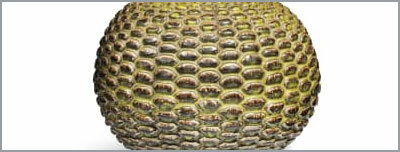
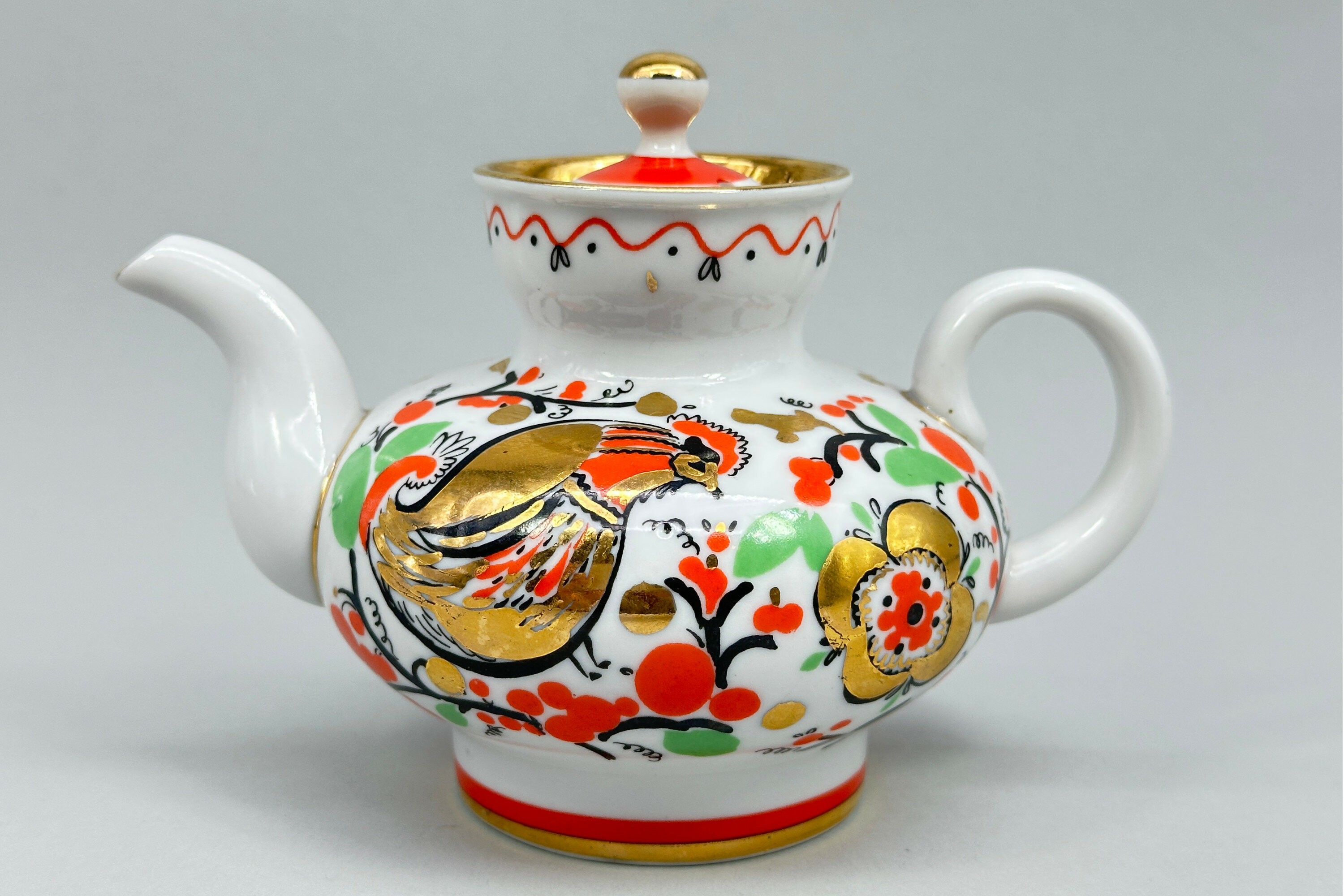
Lomonosov Teapot decorated Cockerels, late C20th
Price: £45
Lomonosov Teapot in the form of a Samovar, late C20th
Price: £75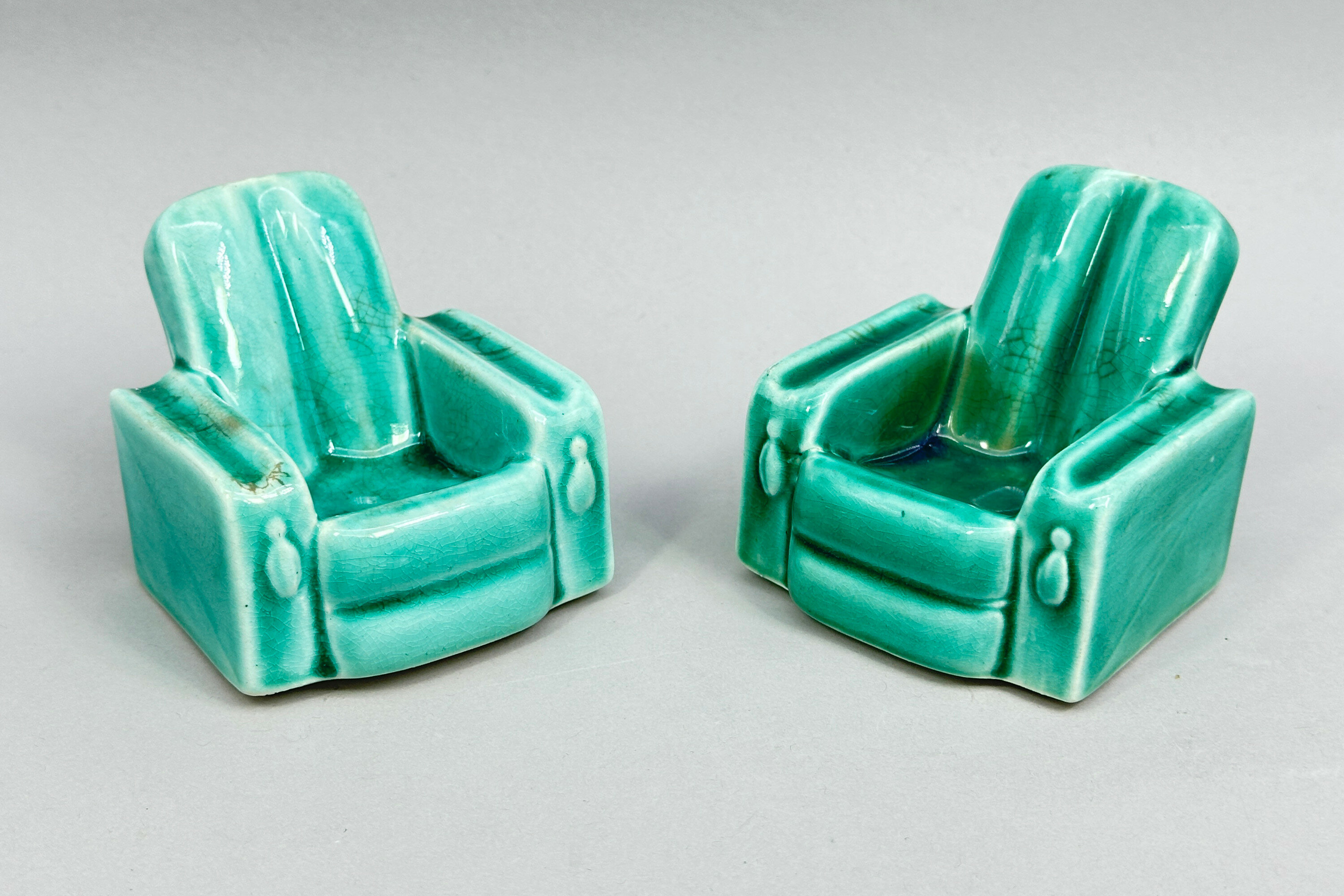
Pair of Vintage Art Deco style armchair Pipe Rests, English c1930
Price: £55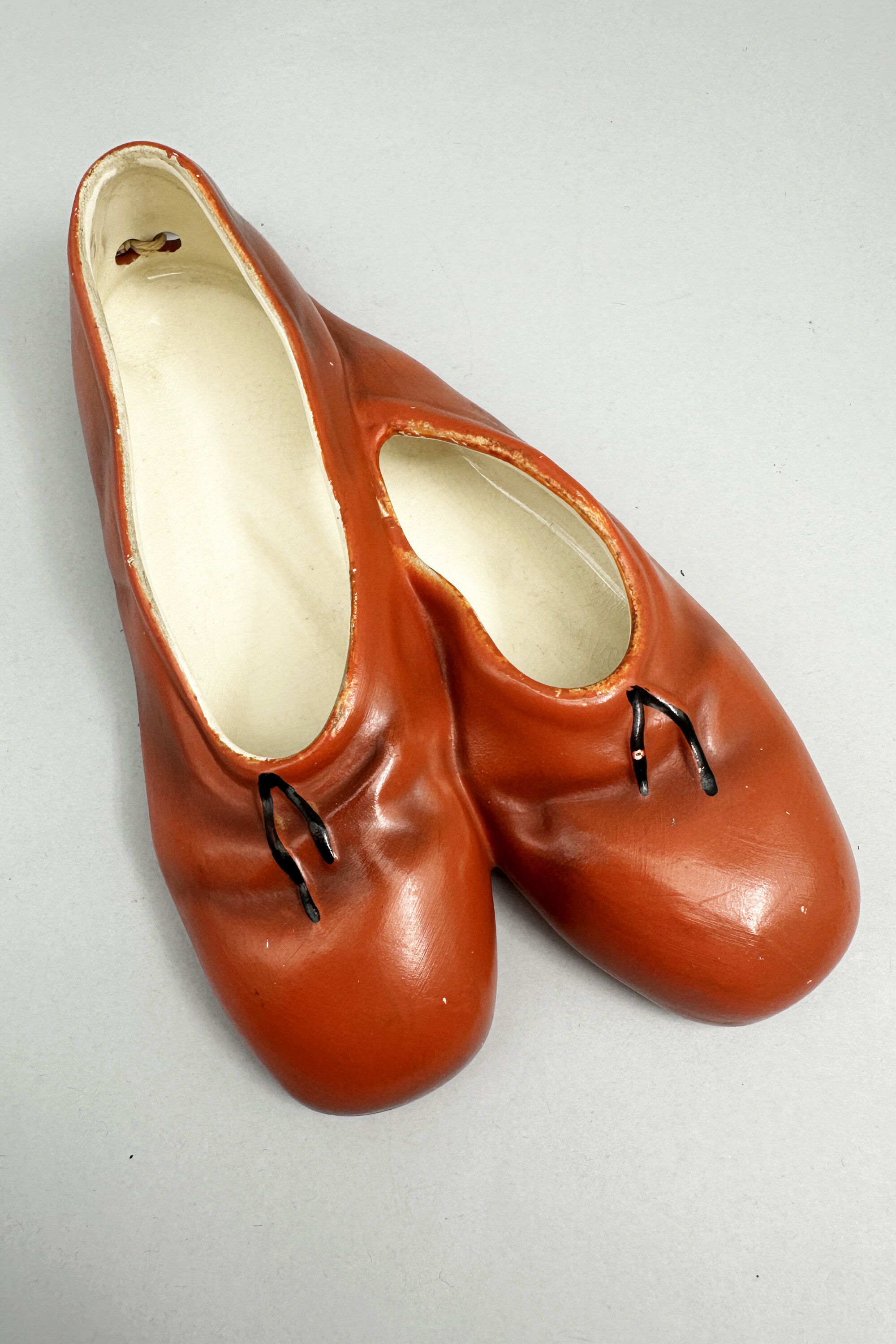
Pair of Brentleigh Ware Wall Hanging Ballet Shoes, 1930s
Price: £35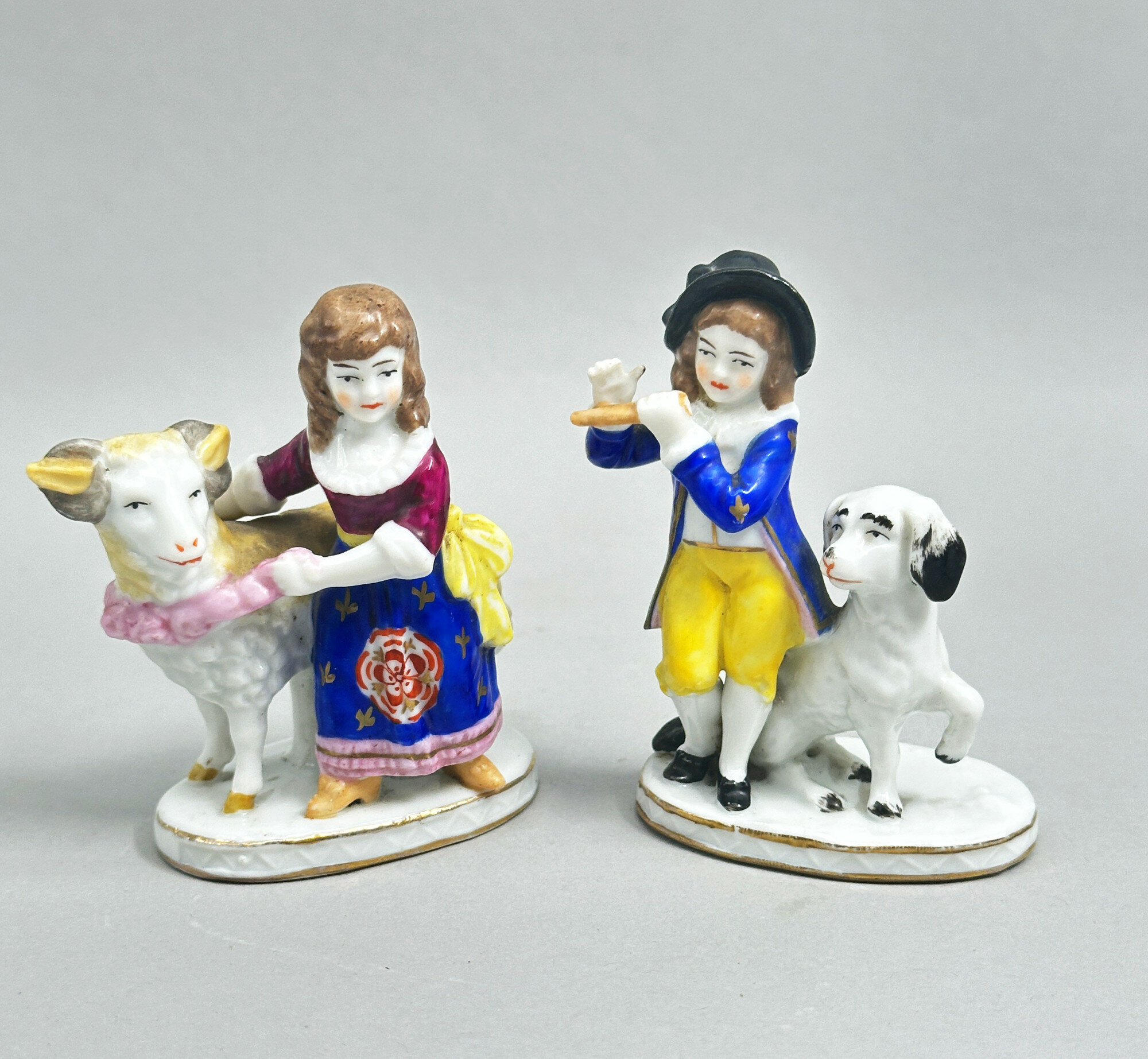
Pair of Chelsea style Figures of a Country Couple, probably Samson late C19th
Price: £55
Art Deco Style Ceramic Jug with Floral Handle, probably 1930s
Price: £35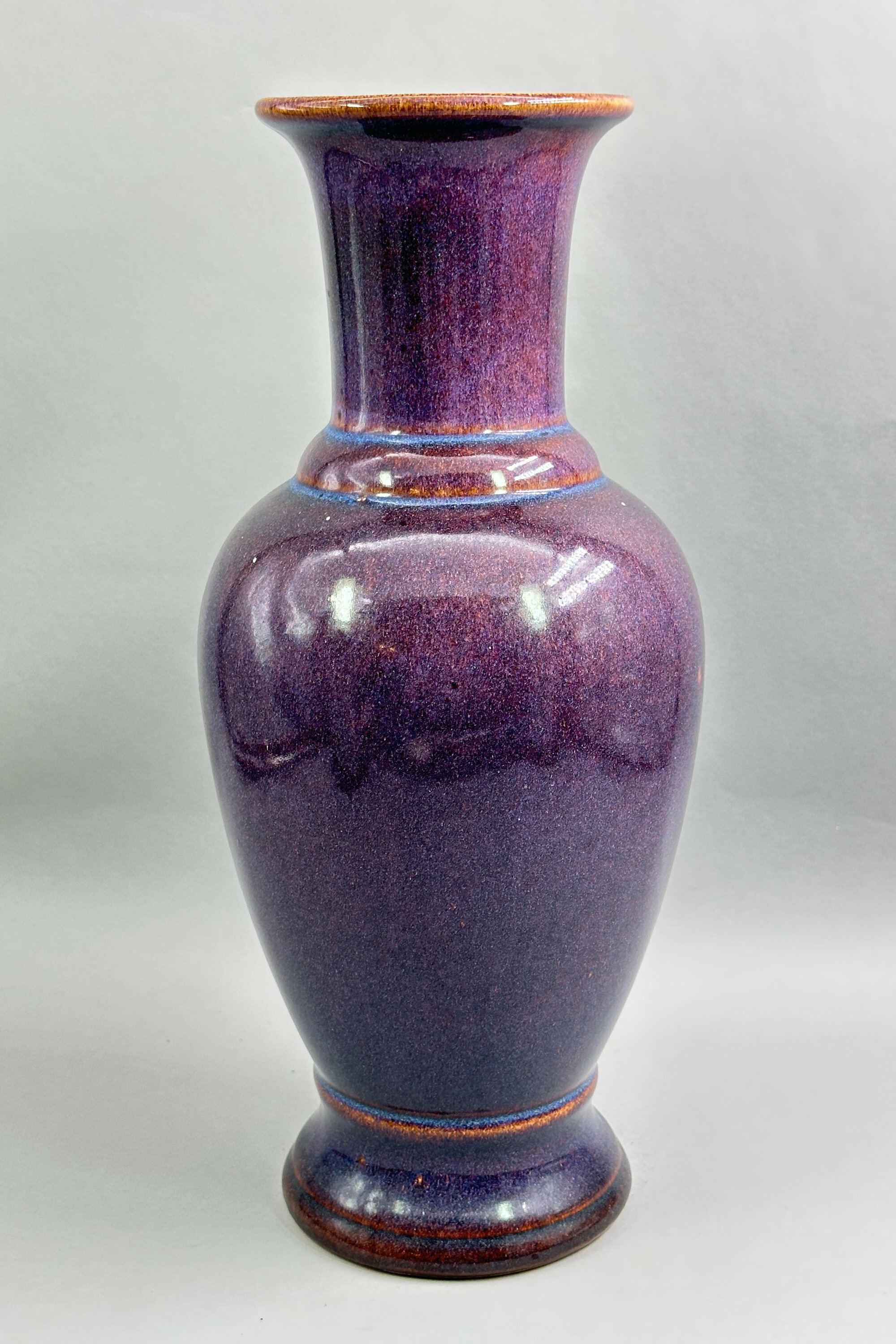
Oriental Style Vase, West German Pottery, possibly Scheurich, late C20th
Price: £45
West German Bay Keramik Pitcher with stylised floral designs, late C20th
Price: £55Founded by Eduard Bay in the 1930s and based in Ransbach Baumbach in the heart of the main West German pottery producing region, Bay Keramik grew to be one of the most prolific producers of ceramics in the ‘West German’ style and continued production into the 1990s. This piece retains its original paper label and the format of this allows dating to the 1970s/1980s. The jug has almost a slightly rustic feel and recalls much earlier German ceramic items. The numbers on the base indicate the form number but it has not been possible to identify this.

Yellow ground Bursley Ware Dragon Bowl by Frederick Rhead, circa 1920
Price: £55

Chinese style Vase and Cover decorated with ladies and courtiers in a garden scene, C20th
Price: £55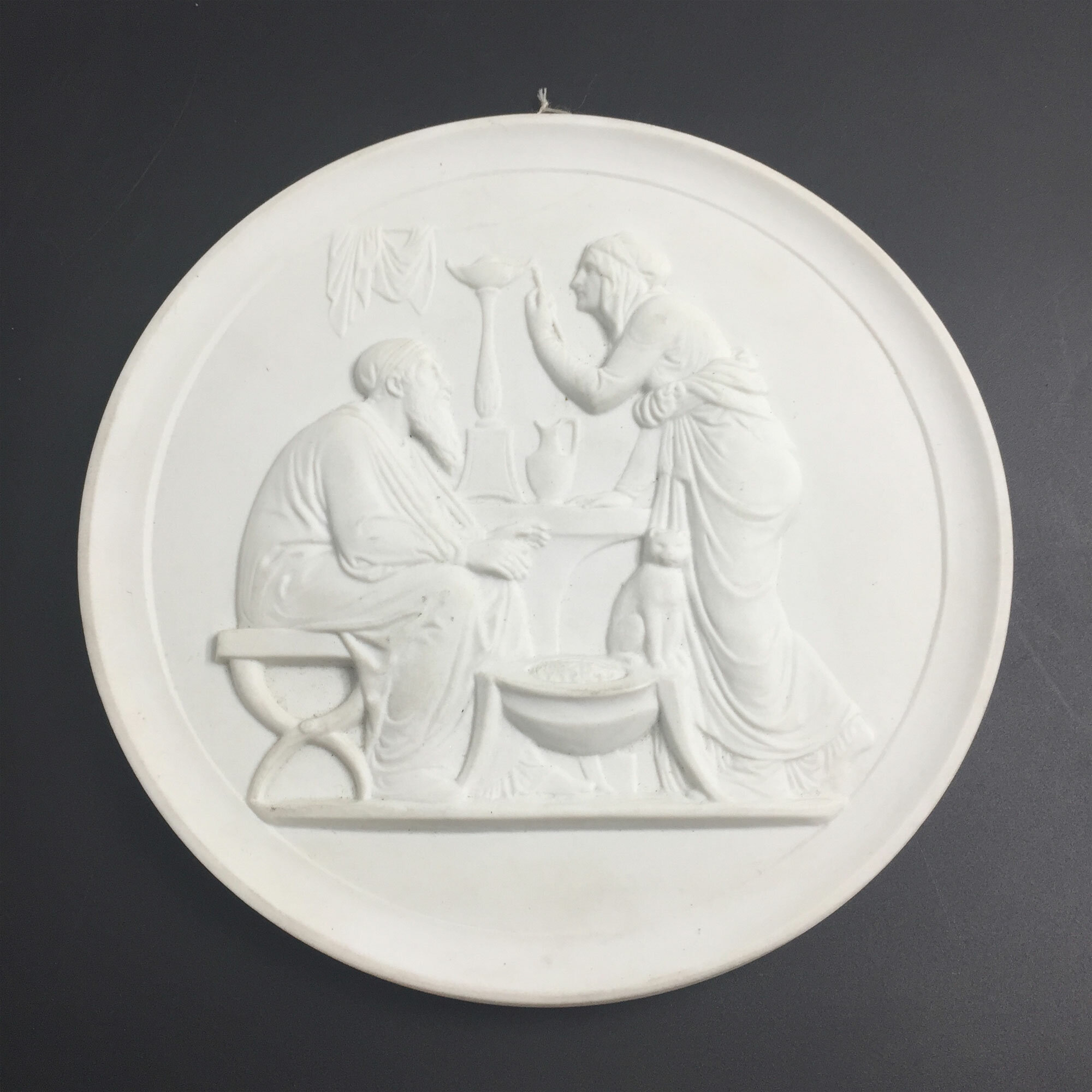
Pair of bisque relief plaques by artist Bertel Thorvaldsen. Royal Copenhagen 1969 - 74
Price: £40Bertel Thorvaldsen (born Nov. 19, 1770, or Nov. 13, 1768, Copenhagen, Den.—died March 24, 1844, Copenhagen), sculptor, prominent in the Neoclassical period, who was the first internationally acclaimed Danish artist. Prominent in Roman intellectual and artistic circles, he influenced many emerging artists from Europe and the United States. Most of Thorvaldsen’s most characteristic sculptures are reinterpretations of the figures or themes of classical antiquity. The Alexander frieze of 1812 in the Palazzo del Quirinale, Rome, modeled in only three months in anticipation of a visit by Napoleon, is an example of the feverish energy with which he could at times work. Religious sculptures include the colossal series of statues of Christ and the Twelve Apostles (1821–27) in the Vor Frue Kirke in Copenhagen. He also made numerous portrait busts of distinguished contemporaries.

West German Keramik Jug with drip glaze, second half C20th
Price: £45
A Pair of Royal Doulton Ewers, marked, early C20th
Price: £150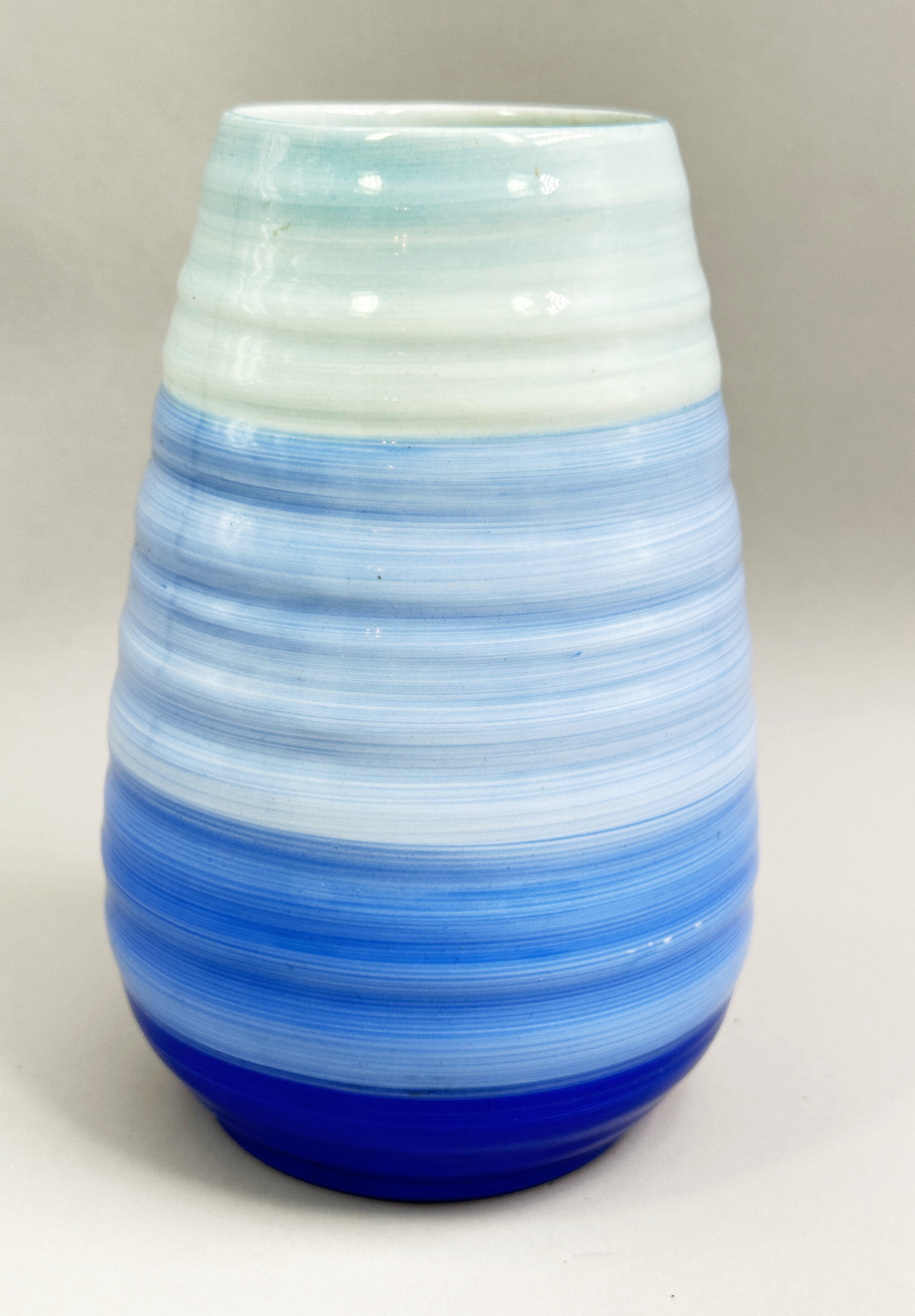
Shelley Harmony Ware Vase glazed in blue, 1930s
Price: £45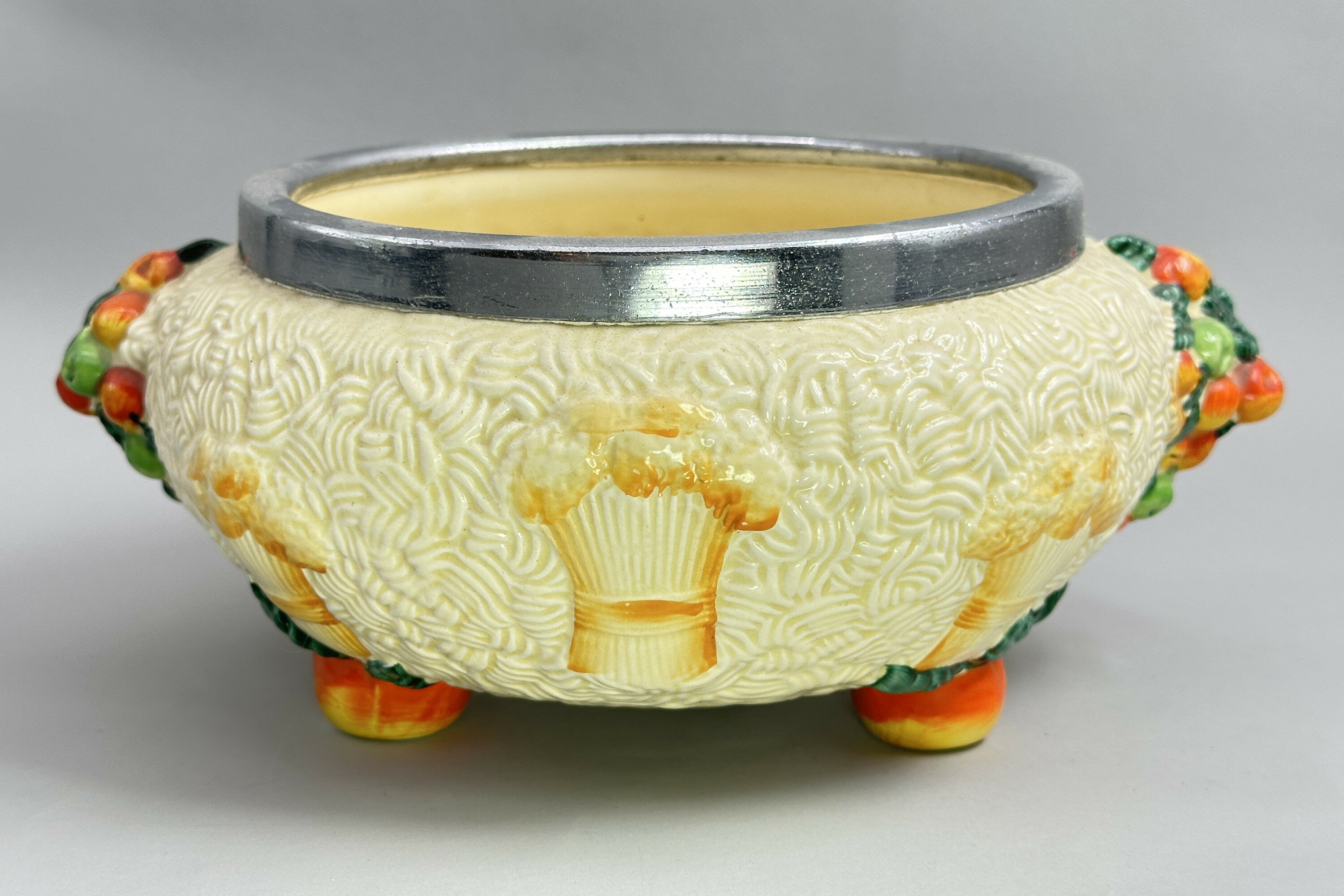
Clarice Cliff Celtic Harvest Centrepiece Bowl, marked, 1930s
Price: £55

Pair of Royal Doulton Spill Vases with gilt decoration, 1920s
Price: £180
Ceramic and Bronze figure of a Blue Tit, Albany Worcester, late C20th
Price: £35
Doulton and Slaters Patent Jardiniere circa 1890
Price: £750The Doulton factory began production in 1815, first at Vauxhall and later moving to Lambeth. In 1882 it opened an additional factory at Burslem, Stoke on Trent in the centre of the English pottery. Known at first mainly for utilitarian works it began to develop decorative wares more extensively in the 1860s and soon gained a reputation for its distinctive designs. As the mark indicates, this piece was made at the Lambeth factory and the absence of ‘England’ in the Doulton mark, which has the typical design of interlocking ‘D’ at its centre, indicates that it dates to before 1891. The decorative technique, employing impressed designs was known as ‘Chine’ ware and protected by the patent ‘Doulton and Slaters Patent’ which is clearly marked underneath. Pieces of linen, lace, net or other fabrics were pressed onto the unfired soft clay shortly after potting, leaving a corresponding pattern behind. This piece has elaborately modelled lotus strands in addition as well as gilt flower heads, an unusual combination which does not seem to often occur. On the base are found stamped numbers and letters which should indicate the pattern number and artist decorator but it has not been possible to identify these accurately. Dating though is confirmed and this was clearly a deluxe item amongst the range of pieces produced at that time.
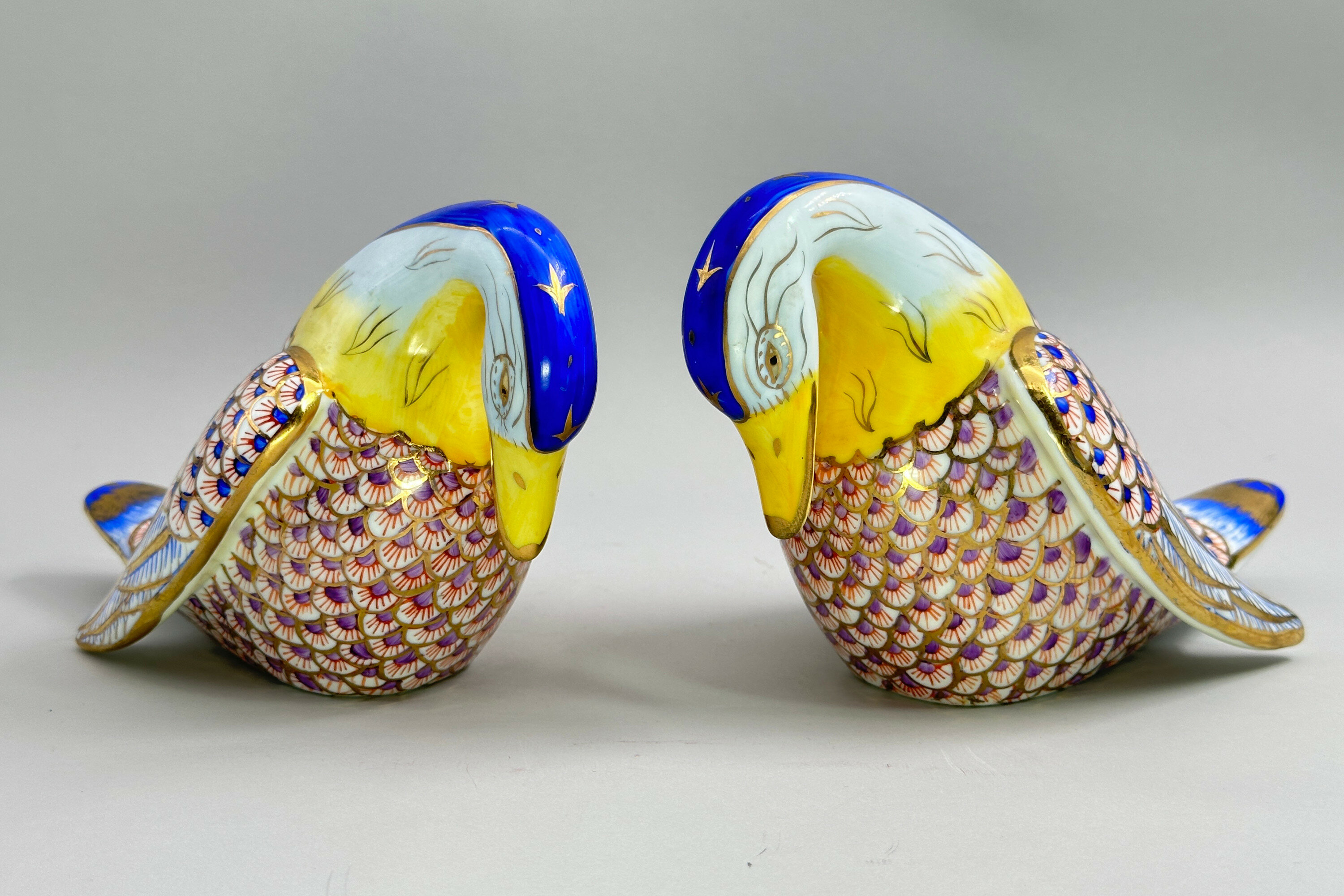
Pair of Ceramic Figures of Swans, probably continental, C20th
Price: £45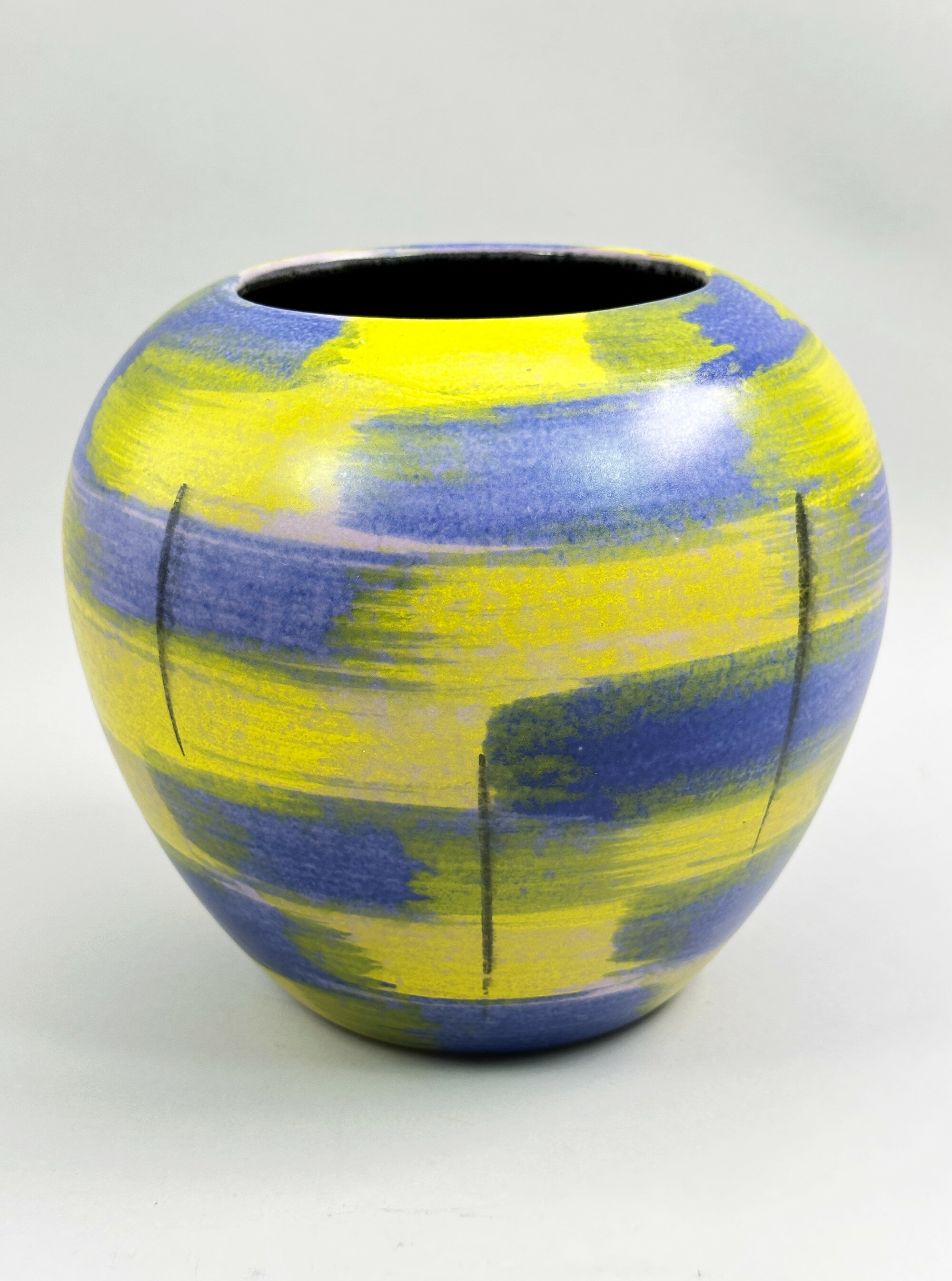
East German Ceramic Vase, VEB Haldensleben, 1950s
Price: £35The factory mark, a shallow dish superimposed over the letter 'H' inside a circle, is that of the East German pottery VEB Haldensleben. VEB stands for 'Volkseigener Betrieb', meaning a people-owned enterprise and used in relationship to the state owned workplaces in the GDR. Haldensleben is a town in Saxony-Anhalt, Germany and a ceramics factory was created there in 1945 with the nationalization of the Carstens Uffrecht plant that followed the division of Germany at the end of WWII. Halsdenleben focused primarily on the manufacture of vases. Its output tended to be of superior quality and employed more restrained glazes than those used by its West German counterparts. Upon the reunifucation of Germany in 1990, the factory was returned to its original owners, the Carstens family. The pattern number here is found on other pieces with the same shape but the abstract decoration used is quite individual and evocative of 1950s and early 1960s designs.

West German Ceramic Vase, Marei, 1970s
Price: £45While not stamped with a maker's mark, vases of this type are attributed to the West German Ceramics factory Marei which produced pieces from 1949 to 2016. Marei was the commonly used abbreviation for the firm's name which was Majolikafabrik Rheinbach Jean Fuss and Sohn. The pieces are distinguished by the use of a reddish clay but this was sometimes more brown or dark brown depending on the suppliers used. Marks are usually impressed into the base although these are often just pattern numbers, as here. Many pieces are unmarked and some are stamped 'MADE IN GERMANY' or 'W.GERMANY'. The pattern number here is '7104'and is found on similar pieces with the same shape but different decoration. This vase was probably made in the 1970s and is typical of the striking designs the firm produced.

Pair of French Blue Ground Square Vases Choisy Le Roi, late C19th
Price: £45
Art Pottery Vase with Geometric Motifs, C20th
Price: £55The style of decoration suggests Art Nouveau designs but there are no obvious parallels. Continental manufacture seems likely, perhaps France or Germany.

Ceramic Model of a Fish, Jema Holland, signed, 1950s/1960s
Price: £30The Jema factory in Holland was started by two brothers, Jelis Mager ( born 1912 in Rotterdam, Netherlands) and his brother Johan Willem Mager (born 1919 also in Rotterdam) both living in Maastricht who took over an existing ceramics factory, founded originally by J.Meussen, in 1942 and traded together in a partnership which was dissolved in 1955 when the firm JEMA KERAMISCH ATELIER N.V. (jema ceramic studio; the first JE standing for Jelis and MA standing for Mager) was created under a new agreement between them. Ceramic products of many types were produced with figurines a speciality and the business continued until 1984 when it became insolvent and closed its doors.
Most of the pieces seem to have been marked, usually with an impressed script as here indicating the factory itself and the model number of the piece. For modest decorative items the quality of the manufacture is of a high standard as can be seen in both the modelling and the glazing of this piece. Their animal figurines were immediately approachable and provided modest but amusing items of decoration.
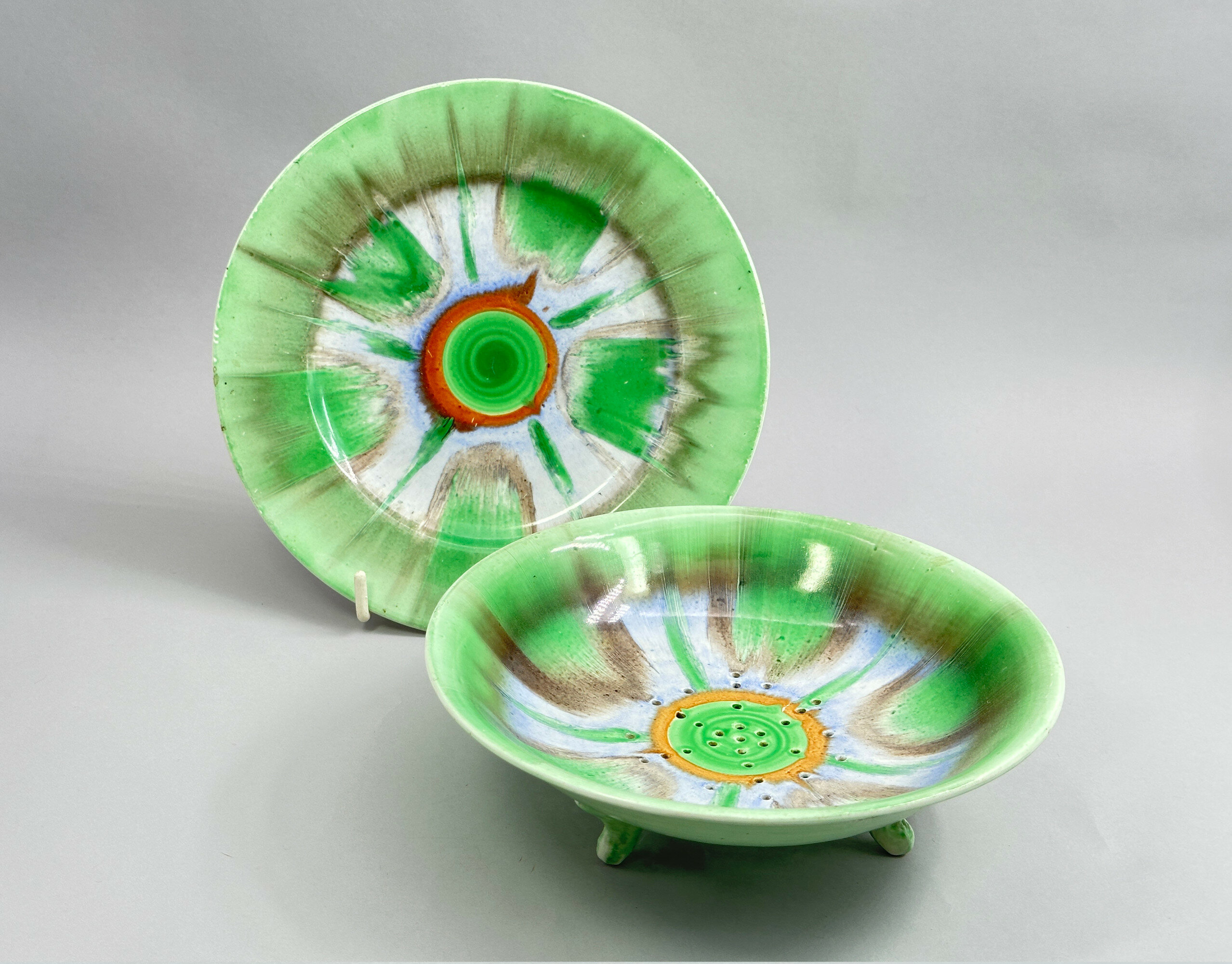
Shelley Harmony Ware Drip Glaze Watercress Bowl and Stand, 1930s
Price: £35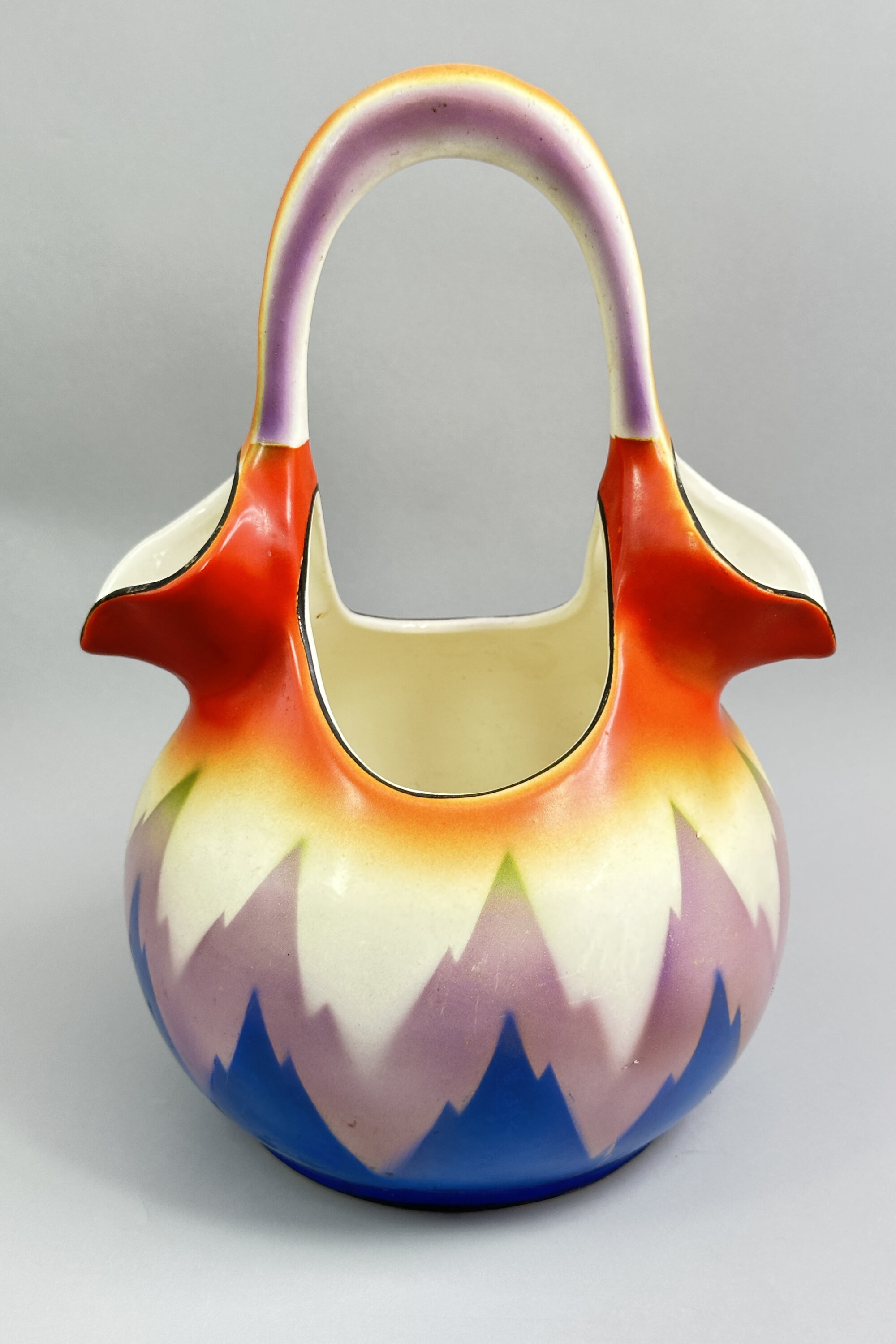
Rare Ditmar Urbach Art Deco Pitcher, Czech 1930s
Price: £250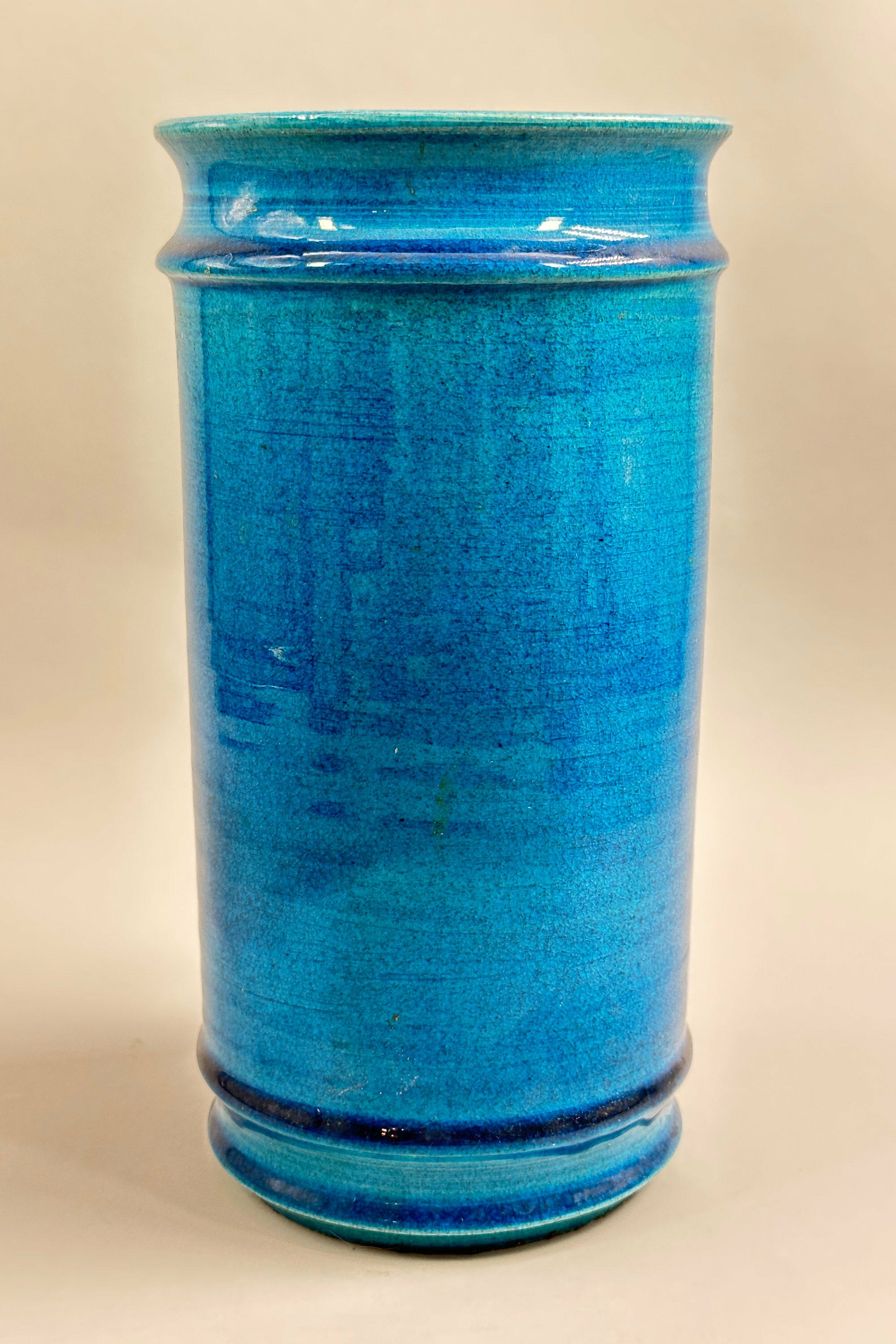
Cylindrical Vase, Herman Kähler, HAK, blue glazed stoneware, 1950s
Price: £250
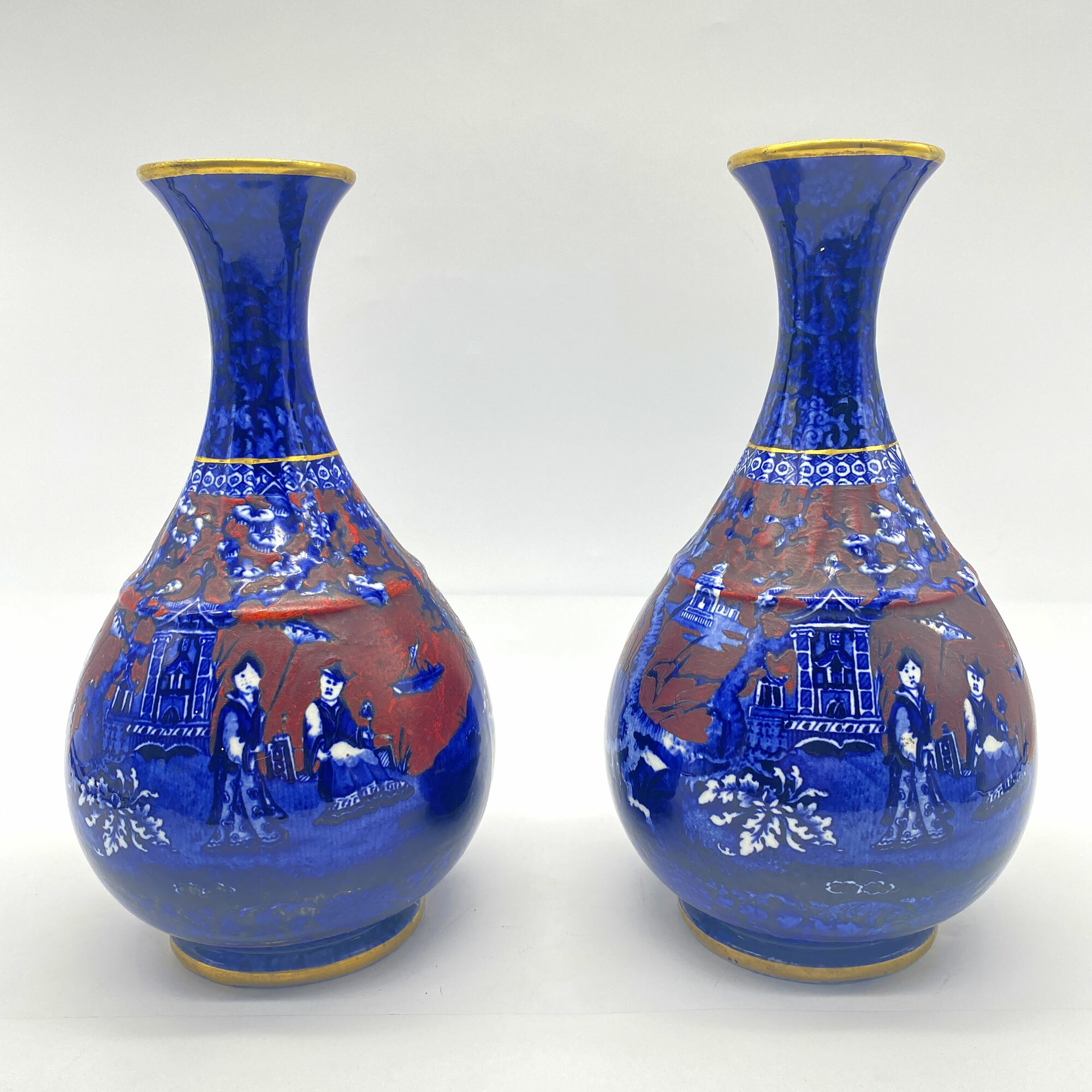
Pair of J Kent Chinoiserie Foley Ware Vases c1920s
Price: £75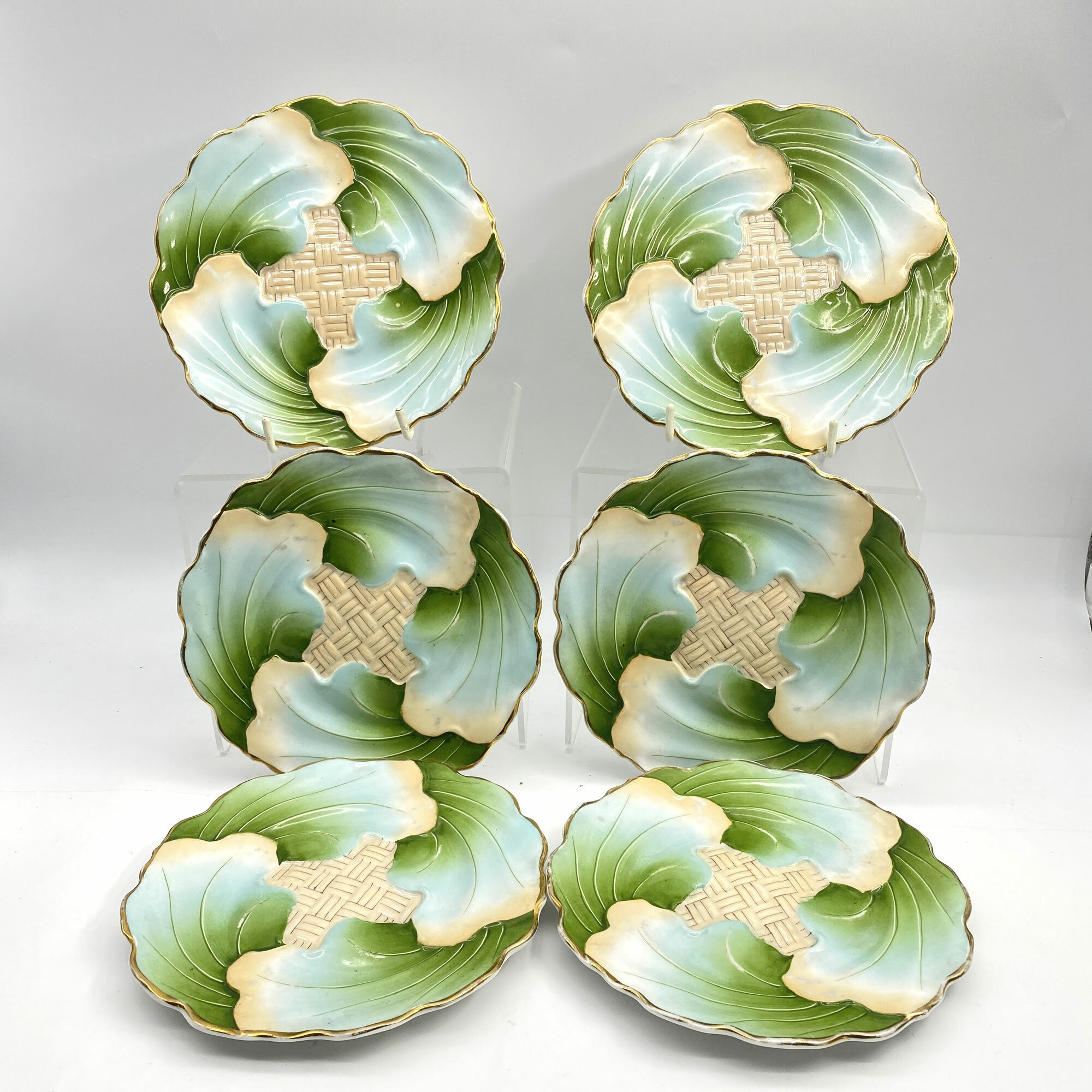
Set of 6 small Art Deco style plates by C.T. Altwasser, Silesia, 1920s/1930s
Price: £75
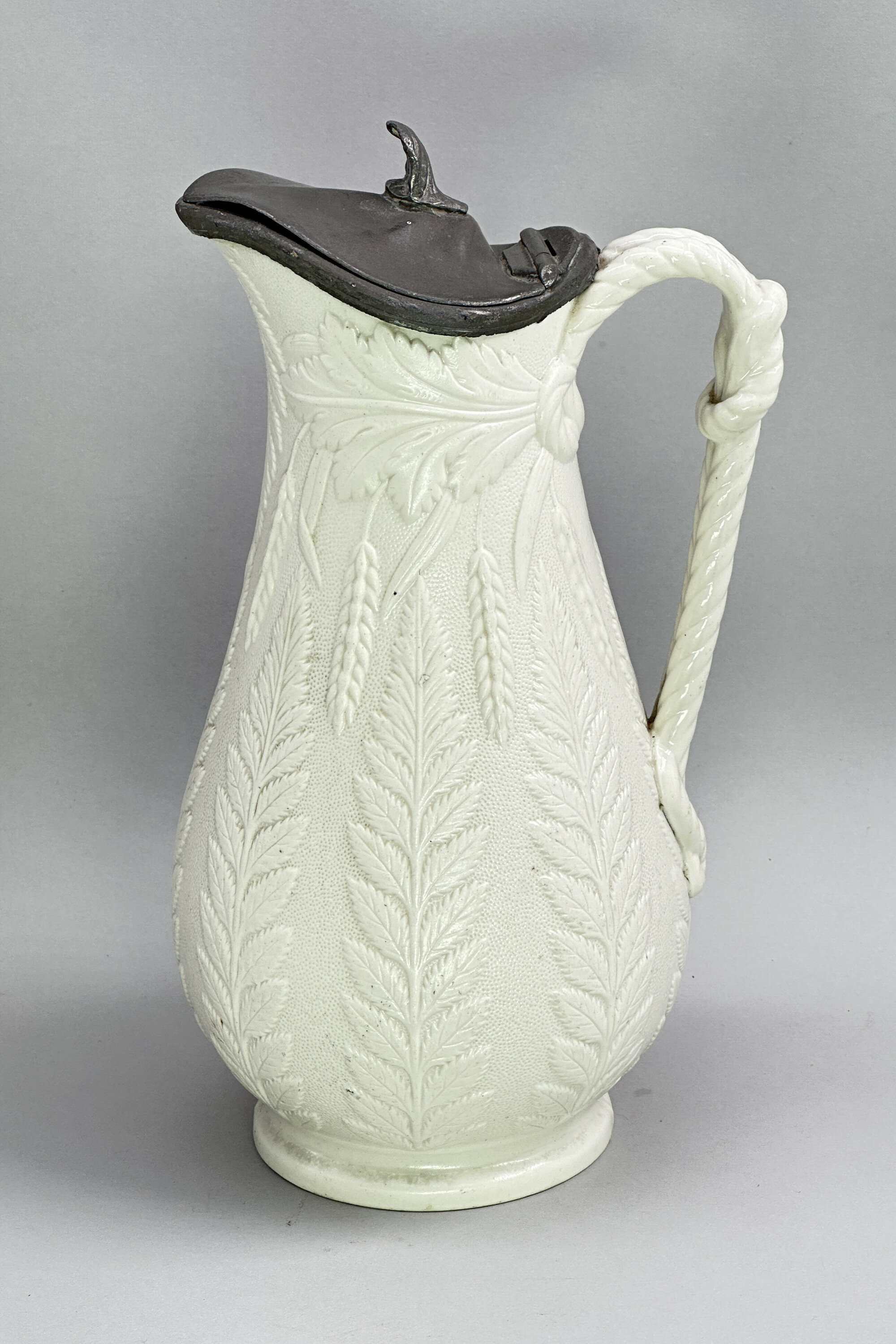
Antique English Staffordshire pitcher, William Brownfield and Sons, circa 1860.
Price: £55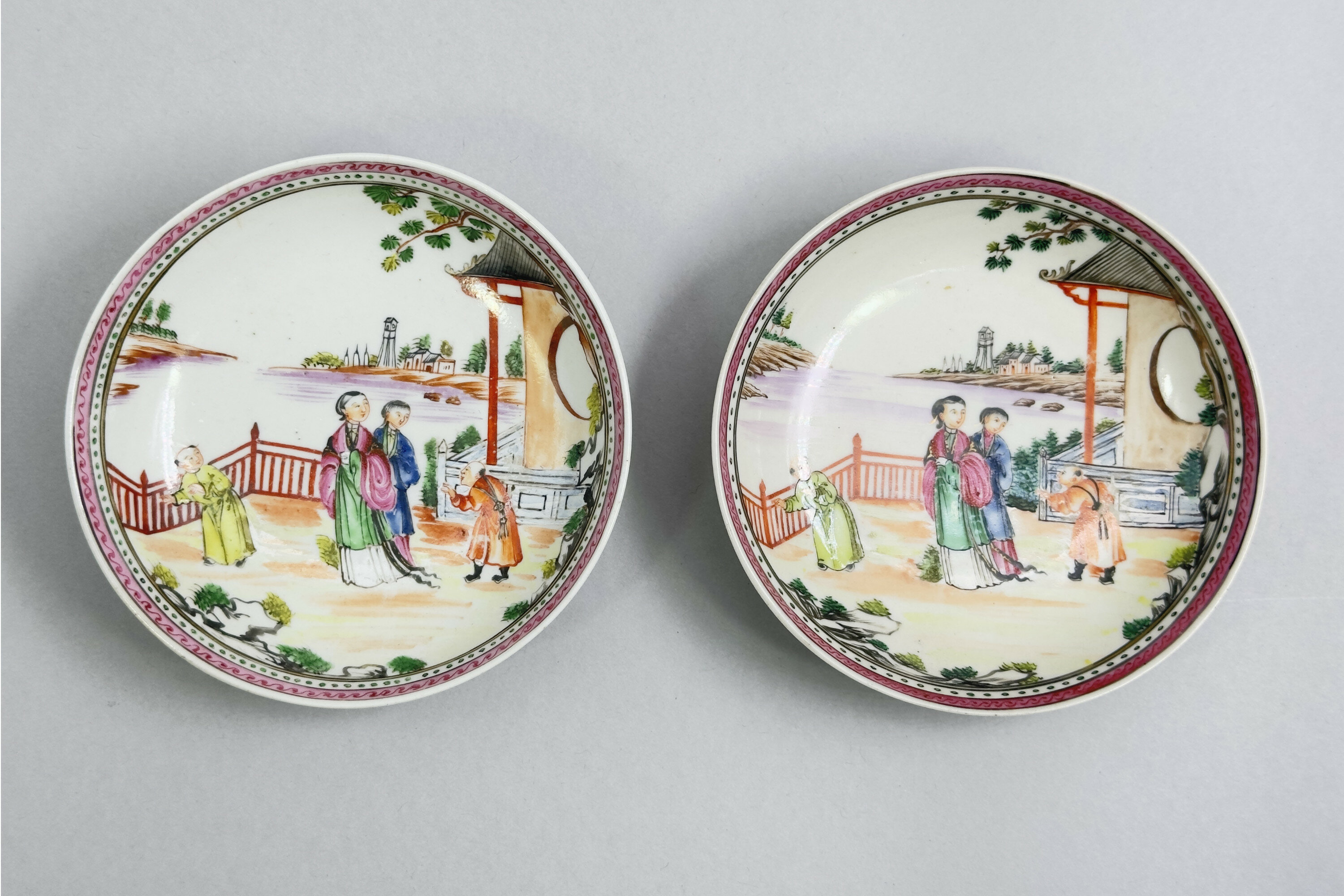
Pair of Worcester Saucers with Chinoiserie Decoration circa 1780
Price: £45While close to the Chinese originals, many features indicate European and indeed English manufacture, in particular the drawing of the ladies’ heads, the palette of colours used, the borders employed and, most importantly, the glaze and paste of the reverse. The most likely producer here was the Worcester factory whose ‘Mandarin’ pieces were well known and a circa date in the second half of the eighteenth century is reasonable. The saucers would have come from a small tea service with matching bowls and various serving items, including, of course, a teapot. Not so likely to be used now, they provide an elegant example of the vogue for Chinoiserie in England at the time.
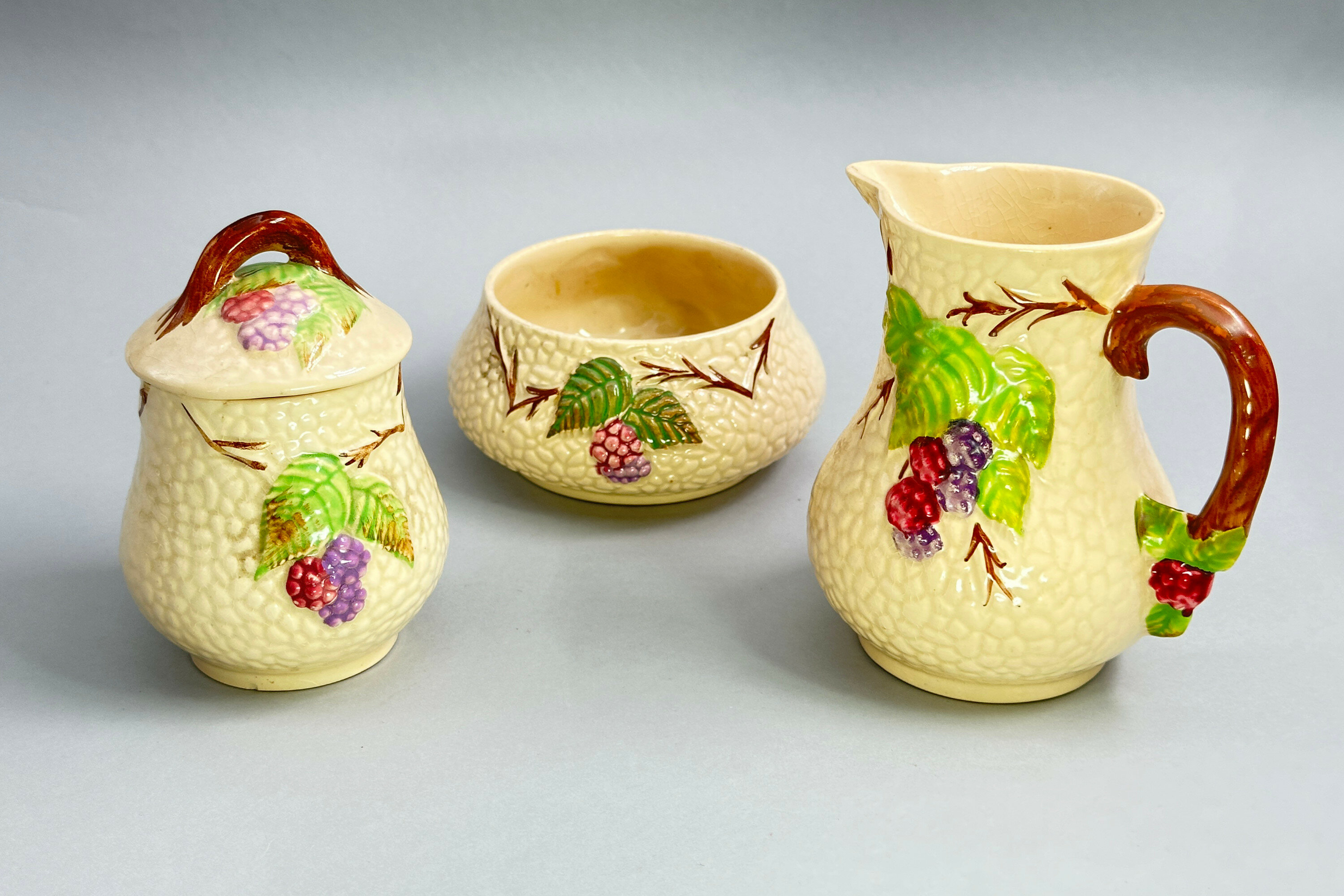
Set of three Wade Bramble Pattern teaware items, 1950s
Price: £25Wade Ceramics Ltd was a manufacturer of porcelain and earthenware, headquartered in Stoke-on-Trent, England. Founded in 1867, it was run by various members of the Wade family until the death of George Anthony Wade in 1987 after which there was a succession of management buyouts. Despite substantial investment in 2009, the firm eventually went into administration in 2022. Wade produced a wide variety of ceramics, including the well known Wade Whimsies animal figurines. A pair of Art Deco green glazed ‘salts’ are also included in this sale. The ‘Bramble’ design was created in the 1950s and a wide variety of tea service shapes were produced in the pattern. Collectors today can attempt to assemble examples from the whole of the range, towards which these three pieces might provide some assistance.
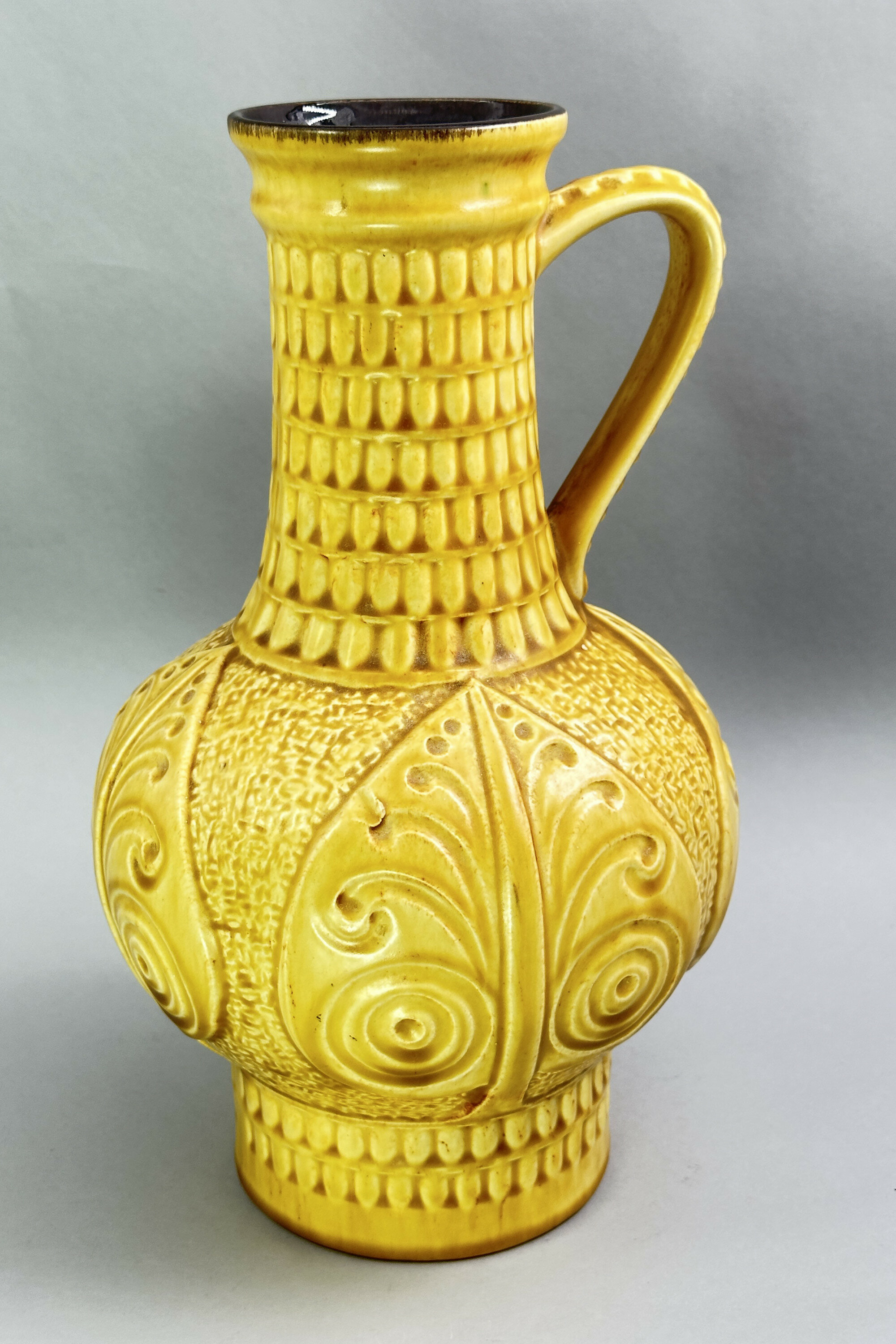
Bay Ceramic Ewer No 268-30, West Germany, 1960s
Price: £55Bay Ceramics was founded by Eduard Bay in the 1930s and based in Ransbach Baumbach, the heart of the main West German pottery producing region. Their productions included vases in a wide variety of shapes and designs which continued in production until the 1980s. Bodo Mans was amongst their most famous designers working in the 1950s and 1960s. He seems to have concentrated on organic semi abstract designs and ewers in this form, with the same pattern number but in a variety of different glazes, are attributed to him. This monochrome mustard glaze seems particularly attractive and complements the design very successfully producing a striking and decorative item which might enhance a wide variety of interior settings.
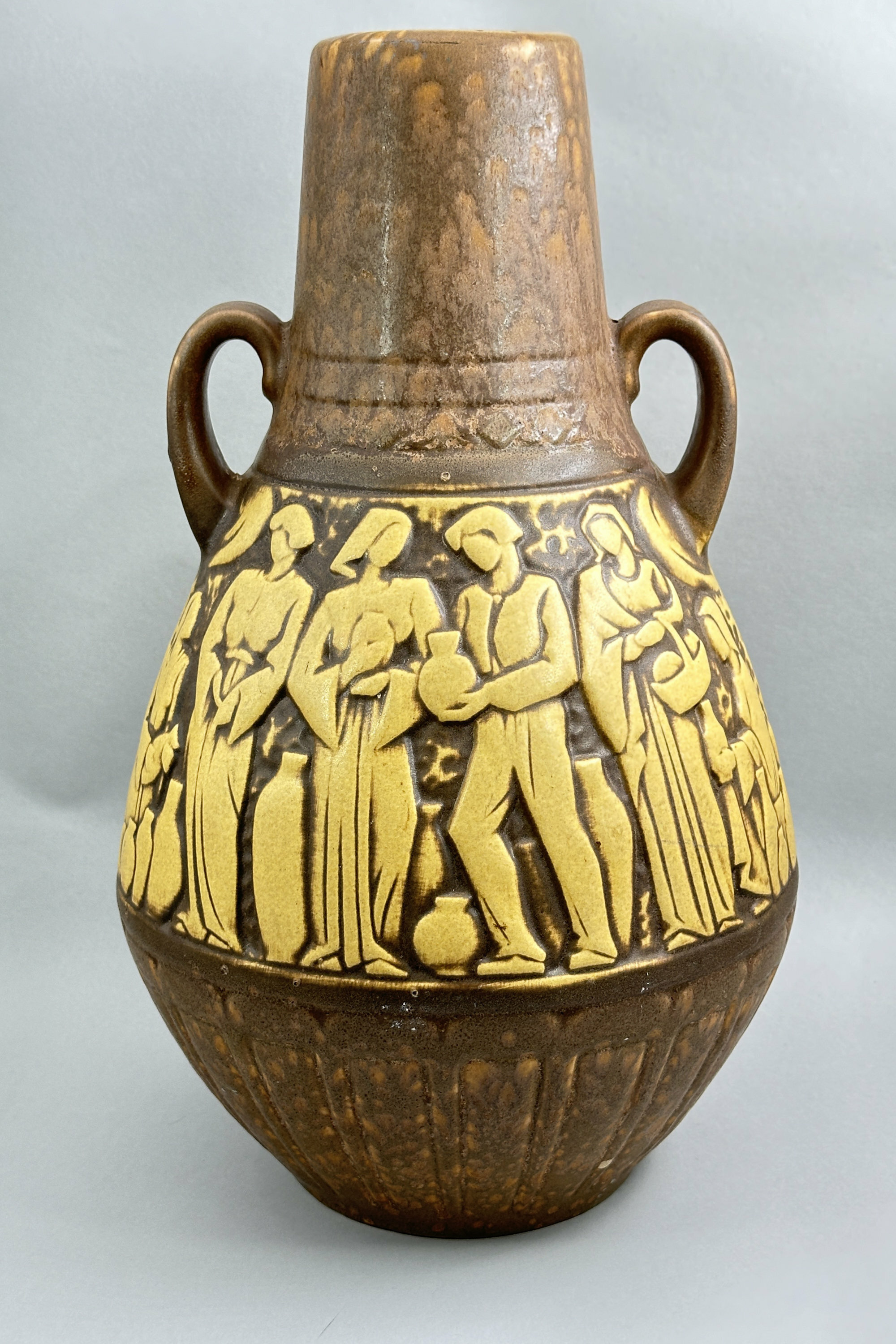
West German Scheurich Vase, Market Scene Pattern, 225-46, 1970s
Price: £150In 1954, Alois Scheurich founded the Scheurich Keramik factory, having been in partnership before then in the firm ‘Scheurich and Greulich’ (S&G) since 1927. While founded later than many of its competitors, Scheurich grew to become the principal exporter of West German ceramics through until the 1980s and beyond, making vases in a wide variety of shapes and designs. Made in the 1970s, this vase has a retrospective feel recalling Soviet designs from the 1920s and 1930s. The figures seem to be grouped in a stylised market scene with various pitchers containing perhaps wine or oil. The symbolism is unclear unless it refers to the vase itself which could be regarded as recalling the form of the Greek amphora. But whatever the ‘meaning’ we have an imposing and unusual decorative item here which stands rather apart from many of the other pieces produced by its manufacturer.
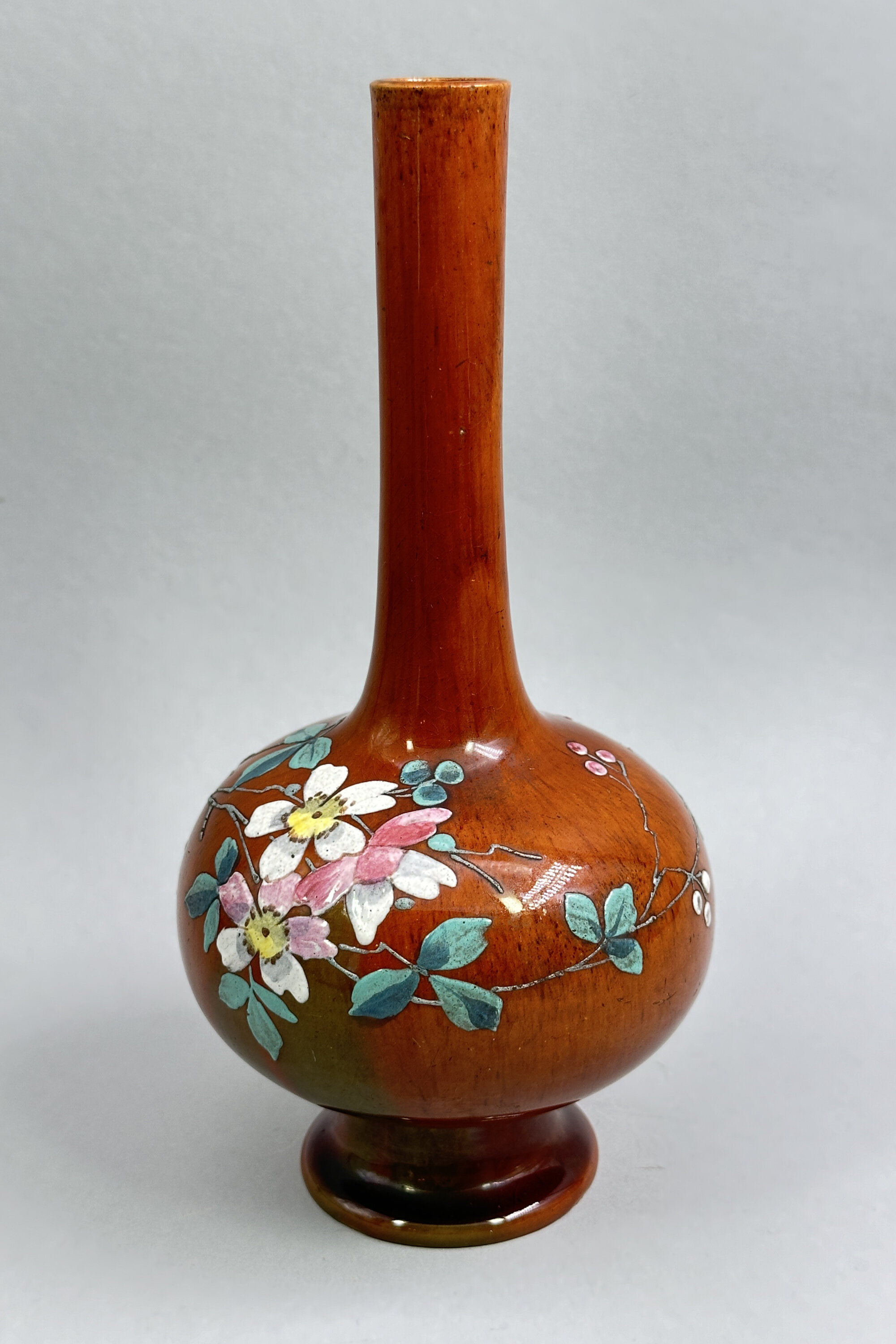
Terracotta Glazed Bottle Vase with floral enamel decoration, Watcombe Pottery, circa 1900
Price: £45Pieces combining glazed terracotta with polychrome enameling were one of the designs produced by the well known Watcombe pottery based in Devon. Production commenced in the mid 1860s when a fine red Devon clay was discovered in the grounds of Watcombe House near Torquay, prompting its then owner G. P. Allen to establish the Watcombe Terracotta Clay Company off Teignmouth Road, St. Marychurch in 1869. Classical styles of the period like terracotta busts, figures, urns and jugs were produced first, followed by terracotta glazed pieces some in the style of the famous designer Christopher Dresser. Not all of the pieces were marked and the appearance of ‘Watcombe Porcelain’ on some of their wares seems to post date the first years of production. Various mergers followed and the range of designs developed, adapting to changing tastes, but finally the business was forced to close its doors in 1962.
While the decoration is typical of Watcombe, the shape is typical of Dresser and also loosely follows a Chinese shape as did so many of his pieces. Allowing for the fact that the Devon potters introduced their own individual ‘twist’, one example of the Dresser prototype for this piece is included in the collection held by the Metropolitan Museum in New York. Watcombe, in common with other potteries at the time, aimed to produce pieces which, while they followed the ‘best’ designs were more accessible to a general audience. This vase is in no way inferior to the ‘real thing’ and maintains a charm of its own.
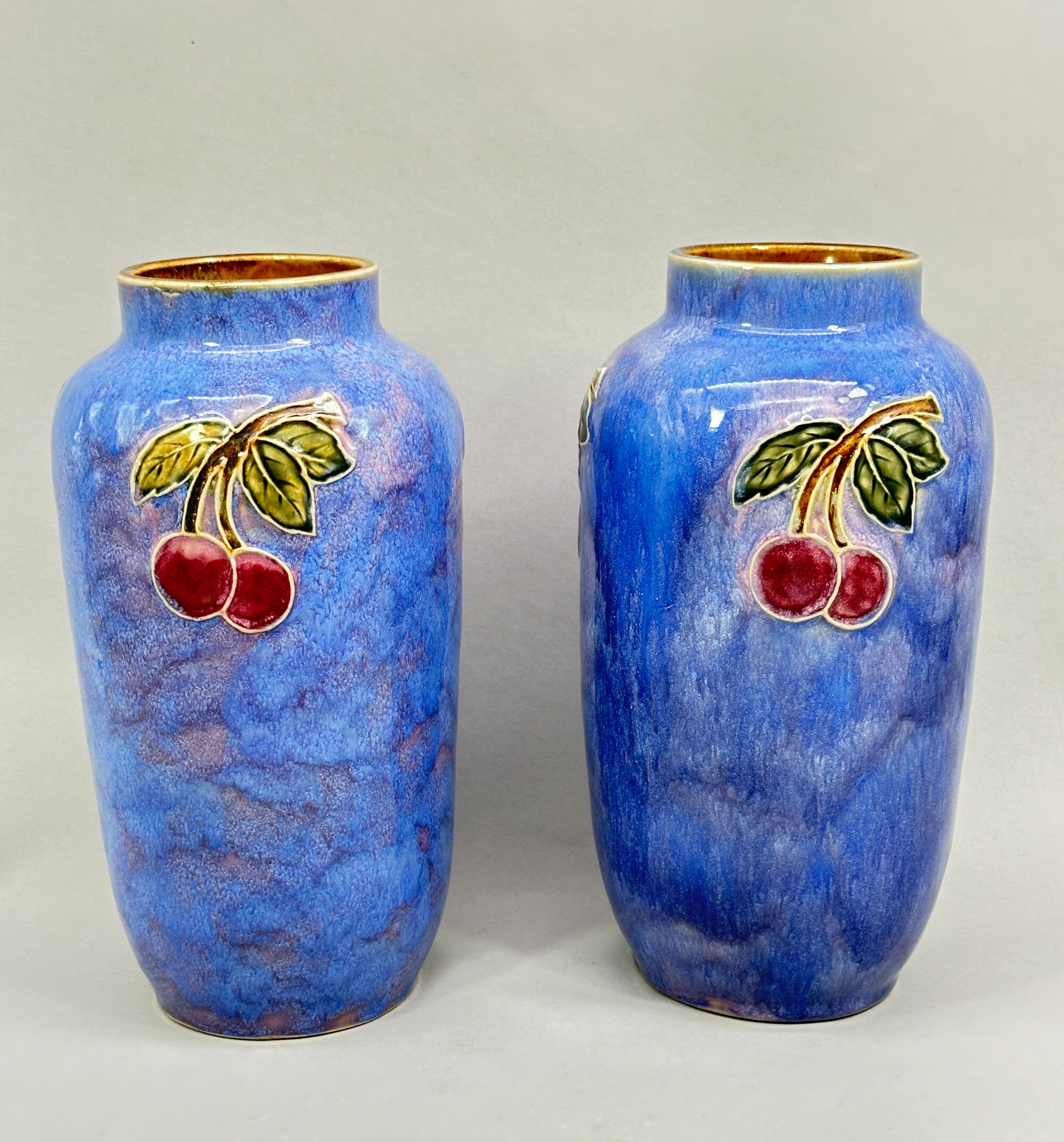
Pair of Royal Doulton Vases decorated Cherries, early C20th
Price: £95The mark for Doulton is one of the standard impressed 'Royal Doulton England' marks where the lettering forms part of a circle combined with three thick lines and the centre is filled with four interlocking 'D's. The addition of a lion but not with the usual accompanying crown allows a fairly precise dating to between 1923 and 1927 which matches with the pattern number ‘8546’, one of the range of numbers used between 1924 and 1927. The artist’s signature cannot be identified but he/she produced a pair of vases of great skill and charm which follow the Art Deco trends fashionable at the time.
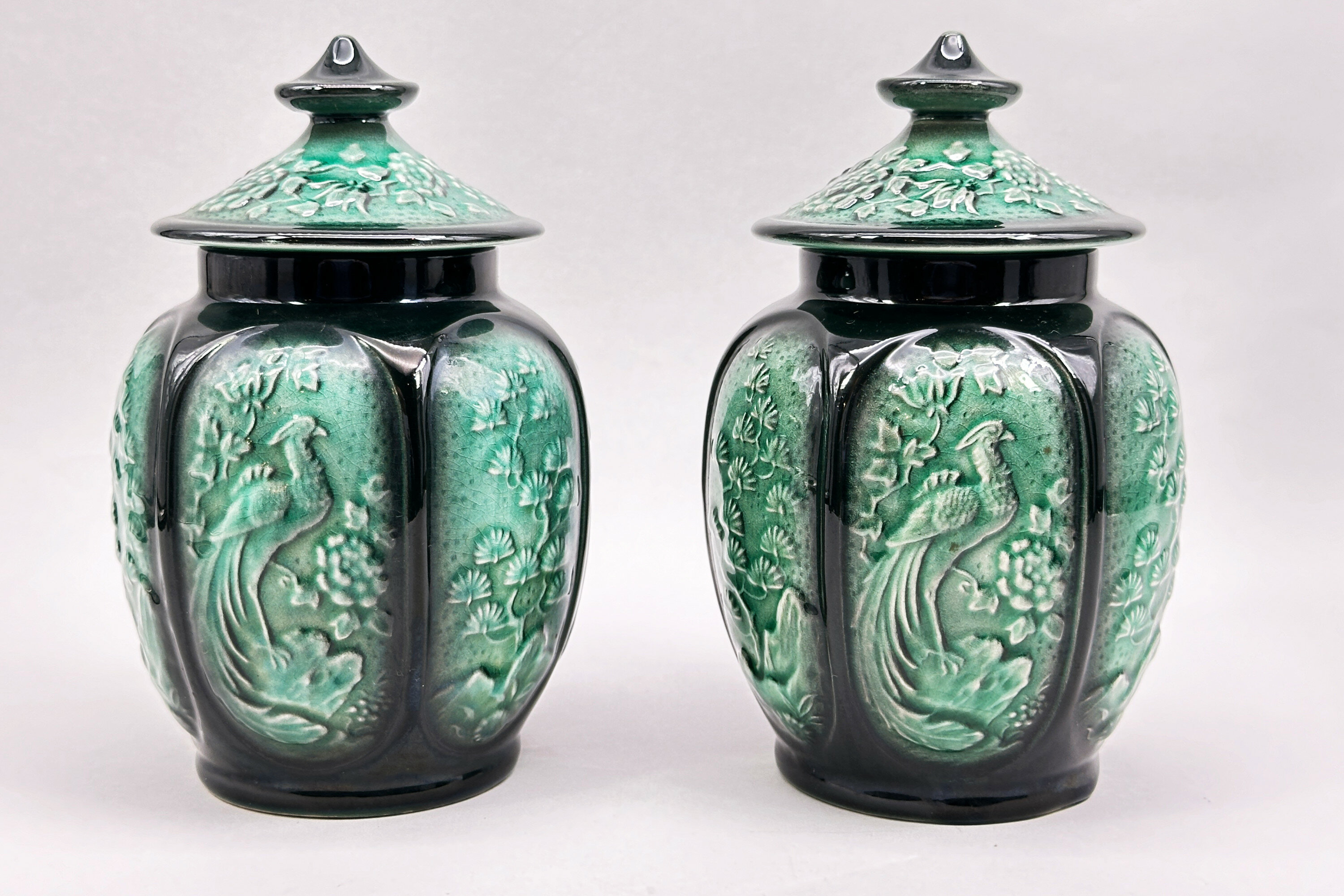
Pair of Oriental Style green glazed Sylvac Jars and Covers, circa 1960
Price: £95‘SylvaC’ (the name was written with a capital ‘C’ after registration of the trademark in 1938) was a trade name of Shaw and Copestake, a company formed by Mr. William Shaw and a Mr. Copestake around 1900. Mr. Copestake sold his shares to a Mr. Richard Hull after about six months of business and this partnership continued until Mr. Hull’s death in 1935. He was succeeded by his son, Mr. Richard Hull junior. In the following year, the business became a limited company. Various mergers and acquisitions followed and in the 1950s new premises were built and production expanded considerably continuing until the early 1980s when changing markets and increased competition forced the company into liquidation.
Sylvac were known for imaginative glazed wares, particularly animals, but this design with its reminiscences of the Orient in both form and decoration is rather more unusual and particularly pleasing. These jars were produced in a variety of colours but the combination here of green and black, loosely recalling Chinese ‘Famille Noire’, is probably the most successful.
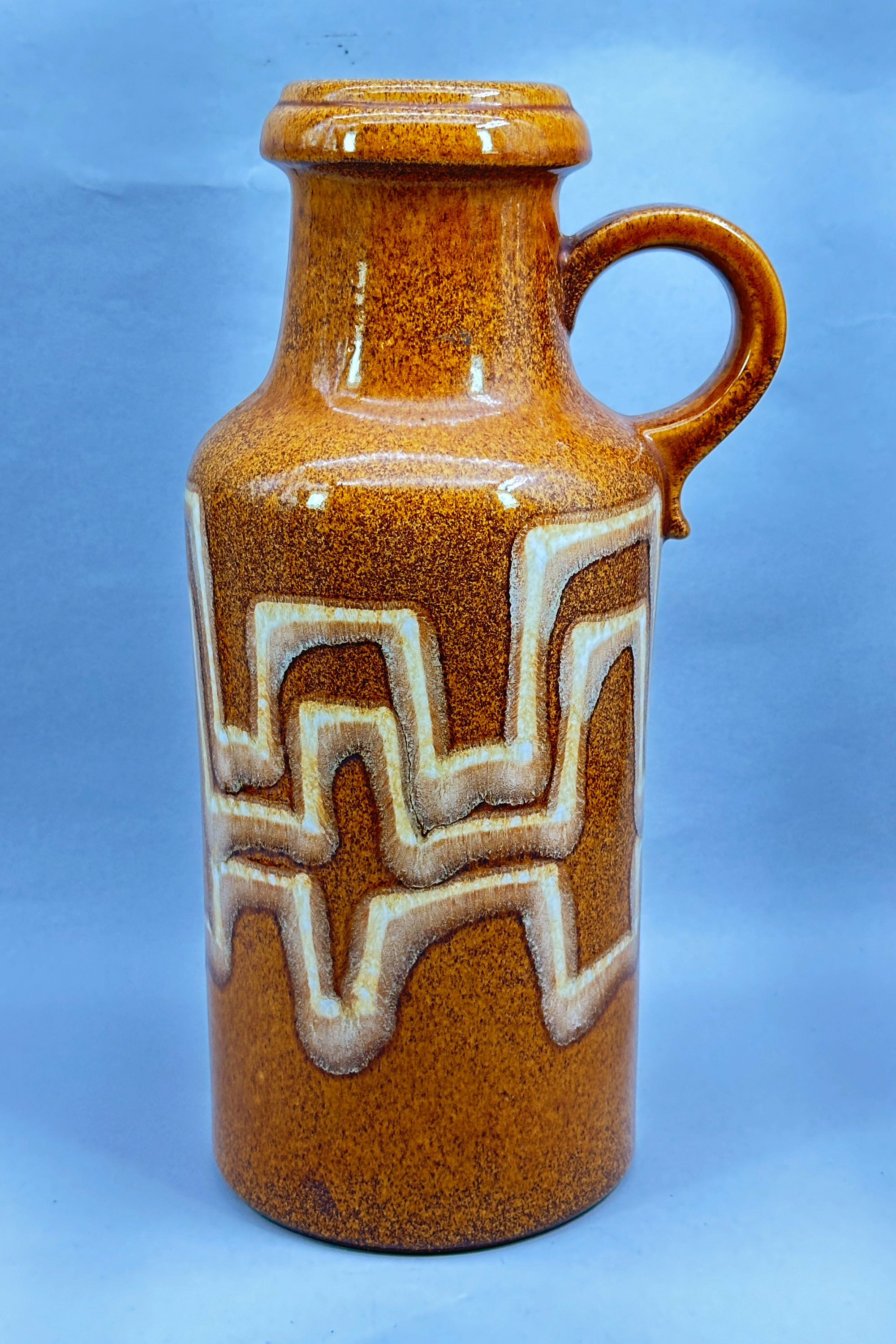
Scheurich West German Vase in Brutalist Style, late C20th
Price: £55Although not marked with their name (few pieces were until the later years of production) this vase has all the hallmarks of the Scheurich factory founded in 1954 by Alois Scheurich who had been a partner before then in the firm ‘Scheurich and Greulich’ (S&G) since 1927. While founded later than many of its competitors, Scheurich grew to become the principal exporter of West German ceramics through until the 1980s and beyond, making vases in a wide variety of shapes and designs. This piece is rather more austere than many of their productions and the clean lines of the form combined with the rather stark decoration perhaps make it particularly suitable for a contemporary interior.
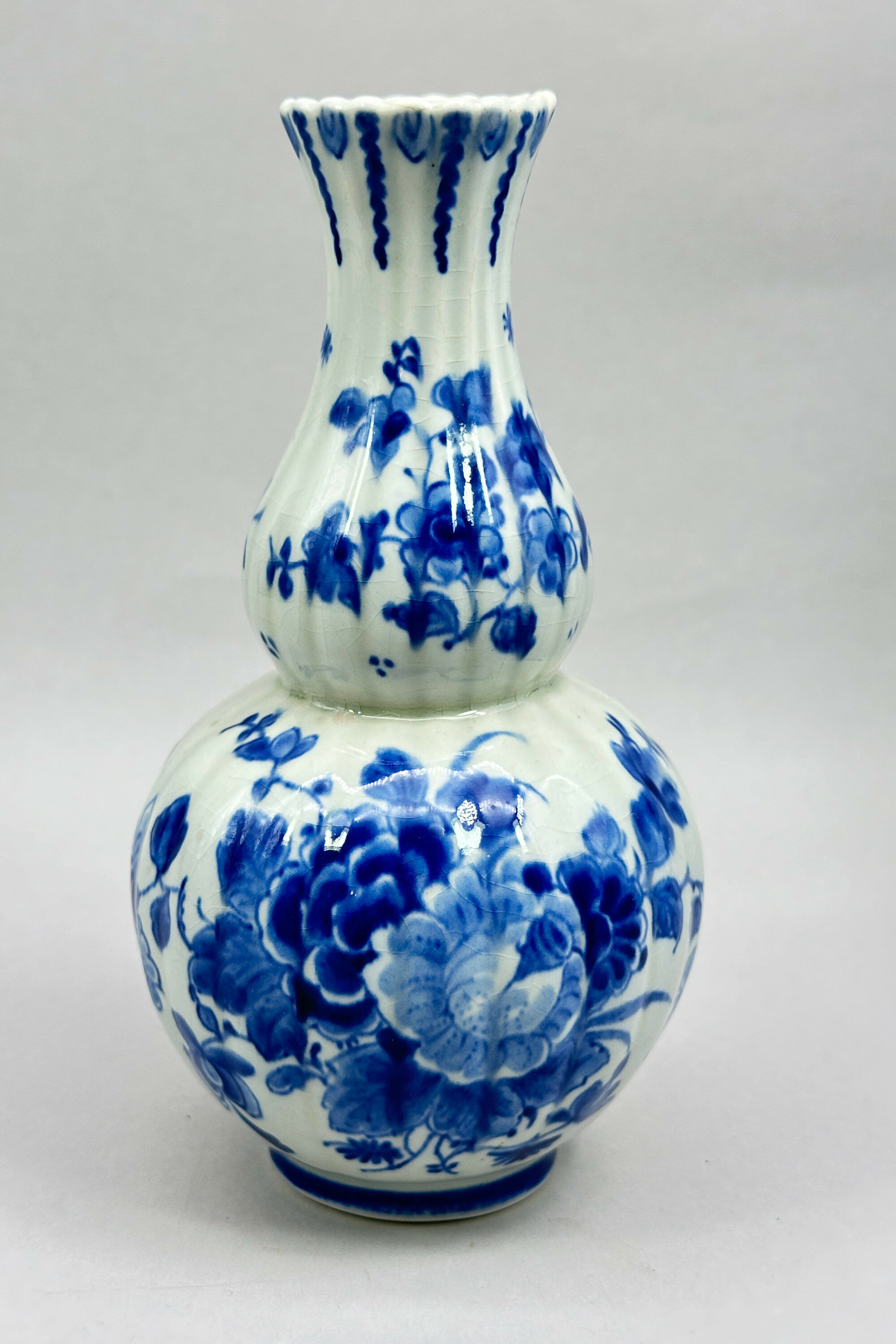
Dutch Delft Blue and White Gourd Vase in C18th Style, late C20th
Price: £25This vase is typical of one of these later creations and copies an eighteenth century original which itself was based on Chinese pieces. The marks underneath, although some of them are blurred, offer a clue to the dating. Below an ‘A’ at the top can be seen a vase which stands for ‘De Porcelyne Fles (The Porcelain Bottle) a factory which was established in 1653 and continues production today. There follow the initials ‘JT’ as a monogram standing for Joost Thooft who bought the factory in 1876 and below this ‘Delft’. At the bottom are usually found the painter’s initials to the left and letters to the right which are the date mark. On this vase these are unclear but the painter’s initials read ‘MA’ which appears to stand for M.H.van Aalst who worked for the firm from 1941to 1983. This would fit with a likely dating here to the second half of the twentieth century, but the artist has successfully recreated the work of his predecessors and produced a piece of great charm.
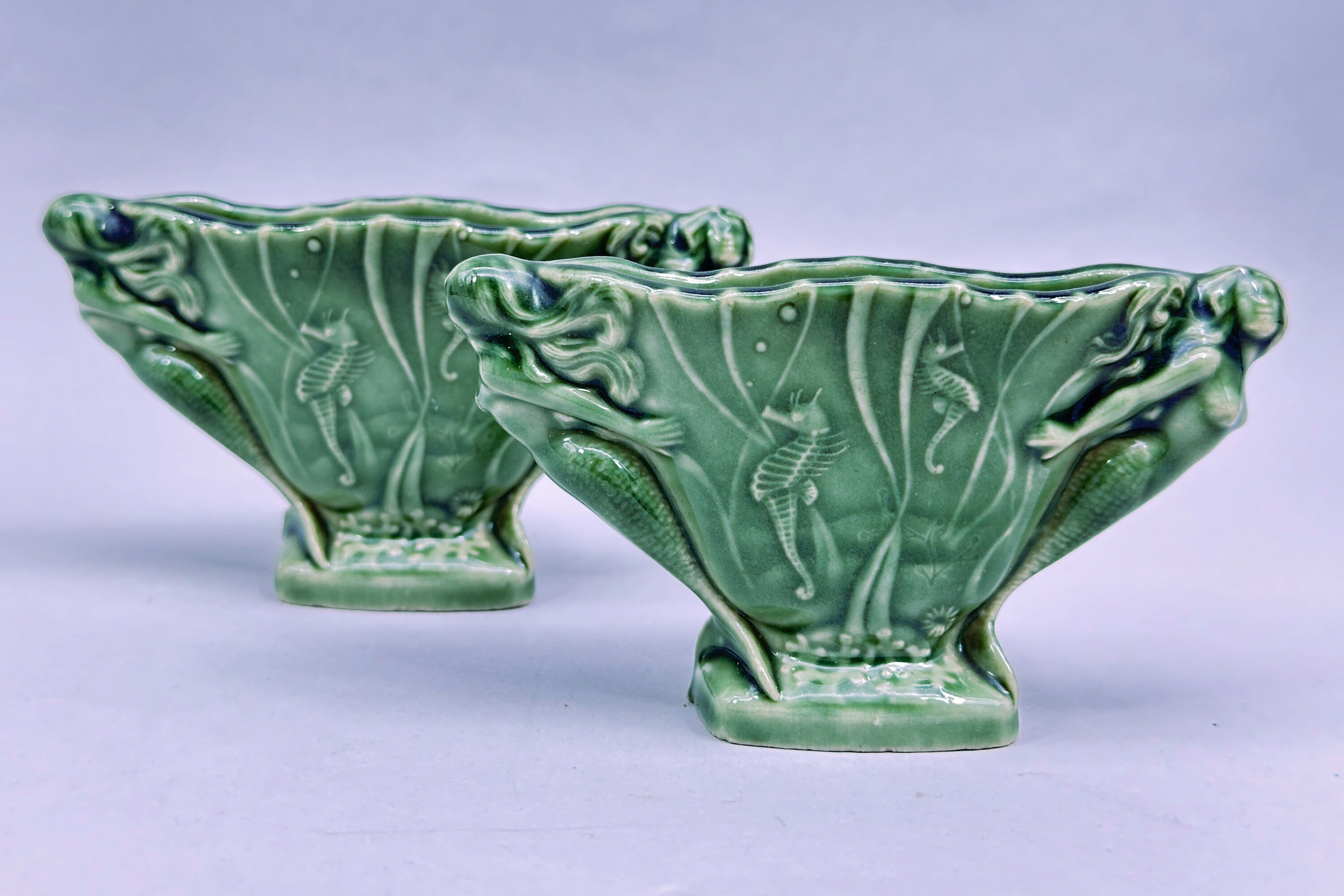
Pair of Wade green glazed Mermaid salts, 1950s
Price: £55Wade Ceramics Ltd was a manufacturer of porcelain and earthenware, headquartered in Stoke-on-Trent, England. Founded in 1867, it was run by various members of the Wade family until the death of George Anthony Wade in 1987 after which there was a succession of management buyouts. Despite substantial investment in 2009, the firm eventually went into administration in 2022. Wade produced a wide variety of ceramics, including the well known Wade Whimsies animal figurines.
This pair of salts is rather different to many of their productions and have a distinctly ‘Art Nouveau’ feel but, in fact, date to the 1950s when this particular format of the factory mark was used. It seems to be one of the rarer forms and pairs are even rarer still, so definitely one for Wade collectors!
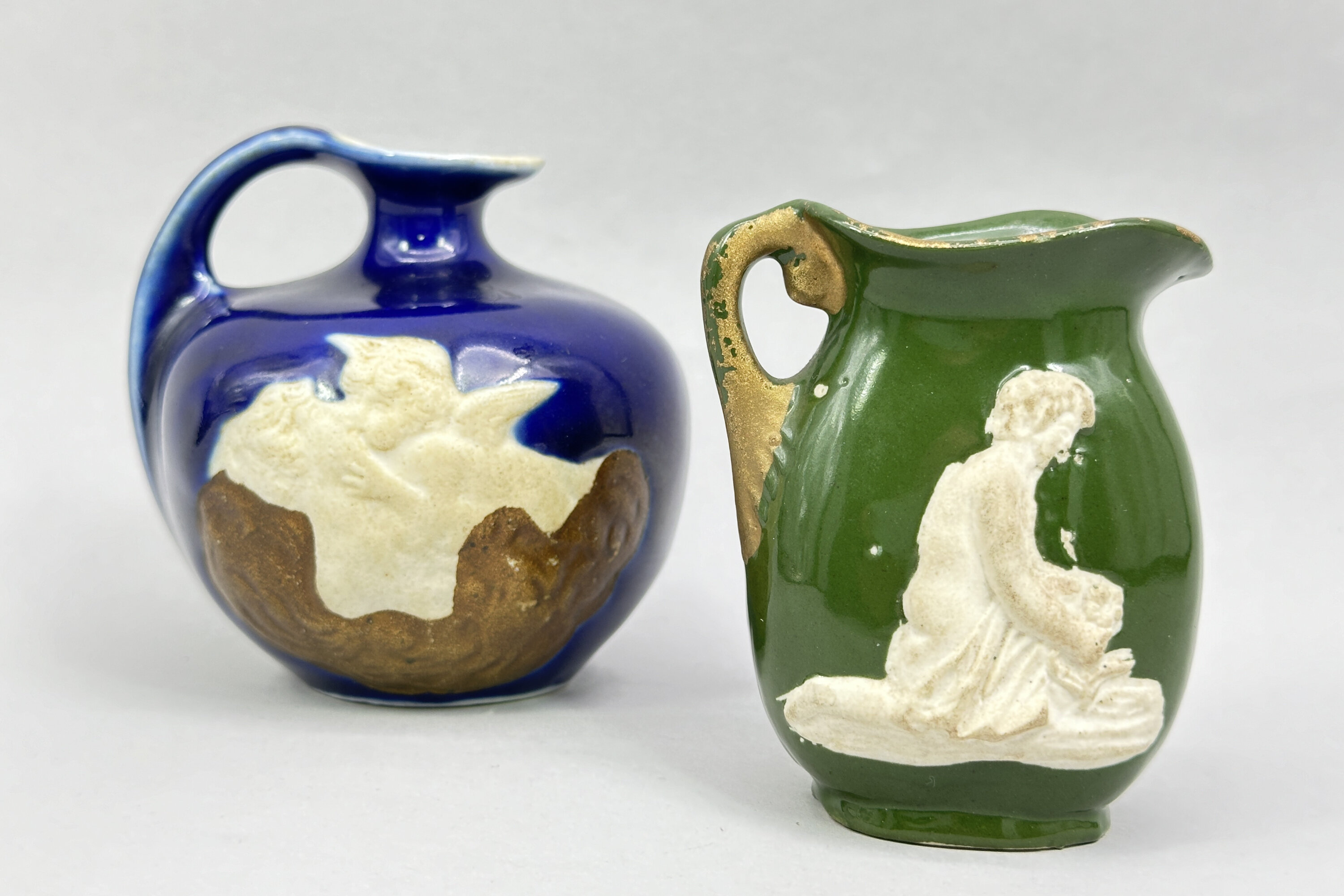
Two Ceramic Jugs with Erotic Decoration, continental perhaps German, circa 1900
Price: £25These pieces represent something of a puzzle. Seen the right way round (with the handle on the right) they are plain and the decoration only reveals itself on the reverse. This suggests a playful intent to conceal which, when combined with the subject matter, suggests something a bit ‘naughty’ which could confirm the second interpretation of what the seated man is holding! The paste, and general style of the pieces, looks continental and a German origin might be a good guess, but no more than that. The blue glazed jug has an impressed mark to the base ‘186 [plus an unidentifiable number]’ which might be the date but is more likely the pattern number; a dating of around 1900 for both seems reasonable - certainly there is an ‘old’ look to the pieces. There are one or two similar examples but little in the way of firm information. One for a collector to puzzle out!
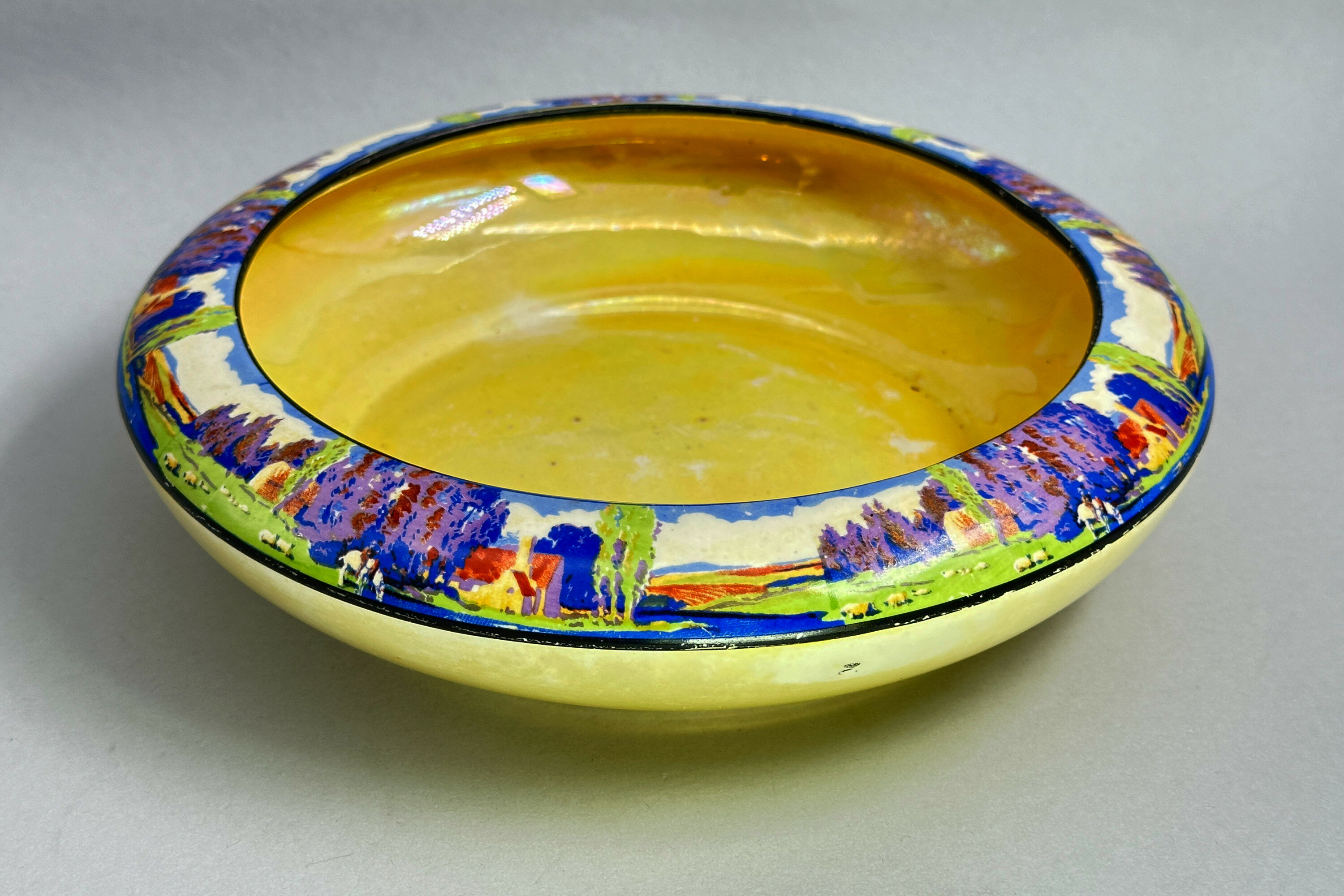
Hanley Ware circular bowl, Lancaster and Sons, 1920s
Price: £25Lancaster & Sons Ltd were manufacturers of earthenware at the Dresden works, Tinkersclough, in the Shelton area of Hanley, Stoke-on-Trent, England. The firm was founded in 1899 under the name ‘Lancaster and Barker’ was renamed ‘Lancaster & Sons Ltd’ in the early 1900s and continued production until 1944. In the 1920s they produced various pieces with rural landscape scenes of which this is an example. Some see reminiscences of the ‘Arts and Crafts’ movement here but the mark found on the bottom clearly dates the piece to the 1920s. The yellow lustre glaze is interesting and free from the crazing sometimes found.
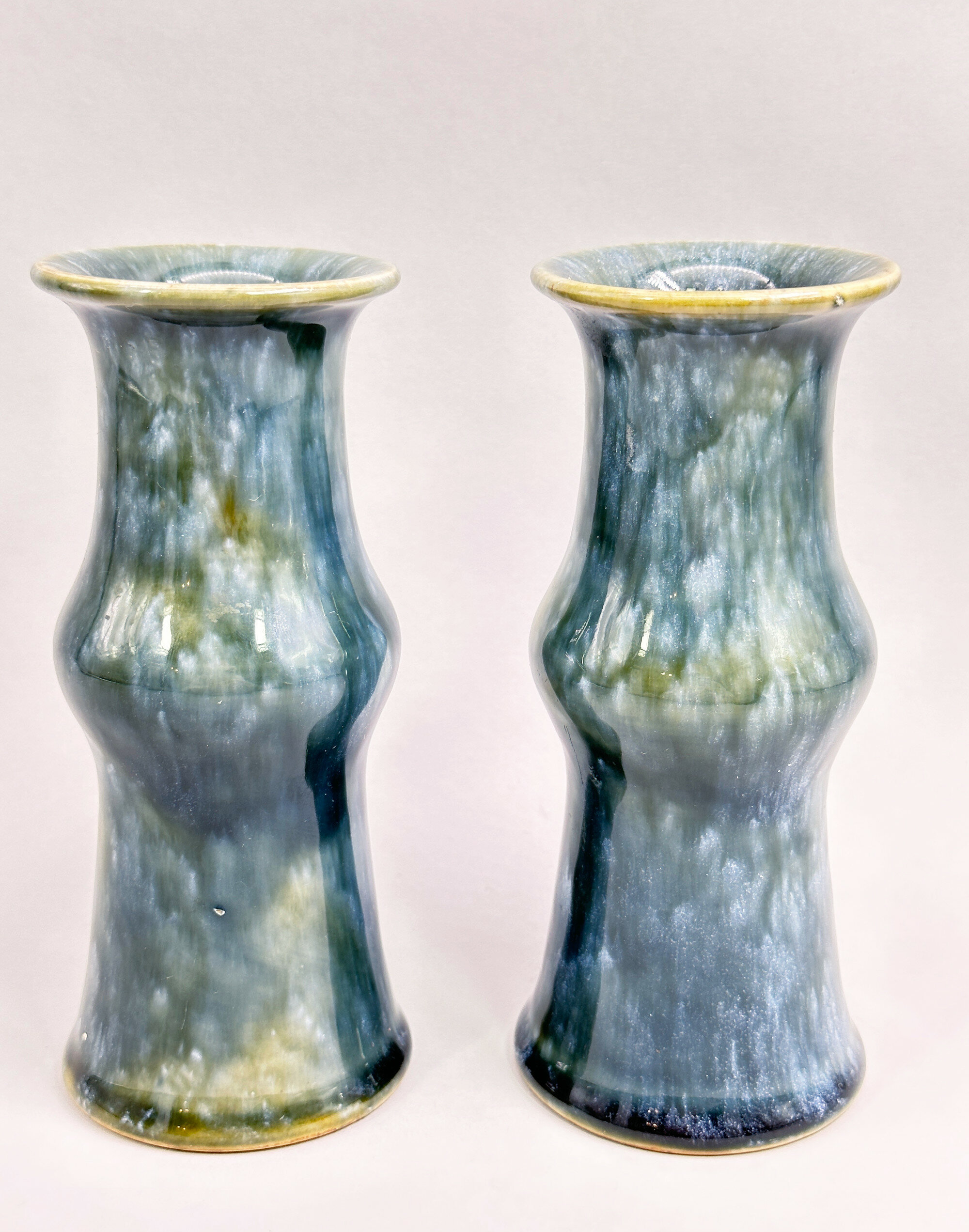
Pair of Royal Doulton slender Ku form Vases, 1920s
Price: £75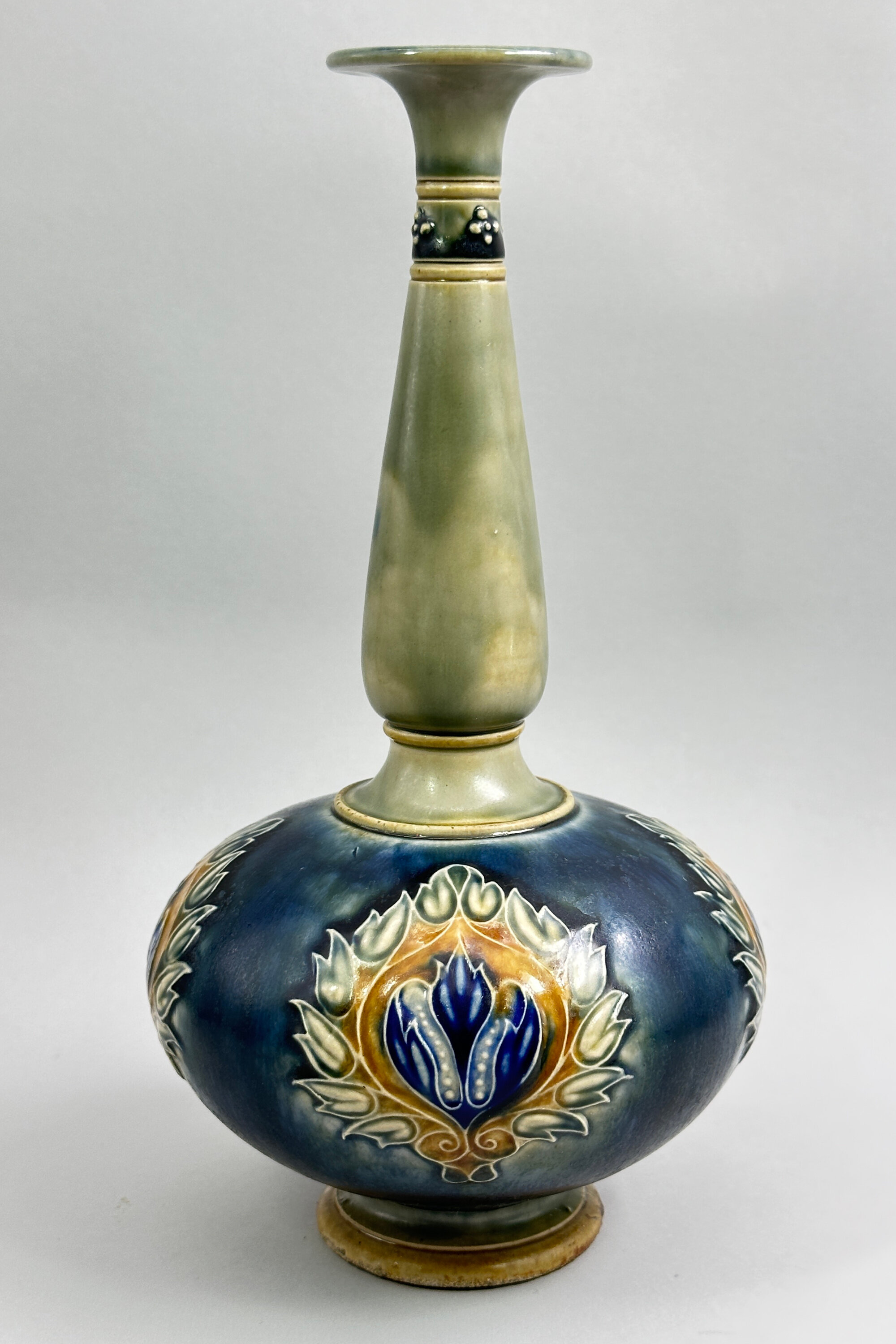
Royal Doulton bottle form Vase decorated with flowering lotus, early 20th Century
Price: £75The Doulton pottery originally had its first factory in Lambeth, London. Set up in 1815 by John Doulton, who is rumoured to have spent his life savings of £100 in starting the business, the firm concentrated on making pipes and utilitarian works. But in the 1880s the Company moved to Staffordshire and began making fine bone china tableware and decorative items. The pottery was located in Burslem, Stoke-on-Trent and has manufactured high quality ceramics and porcelains ever since, receiving a Royal Warrant in 1901.
This piece is typical of the glazed pottery pieces made in the late nineteenth and early twentieth centuries. A muted palette of colours was used and a variety of forms created with many artists taking a hand in the decoration. Most of the pieces are signed, as here. The pattern number indicates a date after 1894, but the Royal Warrant mark means a dating in the early 1900s. Perhaps a timing in the Edwardian era (1901-1910) is the most likely.
This vase is an excellent example of the creative designs which Doulton produced. As often, there is a slight Oriental influence but the style and design are unmistakeable.

Pair of Alhambrian Ware English Majolica Vases with raised decoration circa 1880
Price: £30
Shorter and Sons Green glazed Fish Service, 1950s/1960s
Price: £75The firm which later became Shorter and Son was first set up by Arthur Shorter in 1878 with a partner James Boulton in Stoke on Trent. Their products were solidly in the main-stream of Victorian taste - majolica wares of all types predominated. Time saw another generation join the firm and various amalgamations took place. One of the sons, Colley Shorter, developed a close association with Clarice Cliff whom he eventually married. Her designs, while concentrated on the wares signed with her name, also fed in to the productions of Shorter and Sons and the range of their wares expanded considerably in the 1920s and 1930s.
‘Fish Ware’, as it became known was introduced in the late 1920s and rapidly became one of their best selling lines. Initially production was confined to flat ware and in 1935 a part service was acquired by the Duchess of York, later to become Queen Elizabeth. The range expanded and the design of the gravy boat and stand, introduced in 1936 (and included in the present selection), was attributed to Cliff herself. There were further additions and the late 1950s saw the addition of salt and pepper pots on a wavy tray (also included in the present selection). This service, then, probably dates to around 1960 a little before the firm was effectively taken over by Crown Devon in 1964 and the eventual loss of the identity of its wares. The popularity of the line is easily understood and our present selection is an excellent memento of the design.

Pair of Royal Dux Secessionist Style Vases, 1930s
Price: £250
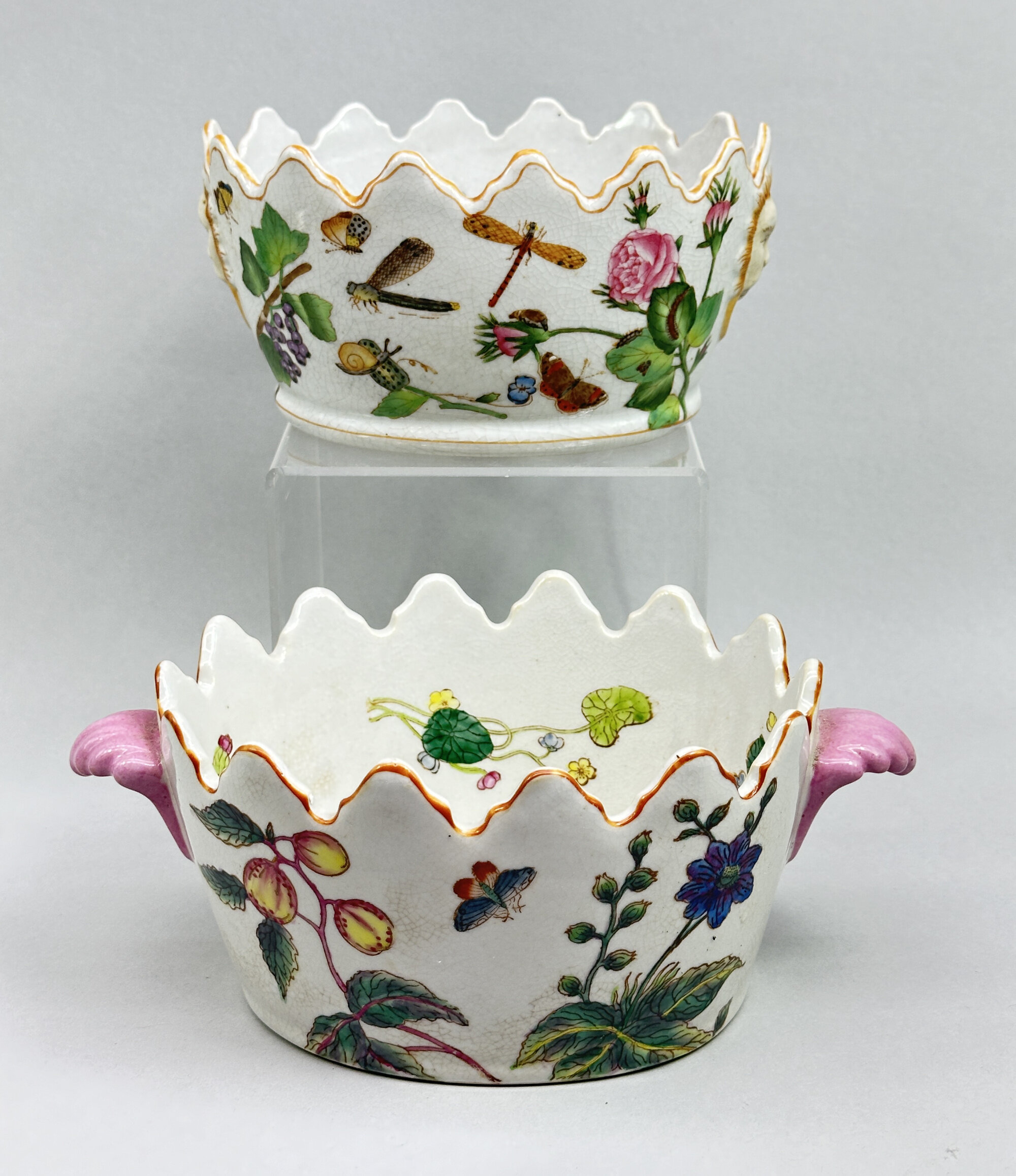
Two similar Chinese Export Style Monteith Form Jardinieres, C20th
Price: £75The form here is a miniature version of the Chinese ‘Monteith’ first produced in the early to mid eighteenth century. The wavy rim was designed to hold the stems of glasses which were stood to cool in iced water placed in the interior. The style of the decoration is in Chinese Export taste as well, but dating here is to the C20th probably around the 1960s. Some similar examples have Chinese seal marks and one the name of a Chinese manufacturer implying that these pieces were most likely made in China but this does not assist with establishing their age. Purely decorative objects then with no intent to deceive but amusing creations in themselves and pleasing to a contemporary eye.
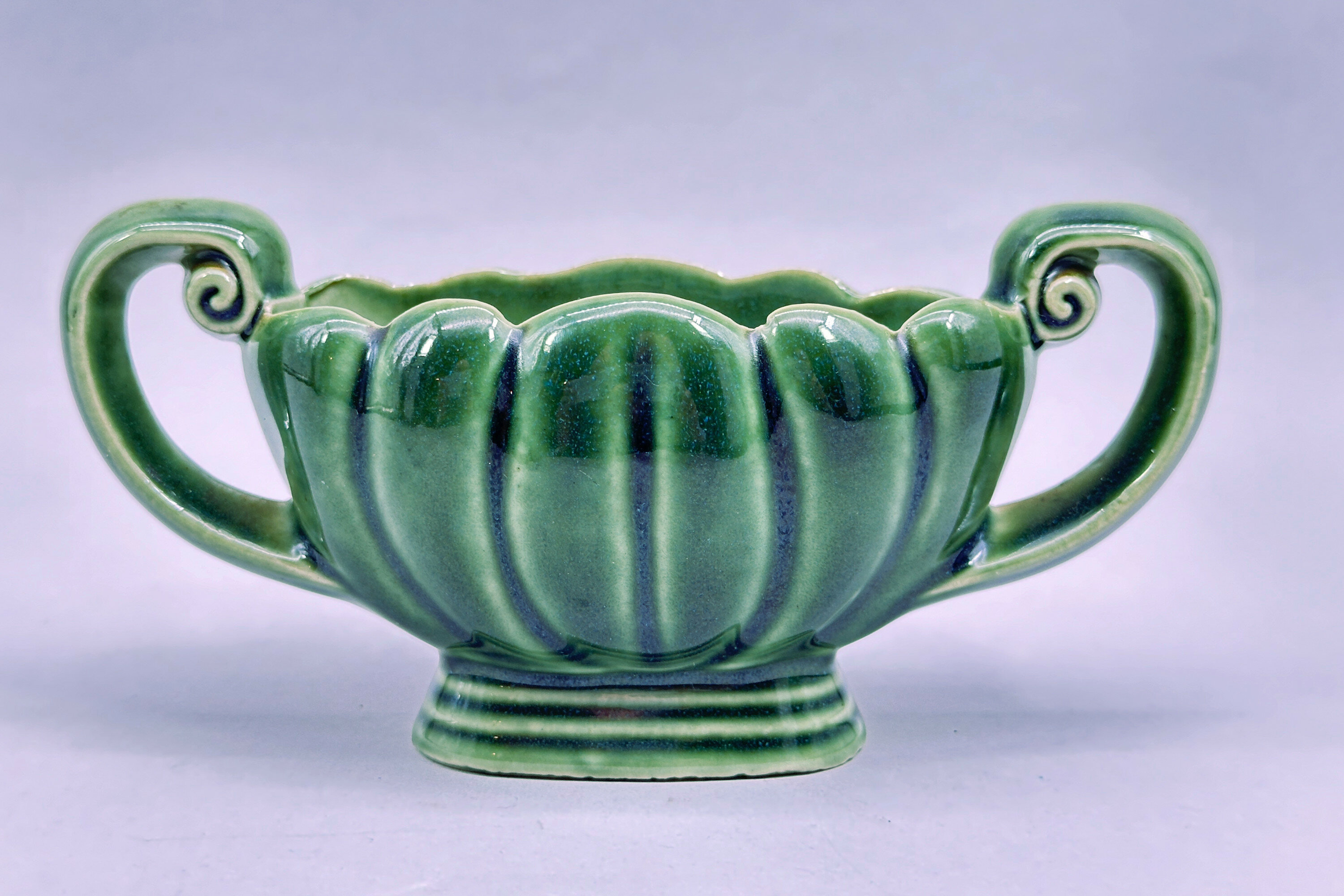
Wade green glazed Posy Vase, 1950s
Price: £20Wade Ceramics Ltd was a manufacturer of porcelain and earthenware, headquartered in Stoke-on-Trent, England. Founded in 1867, it was run by various members of the Wade family until the death of George Anthony Wade in 1987 after which there was a succession of management buyouts. Despite substantial investment in 2009, the firm eventually went into administration in 2022. Wade produced a wide variety of ceramics, including the well known Wade Whimsies animal figurines.
This vase was designed to hold a small bunch of flowers and was produced in a variety of sizes and colours, green being the most common. The form has an almost ‘neo classical’ feel but the piece dates to the 1950s when this particular format of the factory mark was used.
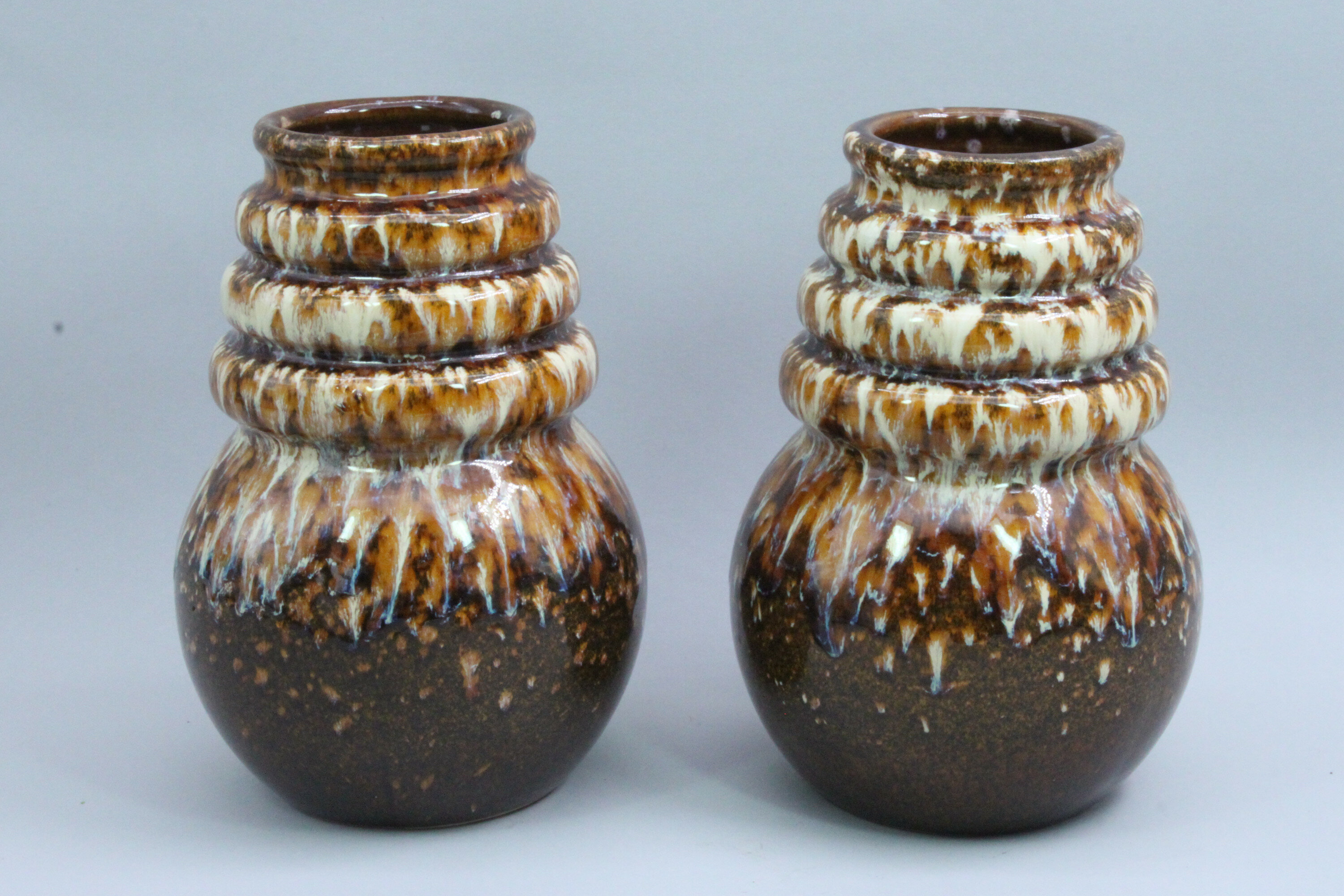
Pair of West German Scheurich Pottery ‘Wien’ Vases, model 269-18, mid 20th Century
Price: £45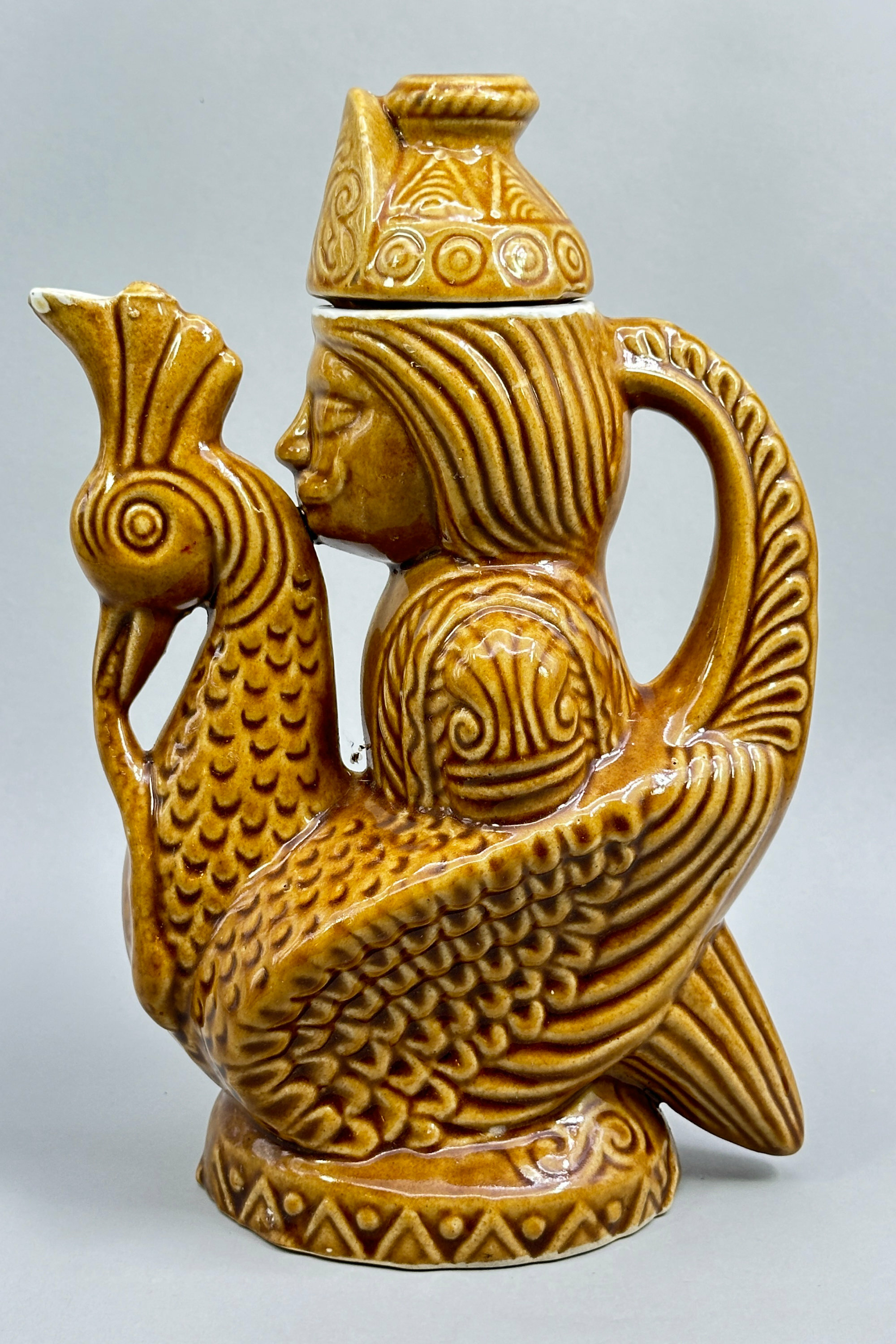
Bird form ewer with cover, possibly Russian c1960
Price: £45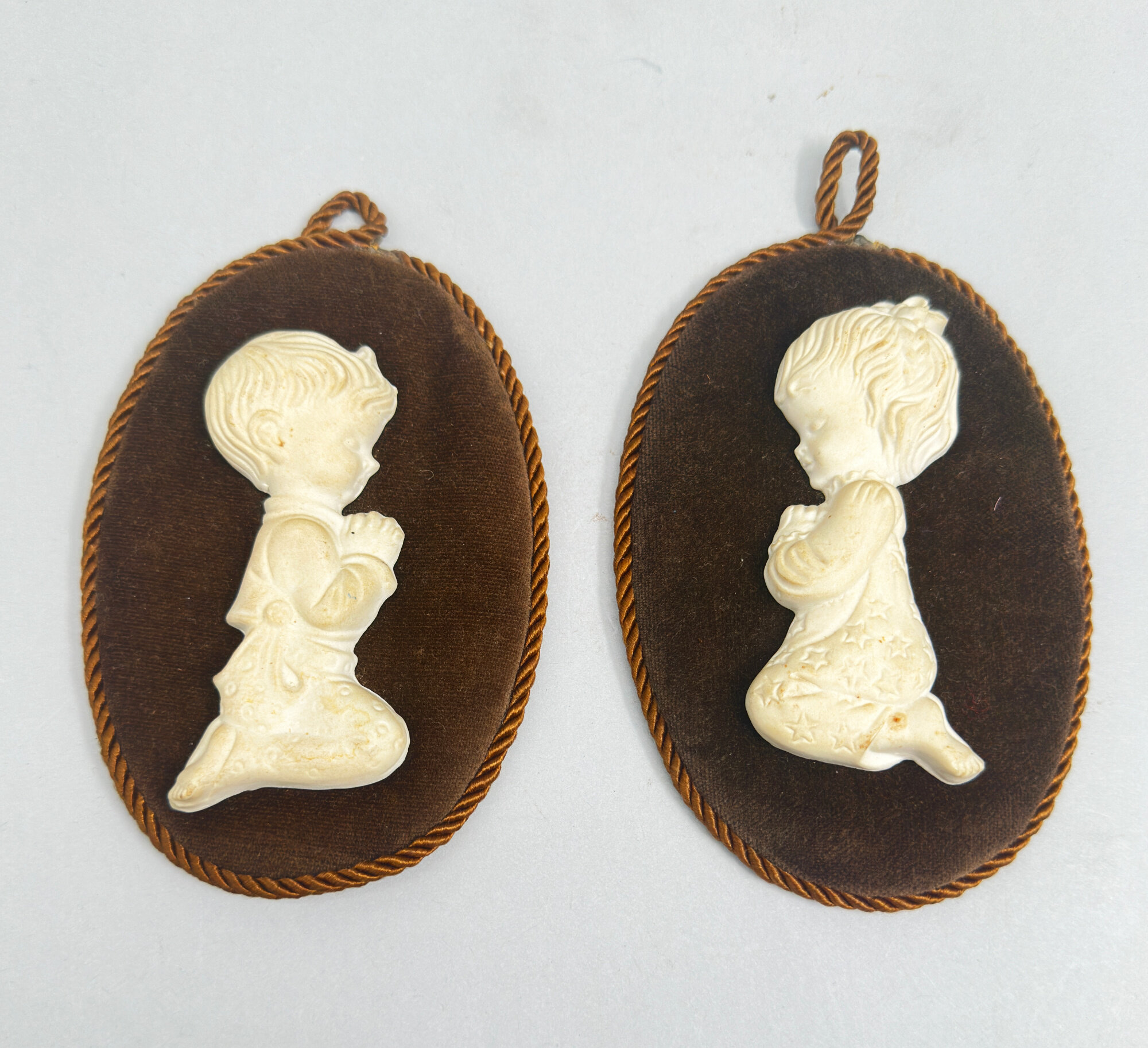
Pair of Capodimonte ceramic Wall Hanging Plaques, boy and girl praying, Italian 1960s
Price: £25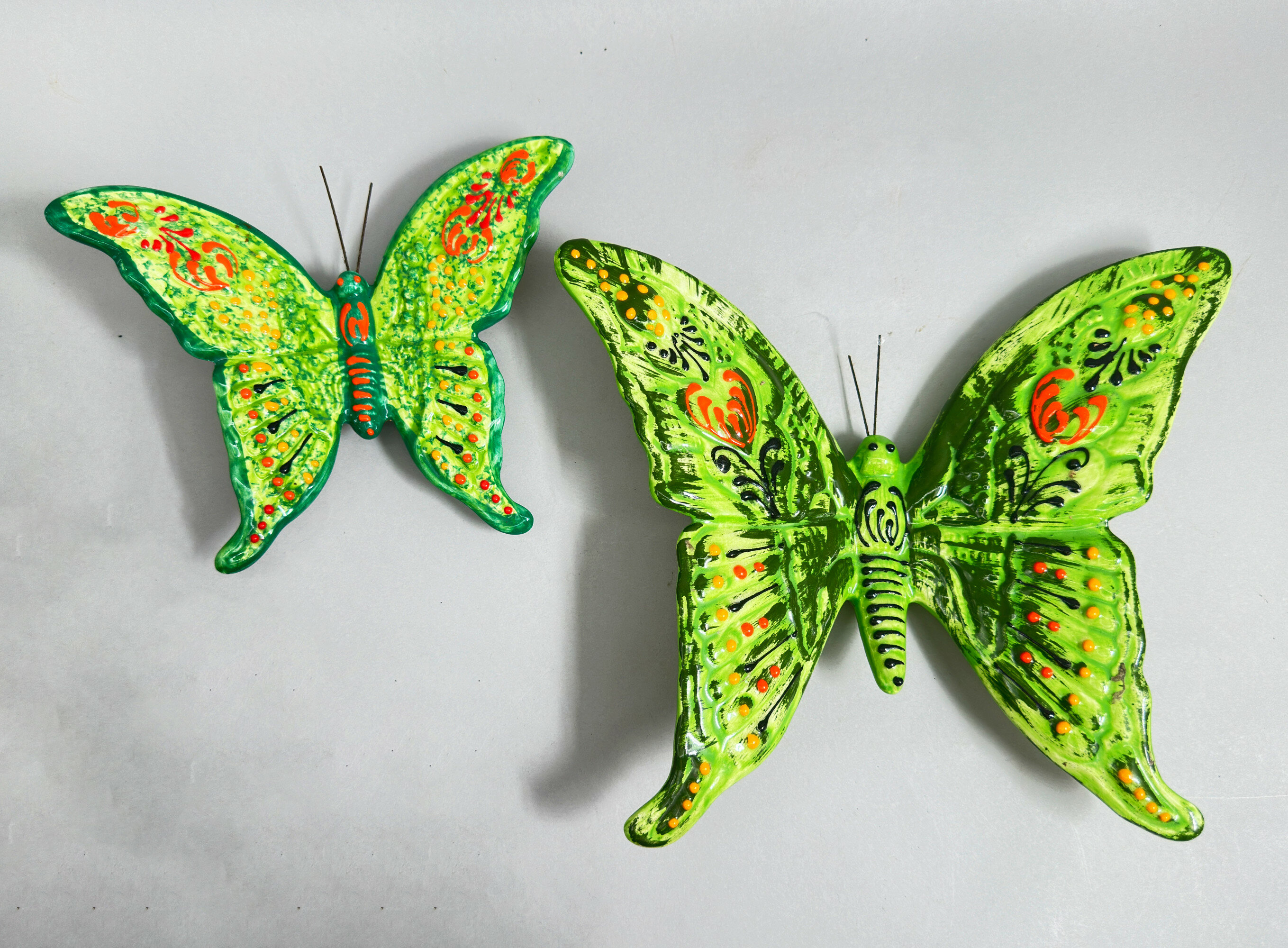
Pair of Ceramic Wall Hanging Plaques, Butterflies, probably continental 1960s
Price: £40
Fairing Figurine – A Mouse A Mouse, German, late C19th
Price: £25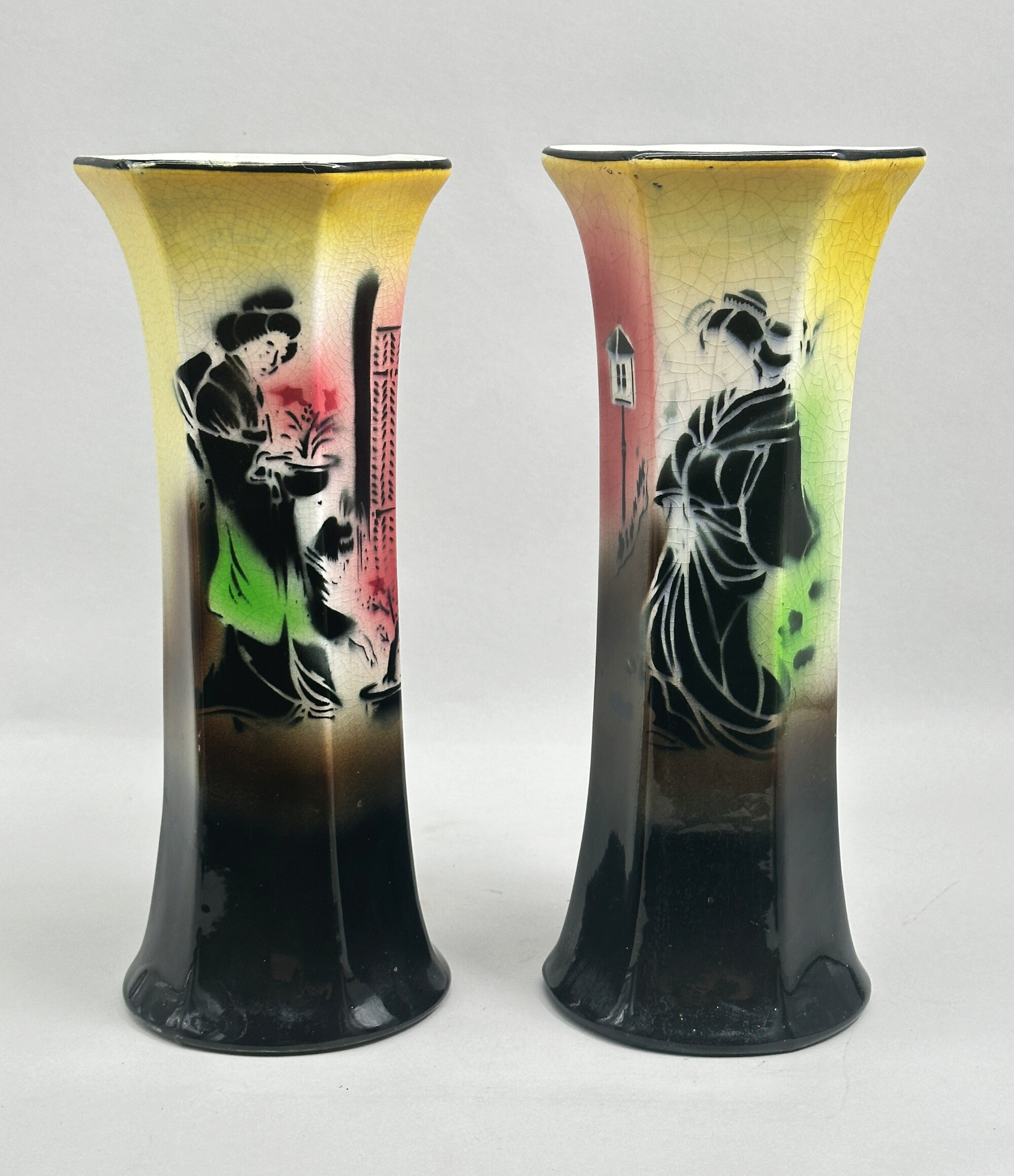
An unusual pair of Art Deco style Japonaiserie ceramic vases, probably French 1920s/1930s
Price: £75
Ceramic Model of a Viking Longboat, Wade, 1950s/1960s
Price: £25Wade Ceramics Ltd was a manufacturer of porcelain and earthenware, headquartered in Stoke-on-Trent, England. Founded in 1867, it was run by various members of the Wade family until the death of George Anthony Wade in 1987 after which there was a succession of management buyouts. Despite substantial investment in 2009, the firm eventually went into administration in 2022. Wade produced a wide variety of ceramics, including the well known Wade Whimsies animal figurines.
Many of their pieces were designed to act as small containers for flowers and trinkets and this piece is a particularly amusing example of the type. Two colour ranges exist, one as here and one with much darker tones which is held to be later. Dating here, then, is most likely to the 1950s/1960s when the Wade production lines were in full swing and enjoying considerable popularity.

Miniature Staffordshire flatback model of two spaniels and a barrel, second half C19th
Price: £55
Oriental style ceramic plate, signed Alice Smith, possibly American mid C20th
Price: £10
Dresden style model of a Coach and Horses, probably German early C20th
Price: £75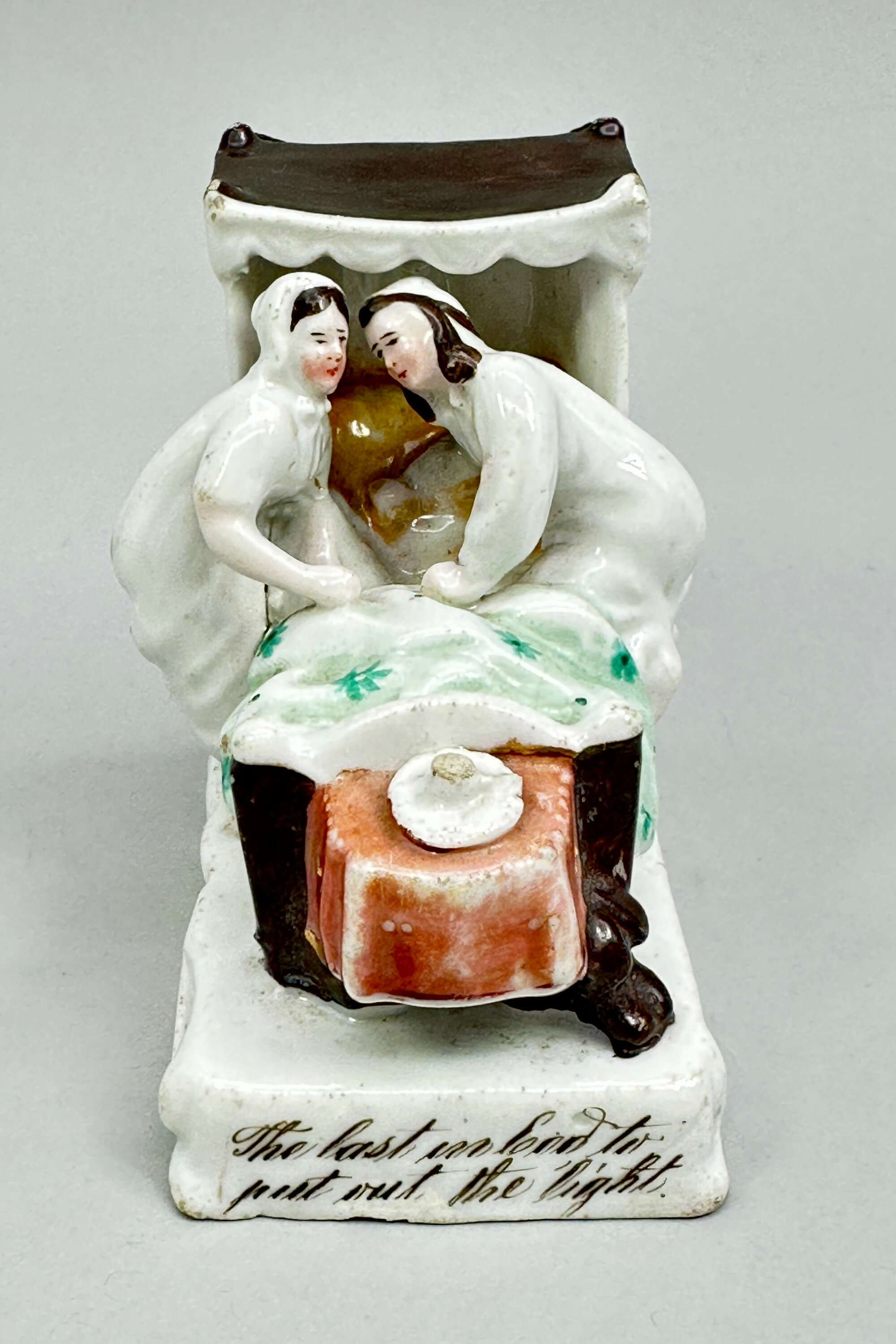
Fairing Figurine - The last in bed to put out the light, German, late Nineteenth Century
Price: £25The various figures were made in white glazed porcelain with coloured decoration. The compositions were sculptural and often accompanied by an inscription, as here. Many models are known. Two typical examples are 'Returning from the Ball' and 'Twelve Months after Marriage' but the most common example is represented here 'The last in bed to put out the light'. A couple are seen climbing into a covered bed at the foot of which stands a candle in a holder. These candles are usually broken off, most likely because of simple damage over the years but it has been suggested that this was done deliberately for good luck.
Some of the fairing figurines are marked, as here. The impressed number '2851' comes from the first series of figures produced by the Conta factory with numbers ranging from 2850 to 2899. The earlier examples do not have the shield mark found on most of the pieces which indicates an earlier dating here, more towards the middle of the nineteenth century.
Fairings have been collectors' items for many years now and still hold a naif charm which makes them appealing display items, with a history of their own.
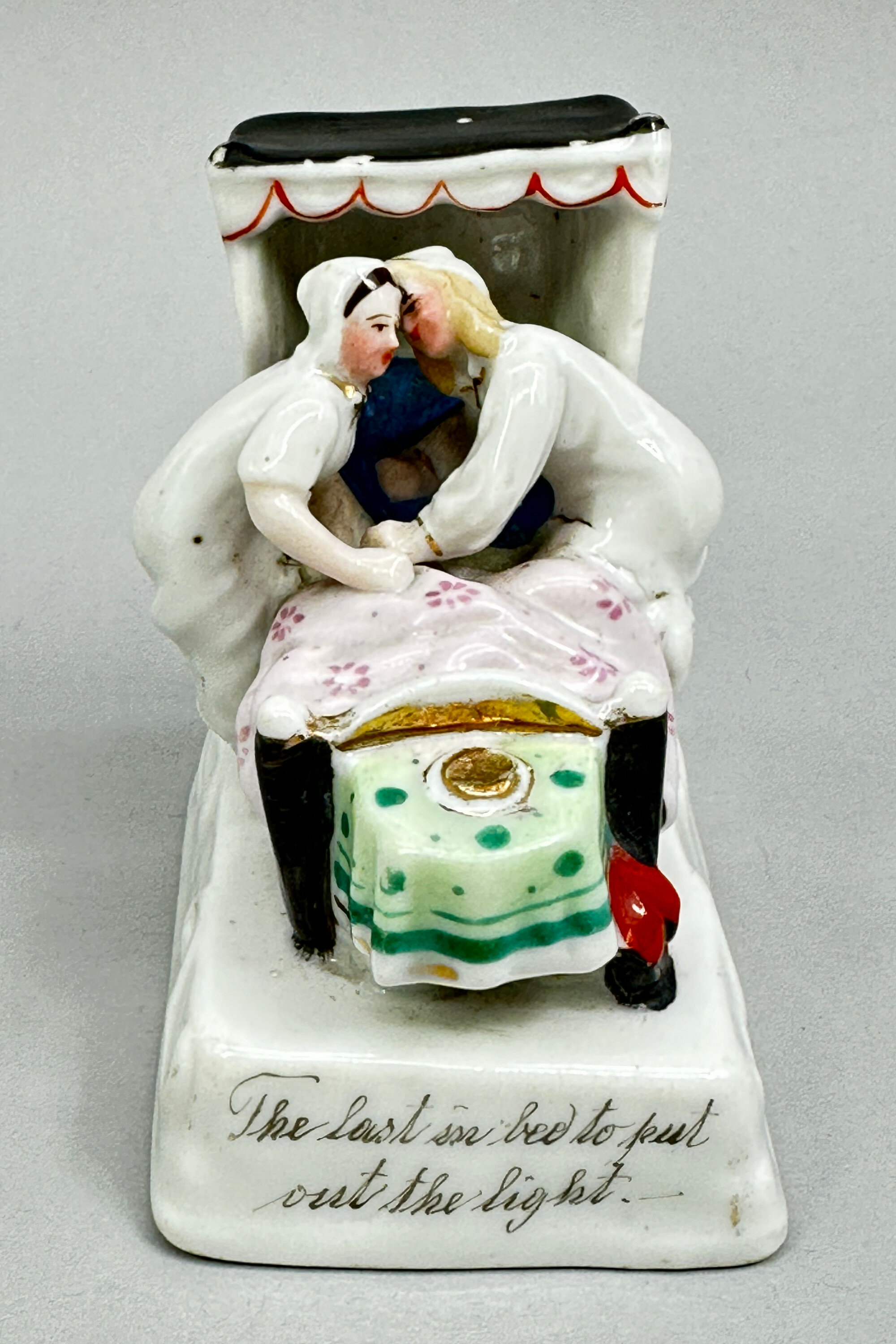
Fairing Figurine - The last in bed to put out the light, German, early Twentieth Century
Price: £25The various figures were made in white glazed porcelain with coloured decoration. The compositions were sculptural and often accompanied by an inscription, as here. Many models are known. Two typical examples are 'Returning from the Ball' and 'Twelve Months after Marriage' but the most common example is represented here 'The last in bed to put out the light'. A couple are seen climbing into a covered bed at the foot of which stands a candle in a holder. These candles are usually broken off, most likely because of simple damage over the years but it has been suggested that this was done deliberately for good luck.
Some of the fairing figurines are marked, as here. In comparison with the previous Lot 4, this example has a glazed circular mark which reads 'Made in Germany'. These marks appear on the later productions of the Conta factory and indicate a dating here to shortly before the First World War. This is consistent with the rather 'brassy' looking gilding used which is typical of ceramic production generally post 1900.
It is interesting to compare Lots 4 and 5 and to see how consistent the manufacture was throughout the period. Only the glazed base with its circular mark and the type of gilt decoration separate this example from its earlier companion.
Fairings have been collectors' items for many years now and still hold a naif charm which makes them appealing display items, with a history of their own.
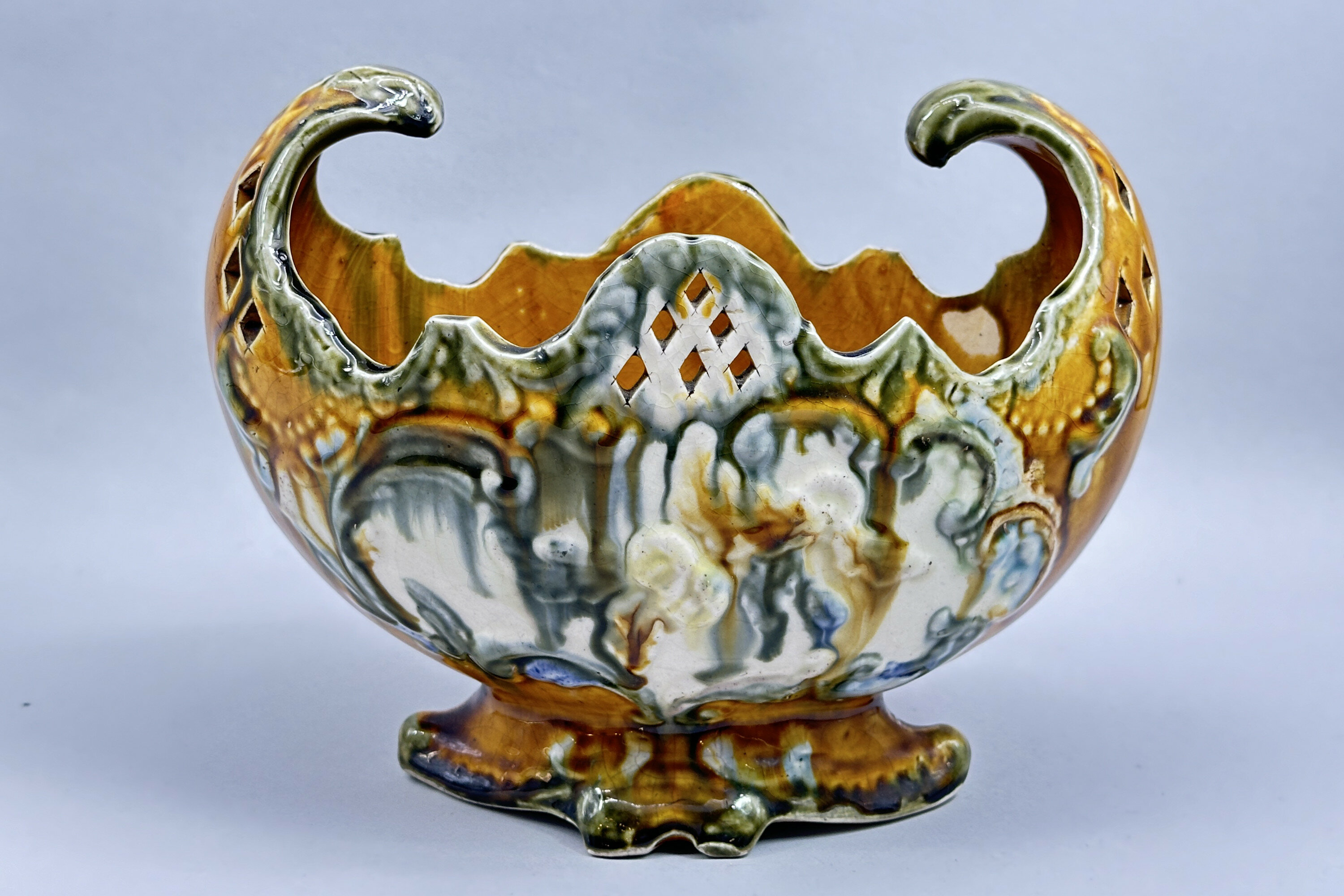
Majolica Style Jardiniere, French, circa 1900
Price: £55This is a French interpretation of the ‘Majolica’ style which became so popular, particularly in England in the second half of the nineteenth century. A very distant relation of the tin glazed Italian and Spanish wares which share the name, nineteenth century majolica employed a wide variety of brightly coloured glazes applied to elaborate forms some of which had a slightly ‘classical’ feel and some a reflection of ‘rococo’ designs. The paste and glazes here suggest France, which produced various pieces in the ‘majolica’ style and dating is probably to the end of the nineteenth century.
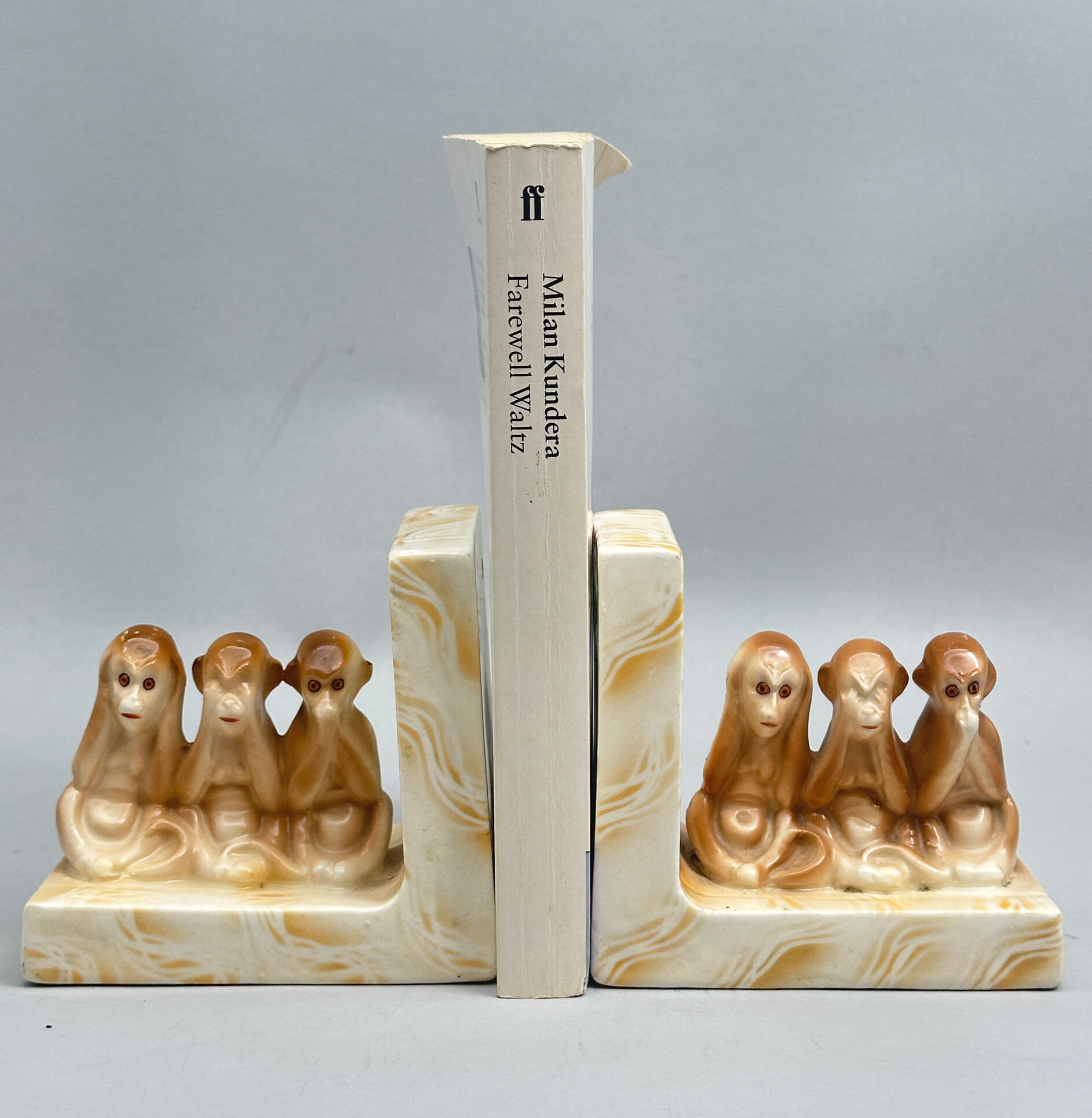
Pair of ceramic Bookends, the three wise monkeys, Czech second half C20th
Price: £30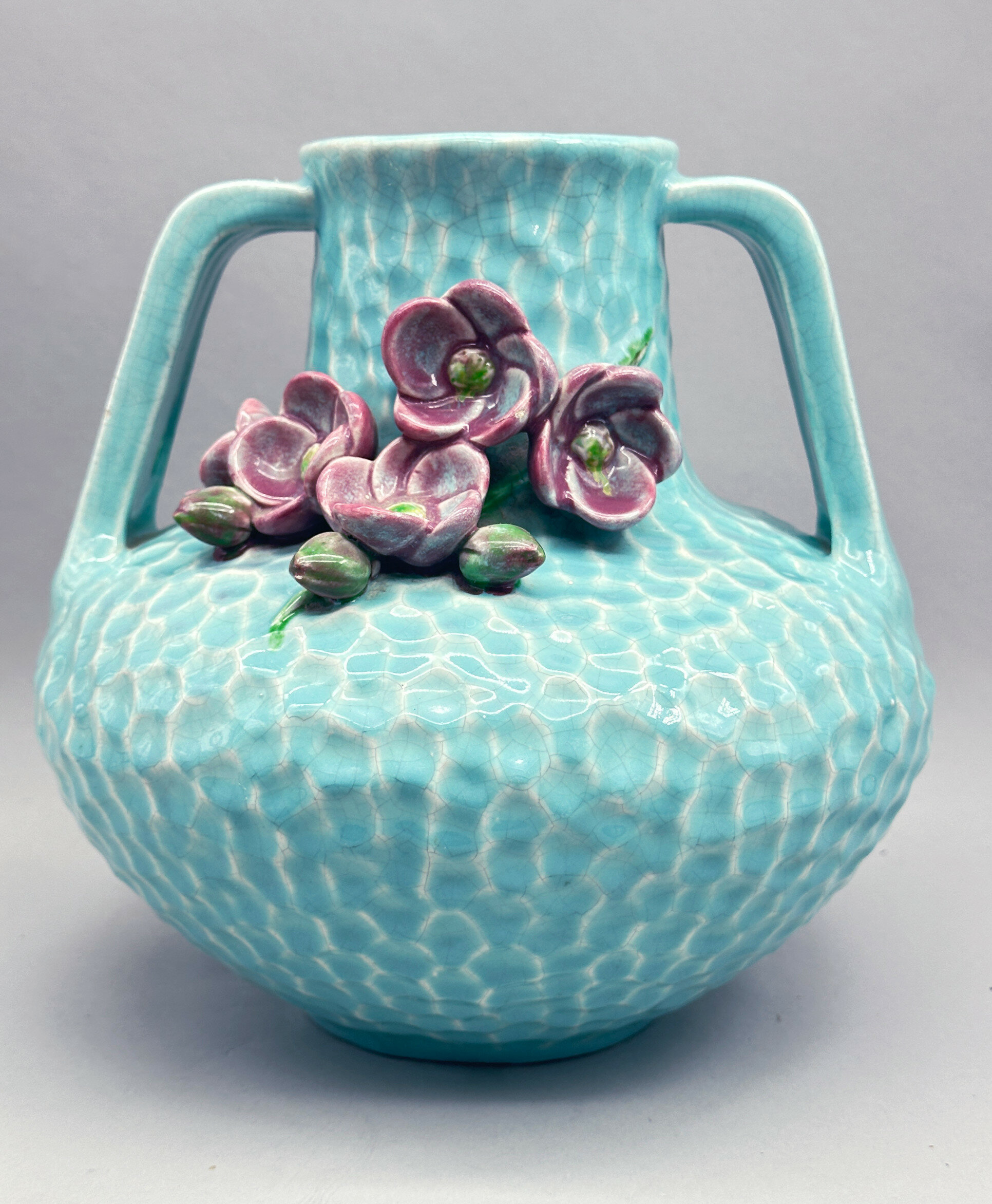
Art Nouveau style turquoise glazed Urn shape Vase, Bretby ware, early C20th
Price: £75The firm Bretby was the result of an amalgamation between Henry Tooth and William Ault who formed a partnership in 1883. Both had previously worked at the Linthorpe pottery established by Christopher Dresser in 1879 and retained a comnnection with the celebrated designer even after striking out on their own. Success came early and the firm won a gold award in the Crystal Palace Exhibition of 1884, patenting their trademark with its sunburst design above the name Bretby in the same year. Ault left the partnership in 1887 to set up his own business under his own name but Henry Tooth continued to oversee production until his death in 1918, the business then remaining under the control of the Tooth family until it was sold in 1933. Production continued, though, well into the twentieth century until the firm closed around in the late 1990s.
This piece is typical of their earlier work with a nod to both the art nouveau style and Dresser himself, particularly in the shape of the handles. ‘Hammered’ decoration was typical of the Arts and Crafts movement popular at the time and the applied floral decoration has some parallels with Japanese pieces again much in vogue at that period. Similar pieces are known with the same shape and pattern number (1742) which seems itself also to indicate an early twentieth century dating, but the applied decoration seen here is unusual.
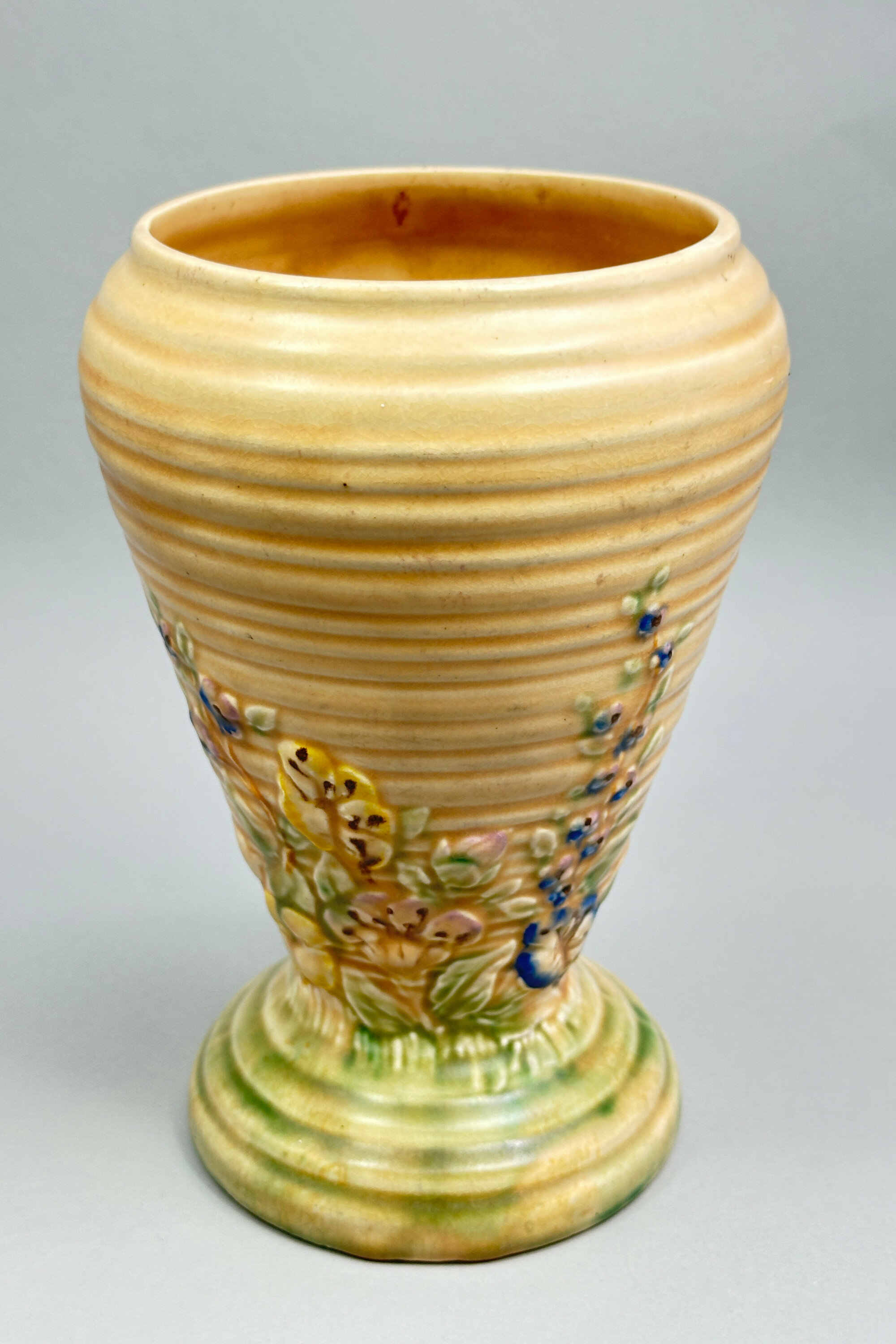
Art Deco Vase, Springtime, Price Brothers, Staffordshire, 1930s
Price: £35Price Bros was an earthenware manufacturer established at the Crown Works, Burslem, Staffordshire, England, in 1896 by the Price brothers. They specialised in tabletop accessories and teapots and success was rapid such that in 1934 they moved to larger premises at the Top Bridge Works in Longport, where they became known as Price Bros Ltd. A close association with another firm, Kensington Potteries, was finally cemented when the two firms merged in 1962 taking on the name ‘Price and Kensington’ and continuing to manufacture their popular wares to the present day. This vase is typical of the decorative pieces which Price Bros produced during the 1930s and, as with so much of the pottery produced at that time, it reflects the Art Deco styles, particularly in the semi abstract shape. This vase was mould made as can be seen from the joins at each side (see image 7) but there is nothing mechanical about the finished result with its pleasing combination of colour and decoration.

Large Shelley Harmony Ware Vase glazed in blue and grey, 1930s
Price: £75Shelley Potteries, situated in Staffordshire, was originally known as Wileman & Co. which had also traded under the name ‘The Foley Potteries’. The first Shelley to join the company was Joseph Ball Shelley in 1862, and it remained a Shelley family business until 1966, when it was taken over by Allied English Potteries. Joseph’s son Percy employed first the designer Frederick Rhead then Walter Slater who had worked with Doulton. It was Walter Slater’s son, Eric, who initiated the ‘Harmony’ range in 1932, at first with a series of banded designs as here and then with drip ware patterns which became enormously popular. Harmony ware was produced in a wide variety of colours and shapes, the plain ovoid form being typical and reflecting the Art Deco styles of the period, but this example is exceptionally large with a more unusual range of colourings.
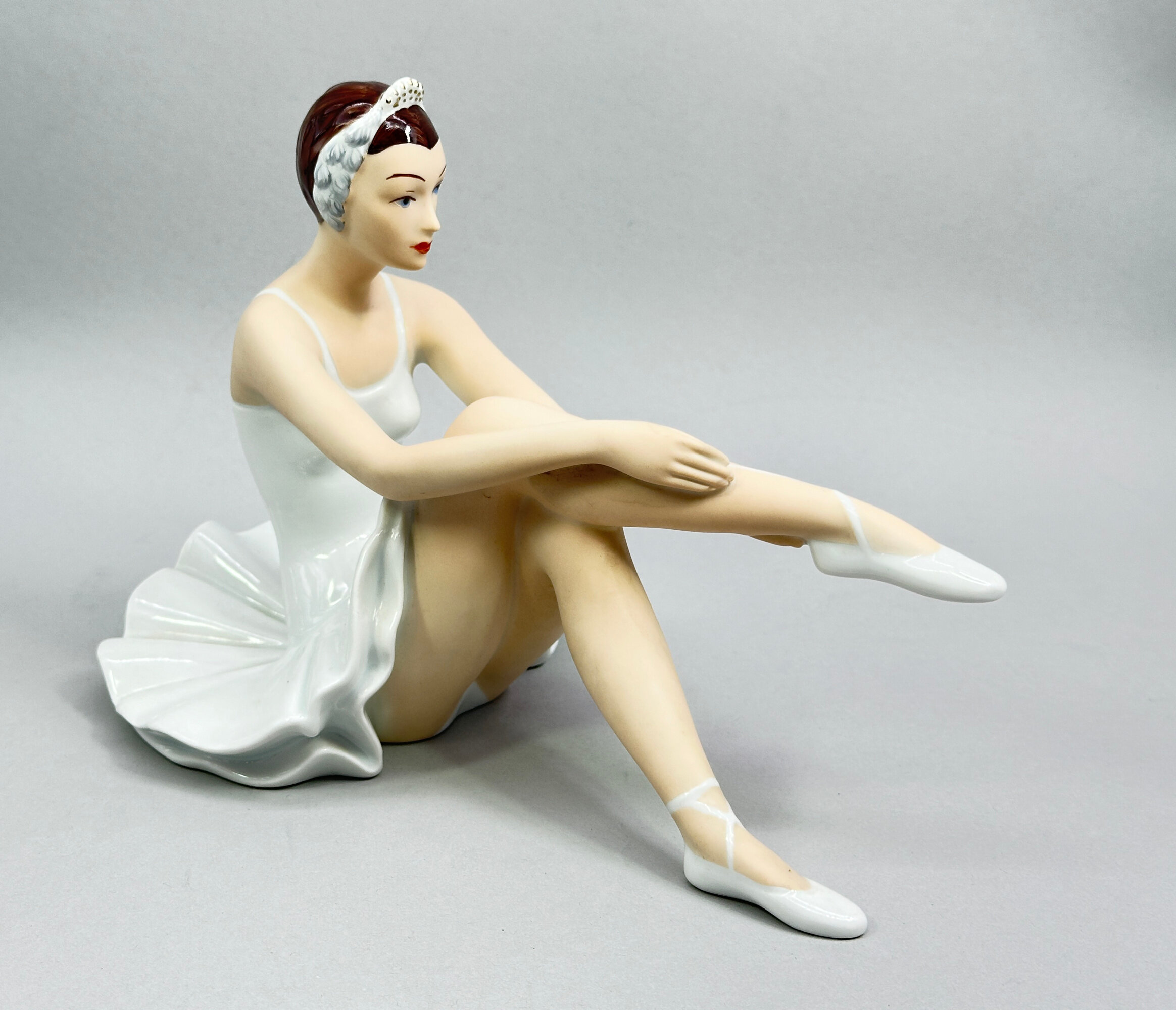
Figure of a Seated Ballerina, Royal Dux, late C20th
Price: £75Duxer Porzellanmanufaktur, or the Dux Porcelain Manufactory, was started in 1860 by Eduard Eichler in what was then Duchov, Bohemia, later to become part of Czechoslovakia. Production was to continue until the beginning of the second world war and beyond and their later pieces are now generally referred to by the abbreviated name, ‘Royal Dux’. The distinctive pink triangle plaque mark was first used in the late nineteenth century but appears on pieces from all dates, the version found here indicating late twentieth century work which is also confirmed by the rather indistinct stamped mark comprising a triangle surrounded by the wording ‘Hand Painted Made in Czech Republic’. The artist is named as ‘V.David’ and there seem to be two other companion pieces in different poses. The quality is quite excellent and explains the original popularity of the firm when it began manufacturing in the nineteenth century and produced highly successful imitations of its contemporary rivals.
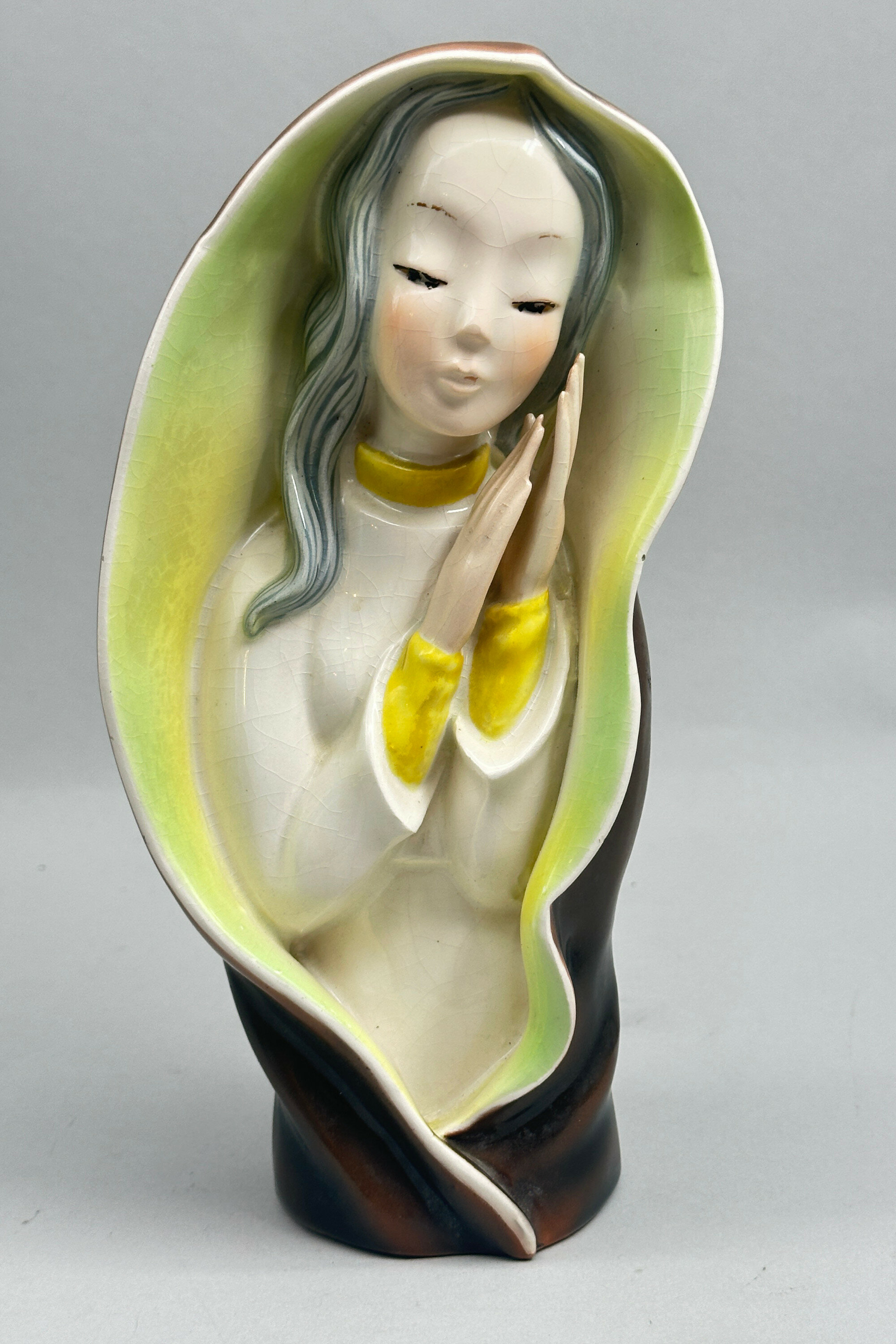
Figure of a Young Girl Praying, Continental, probably mid C20th
Price: £55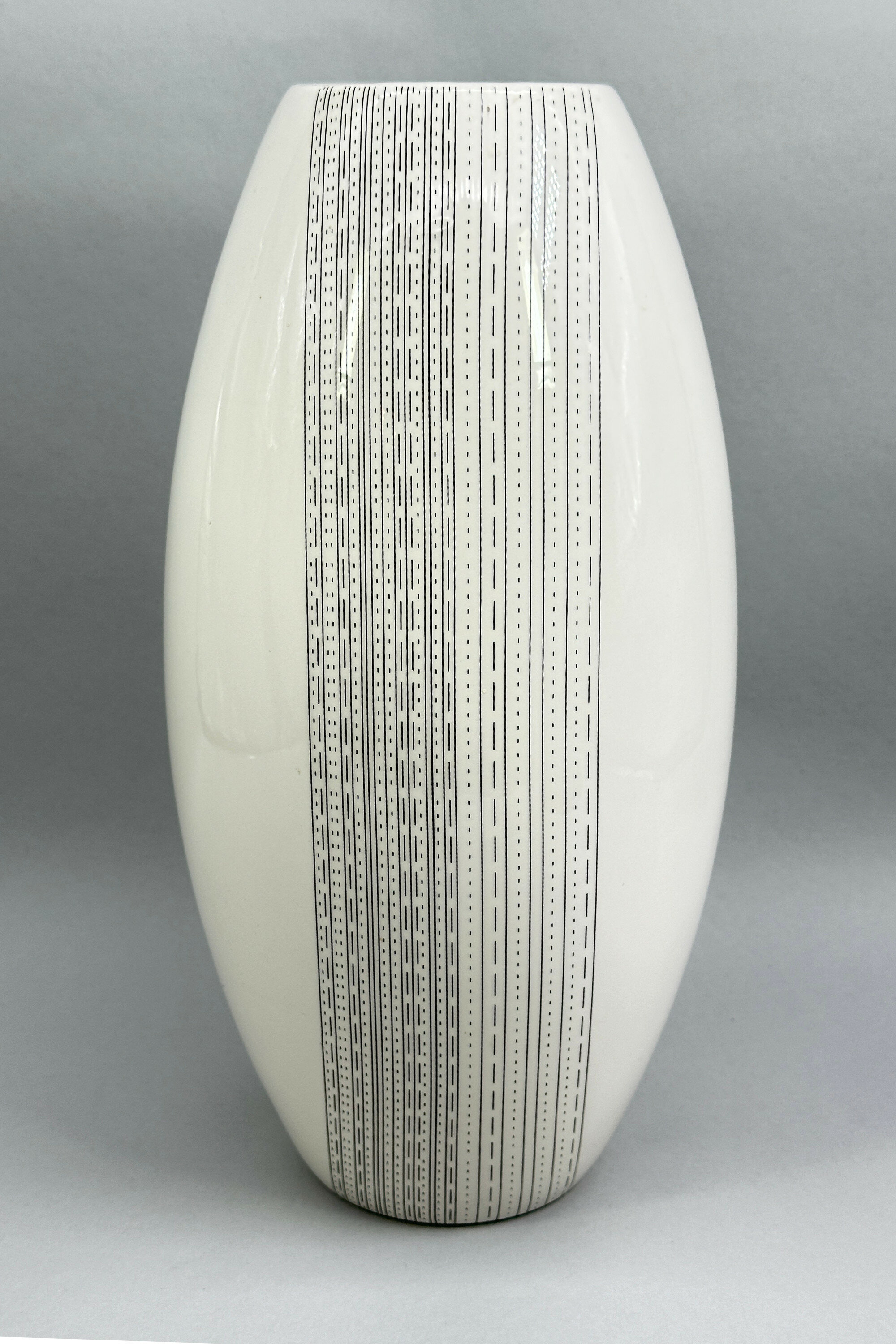
Abstract Design White Glaze Vase, probably British mid C20th
Price: £25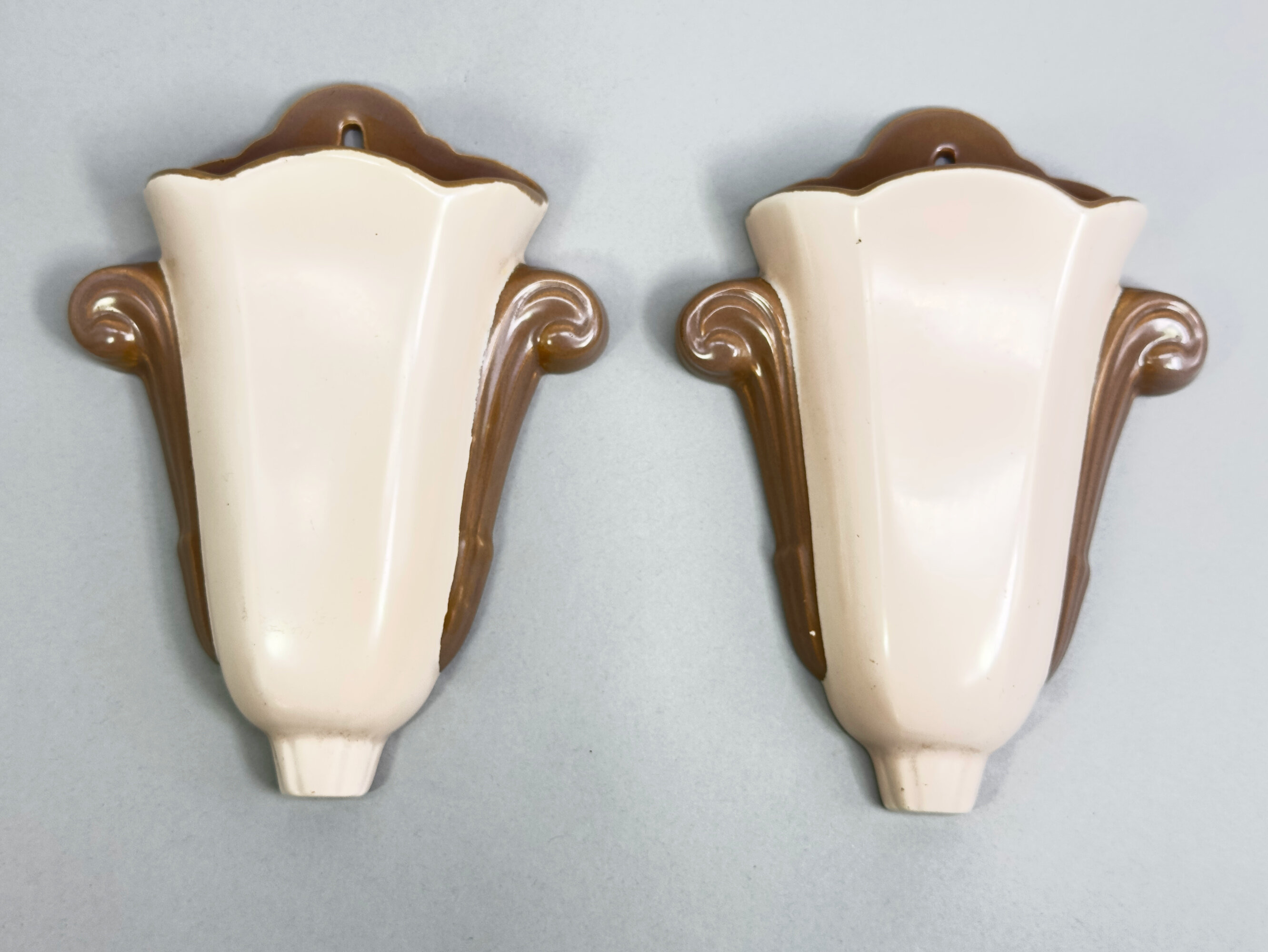
Pair of Art Deco style Wall Pocket Vases, Poole Pottery, mid C20th
Price: £55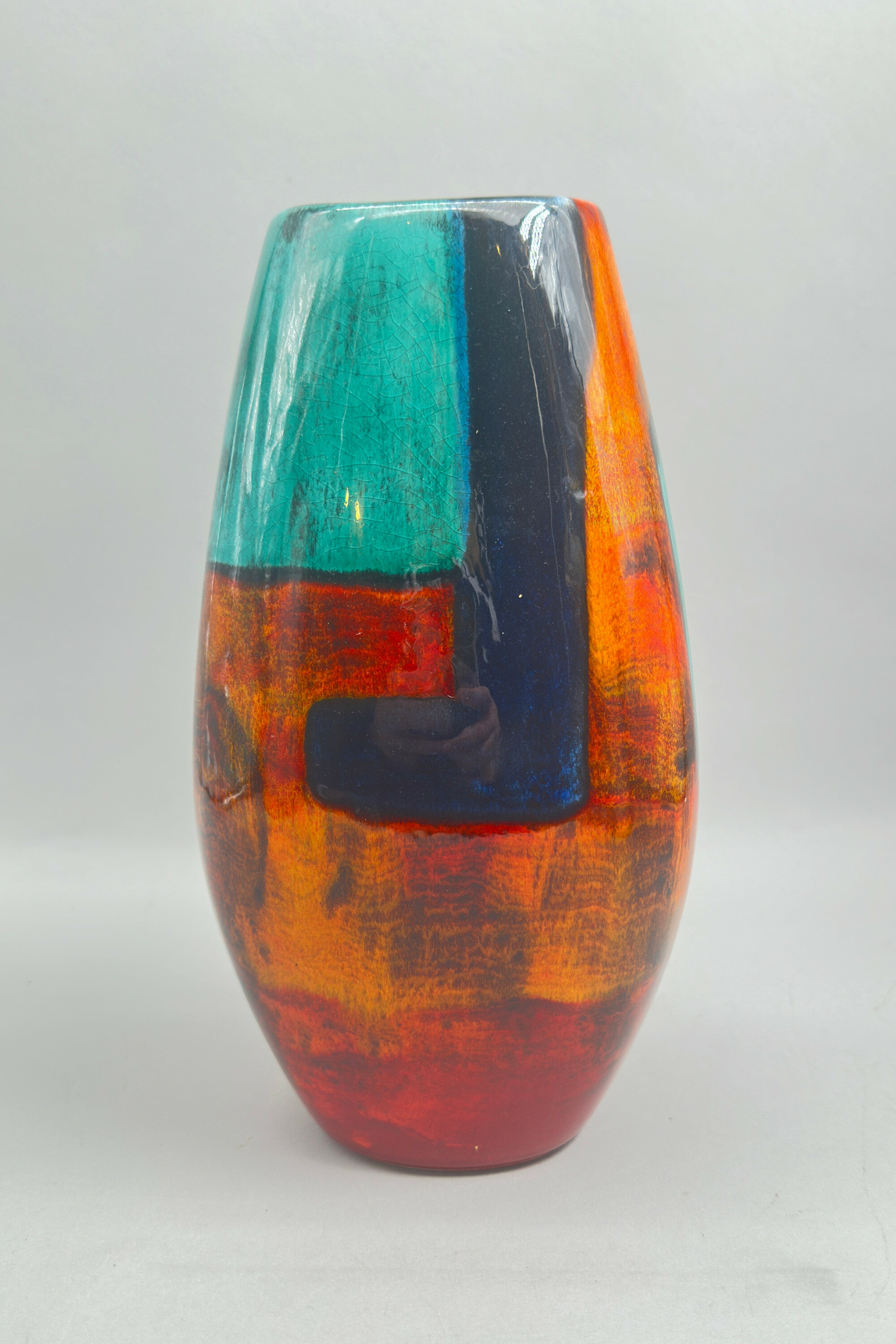
Poole Pottery Gemstones Vase, late C20th
Price: £75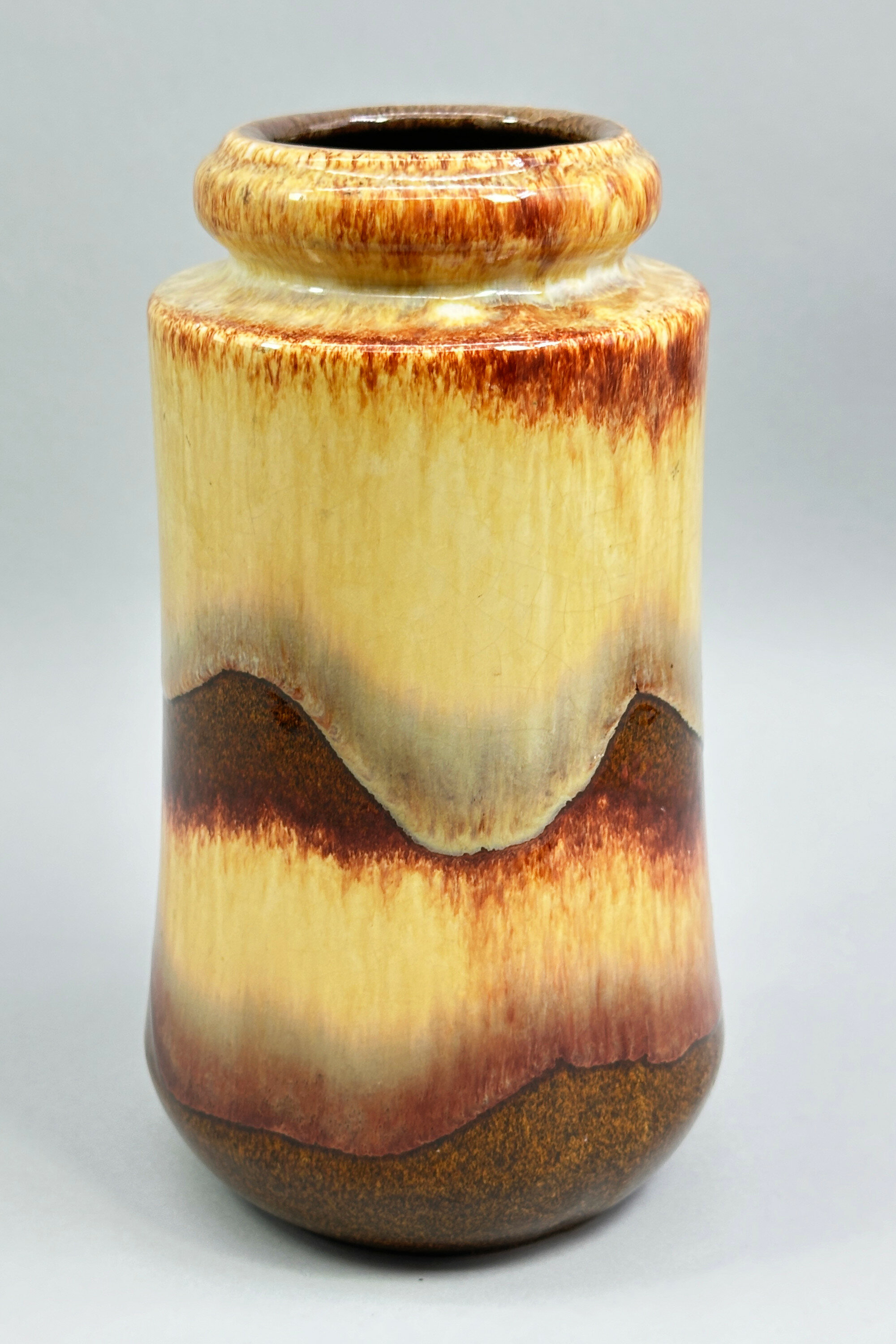
West German Studio Pottery Vase, Scheurich, 1960s
Price: £35
West German Pottery Lava Glaze Vase, Scheurich, 1960s
Price: £45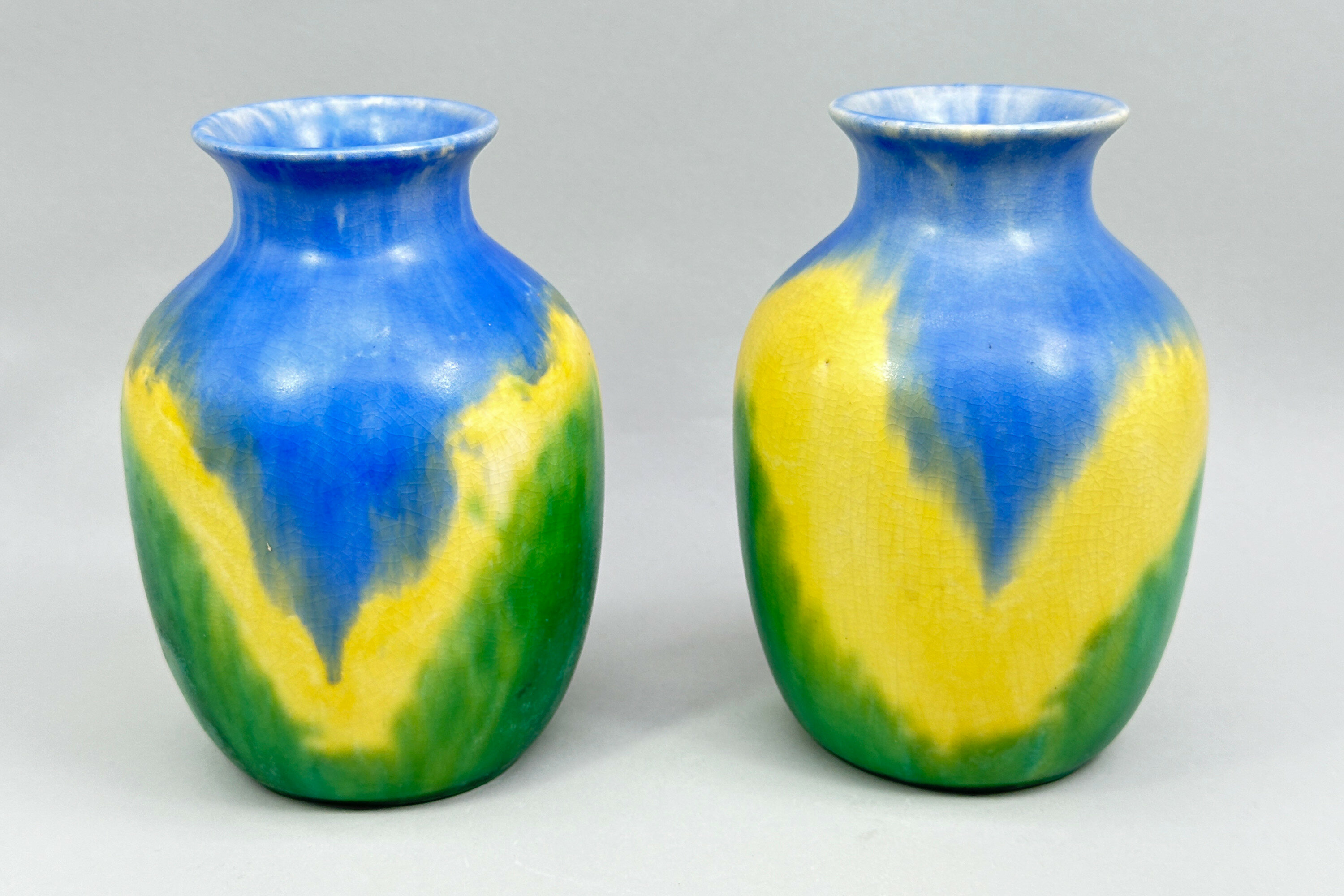
Pair of Art Deco style Avon Ware Vases, 1930s
Price: £45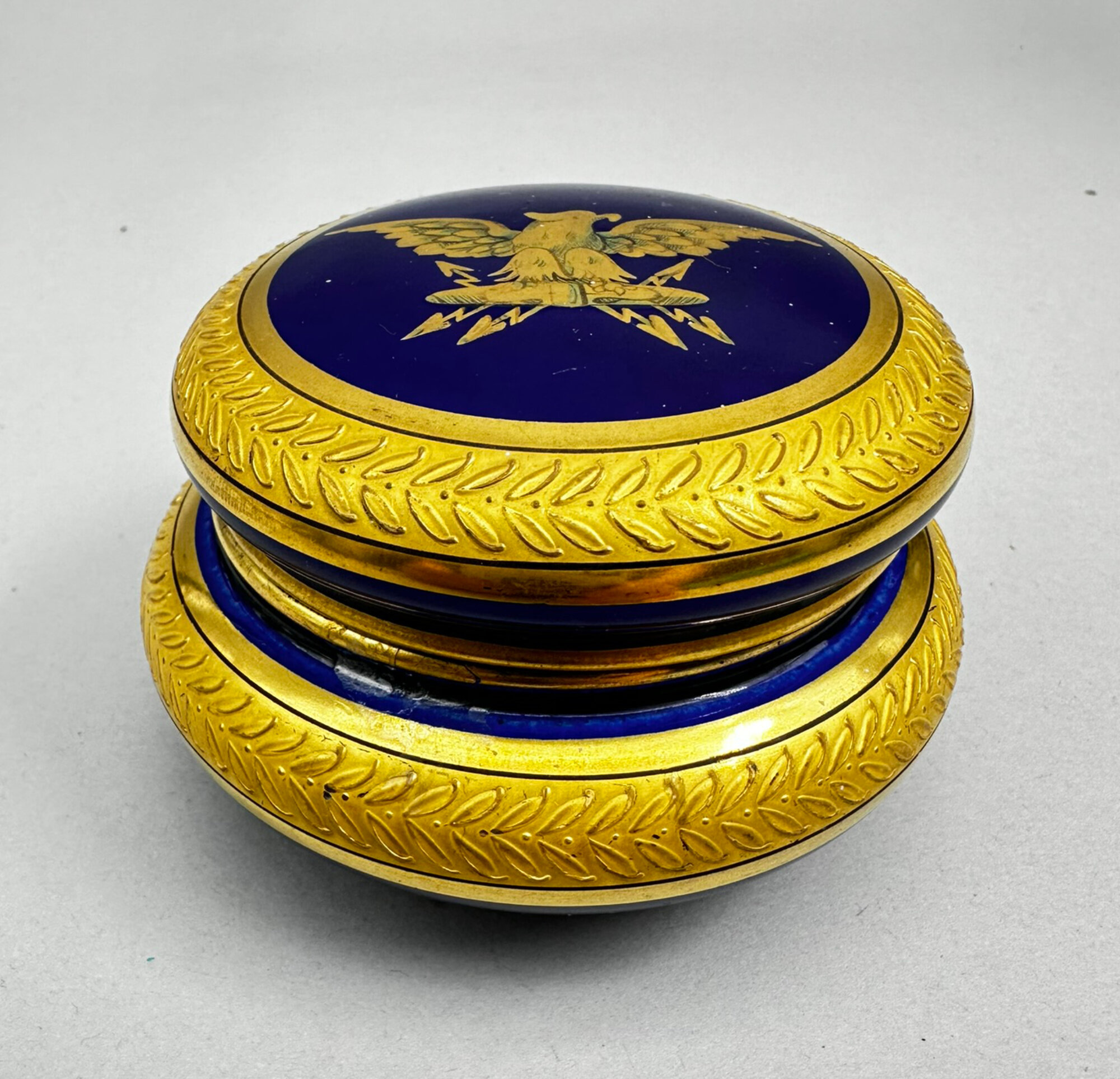
Blue Ground Empire Style Powder Box and Cover, Jean Pouyat, Limoges circa 1900
Price: £75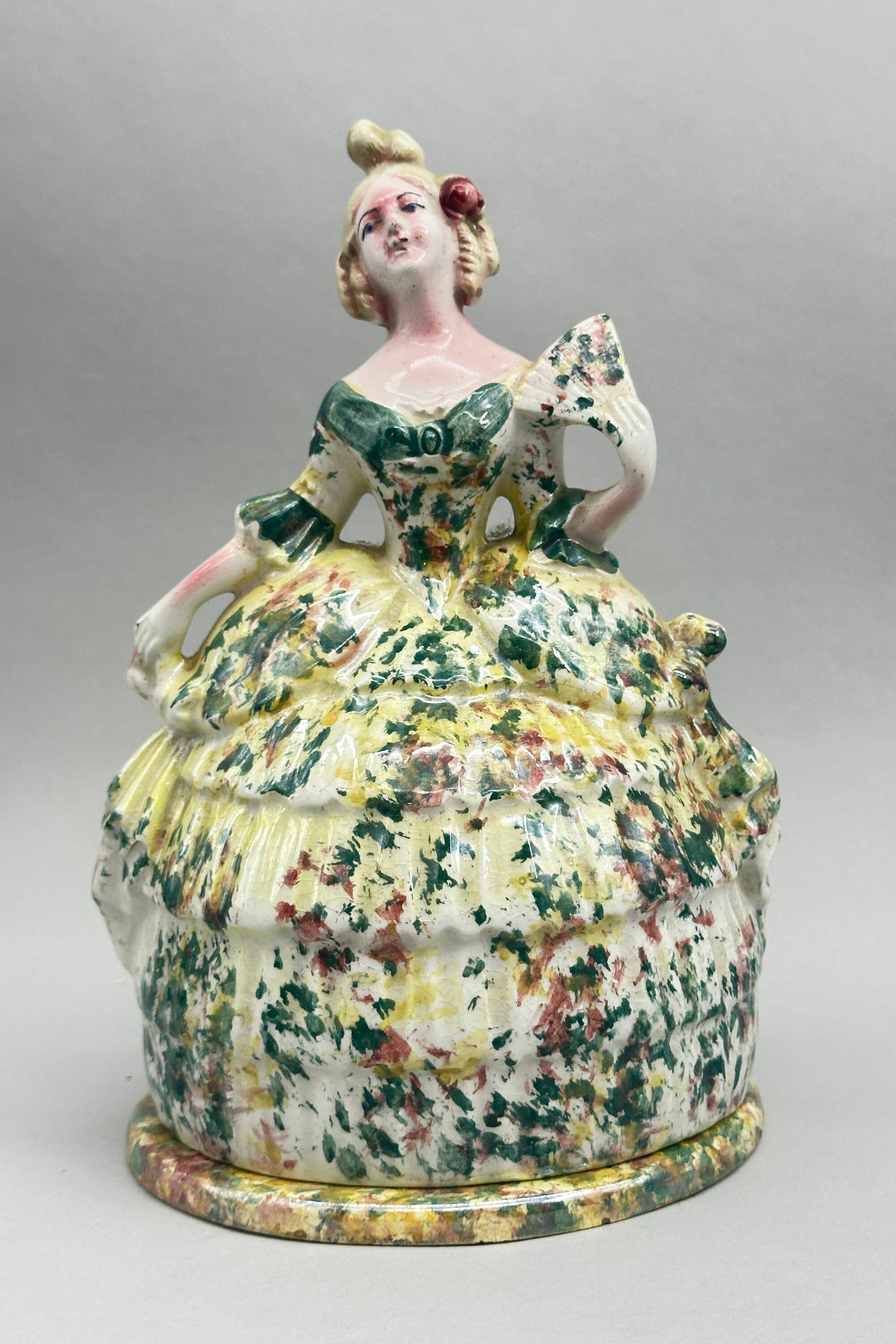
Lustreware Vanity Box, Lady in Crinoline, probably continental early/mid C20th
Price: £35
Continental Figure of a Cellist, Conta and Bohme, Germany late C19th
Price: £55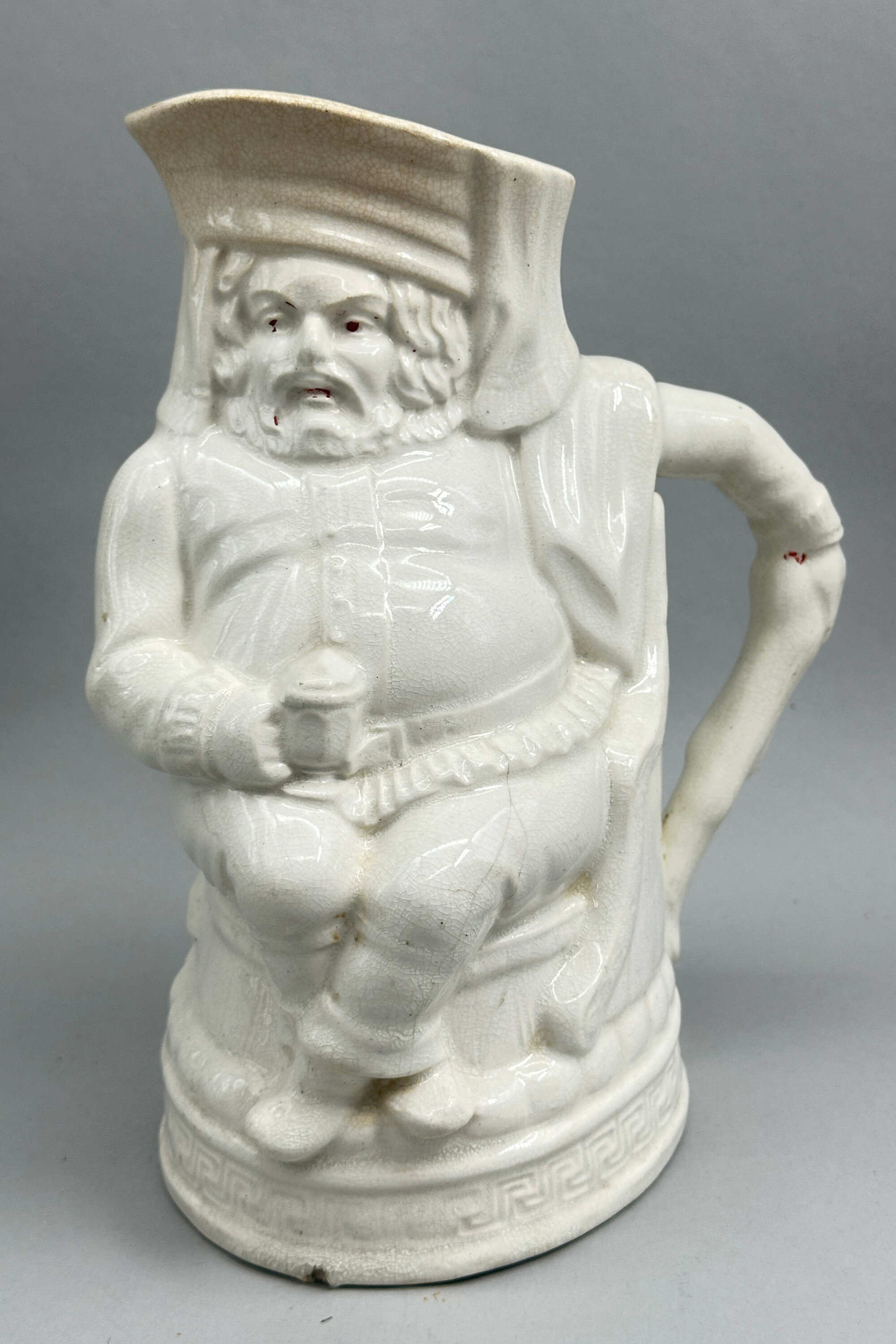
Earthenware Jug, Falstaff or Old King Cole, Furnival and Clark, mid C19th
Price: £75The design for this jug, usually termed ‘Falstaff’ but sometimes ‘Old King Cole’ is known to have been registered (Rd.No. 32601)by the firm Furnival and Clark on December 30th 1845. This was a very short lived partnership between Thomas Furnival and Richard Clark, based at the Stafford Street Pottery Works, Hanley, Staffordshire and which traded from 1844 to 1846 apparently producing just this one model, albeit in a variety of colours. Thomas Furnival had been involved in other firms before this brief venture and was to be involved in others afterwards. The dating of these mugs is usually attributed to the short period when Furnival and Clark traded but it is quite possible that more pieces were produced afterwards by Furnival himself. The paste and finish of this piece, though, which is not marked, certainly suggest a mid nineteenth century dating. In general, the model is quite rare. Some examples were fitted with a Britannia metal or pewter lid but this was never integral to the piece. This striking composition, then, is a rare and desirable item collectors with an interest in British Staffordshire wares.
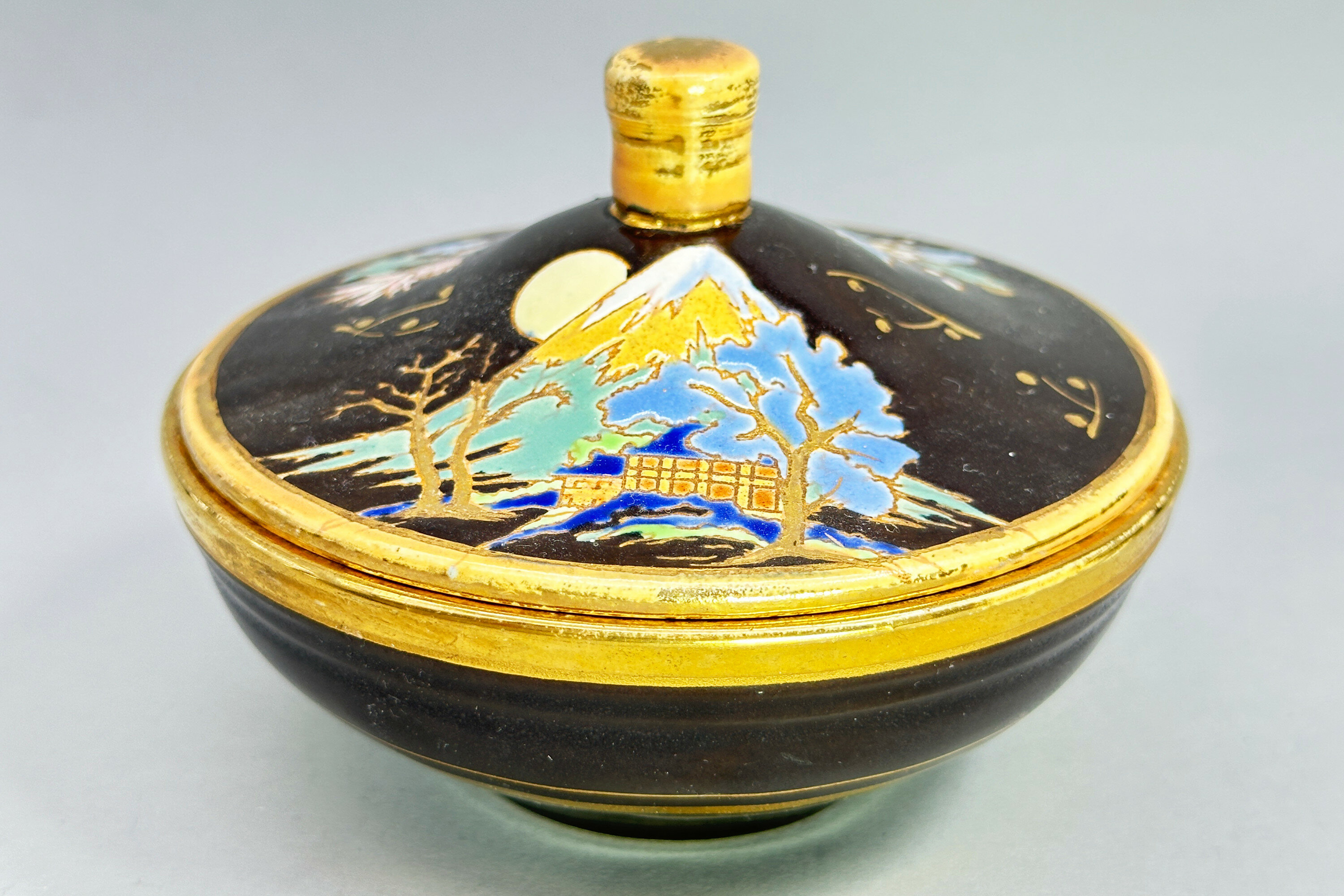
Cosmetic Box with Japonaiserie Decoration, Boch Freres, early C20th
Price: £45The firm Boch Freres Keramis was founded by Eugene and Victor Boch and their brother-in-law, Jean Baptiste Nothomb, in 1841 and was located in La Louviere in eastern Belgium. In 1906 Charles Catteau joined the company as artistic director and was responsible for a new and wide ranging series of designs, some under the influence of Japonisme, transitioning the company from producing utilitarian objects to highly decorative ceramics. His work can clearly be seen here in a piece which appears to be quite unusual. Both the form and the decoration reflect early twentieth century fashion in the clean lines and the images inspired by Japan. There is a hint of the aesthetic movement here producing an object of great attraction and interest.
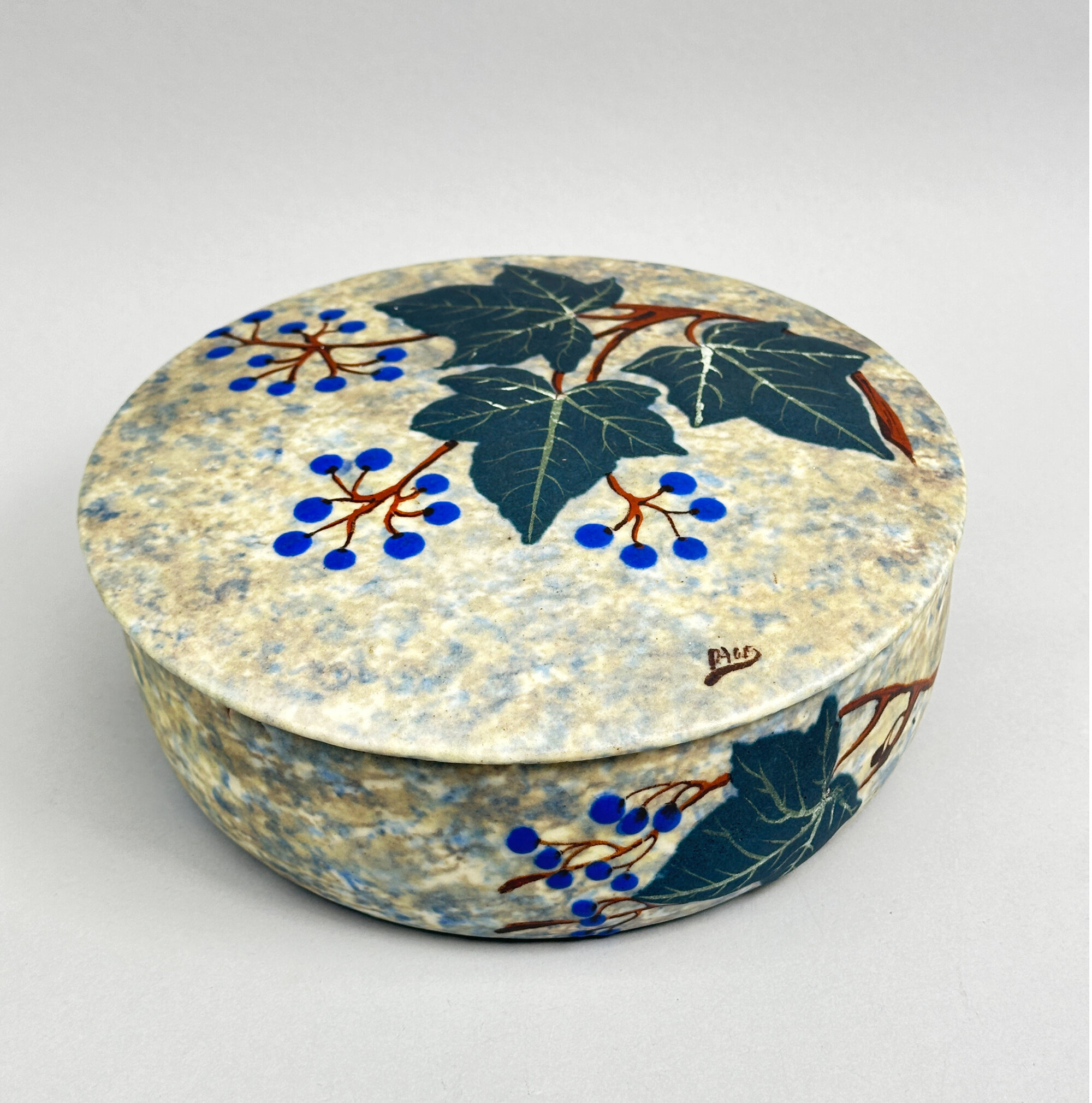
Art Deco style Ceramic Bowl and Cover by Louis Dage (1885-1961), early/mid C20th
Price: £180……………………………………………………………………………………....................................................................................……
Born in 1885 at Lille, France, Louis Dage was early known as a ceramics artist, describing himself on the birth registration of his daughter in 1906 as a ‘decorator on faience’. In 1920 he joined with Louis Fontinelle (1886-1964) to create a faience factory in Antony, near Paris, but the venture was short lived and they parted company two years later. In 1930, Dage set up his own studio at Saint-Sever in company with his brother and daughter becoming managing director of the firm three years later. There then followed a little over thirty years of production under his direction until his death in 1961. Art Deco designs with their simple lines and bold decoration were produced initially to be followed by pieces of more rugged shapes and patterns, partly resulting from the shortage of conventional raw materials during the second world war.
This bowl and cover represents the best of Dage’s earlier work. The base has straight sides curving in slightly towards the base and has a flush fitting flat and gently domed cover overhanging slightly at the edge. The piece is covered overall with a mottled glaze in tones of blue and light aubergine on which are painted maple leaves in green with bright blue berries, a design which can be found on some of Dage’s other pieces (see image 13). The lid carries his signature ‘DAGE’ with a flowing line underneath, a much less common version of the Dage mark but which can be found elsewhere (see image 14). More normally pieces are signed ‘L.Dage’, the name being in lower case rather than capitals.Form and decoration combine to produce a striking object, characteristic of the fashions of the time of its production and a worthy tribute to its maker.
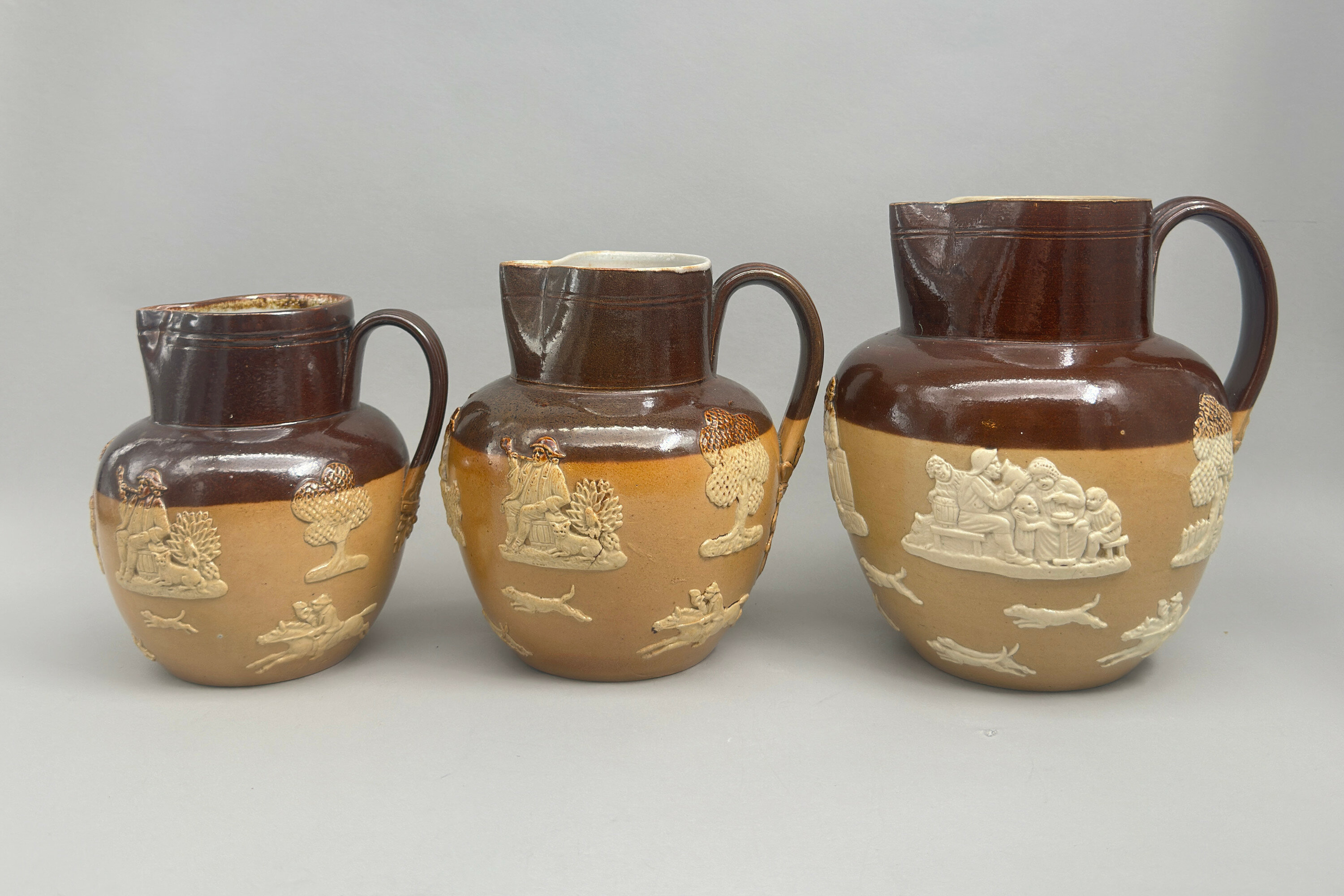
Graduated set of three Royal Doulton Harvest Pattern Jugs, early C20th
Price: £150While this model, often called the ‘harvest pattern’, is found quite often, it is very unusual to see a graduated set of three, all matching. The form of the mark, where the lion does not sit above a crown, was used between 1922 and 1927 which gives us the dating here. The largest jug carries the letter ‘a’ which was a decorator’s mark and stands for Louisa Ayling. Perhaps she worked on all three, but this must remain a guess although the quality of the work on all three is quite consistent producing a highly decorative and attractive ensemble.
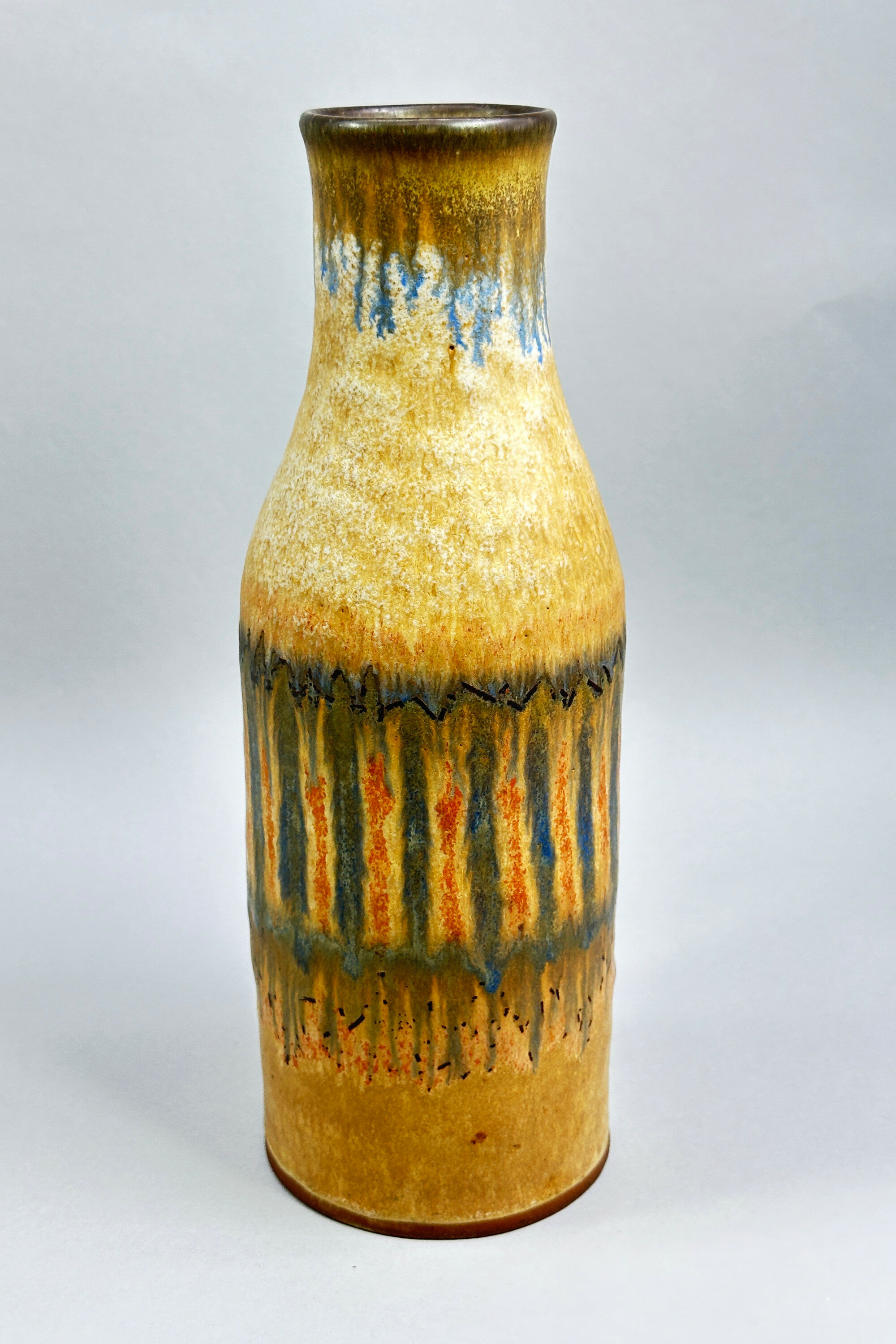
Studio Pottery Vase signed Kamini, Greece, 1970s
Price: £45Although ‘Kamini’ is both the Greek word for a kiln and the name of a village on the Greek island of Hydra, it actually stands here for the Greek firm of that name whose registered office was at Kallithea, a suburb of Athens. The Kamini pottery produced a wide range of appealing but often slightly rustic wares in the 1970s, many with the splash glaze effects we see here and all stamped with the firm’s name. This vase stands out somewhat for the simple lines of its form and the variety of effects in its decoration with a particularly pleasing palette of colours and demonstrates that this Mediterranean pottery could well rival at times the work of some of its European competitors.
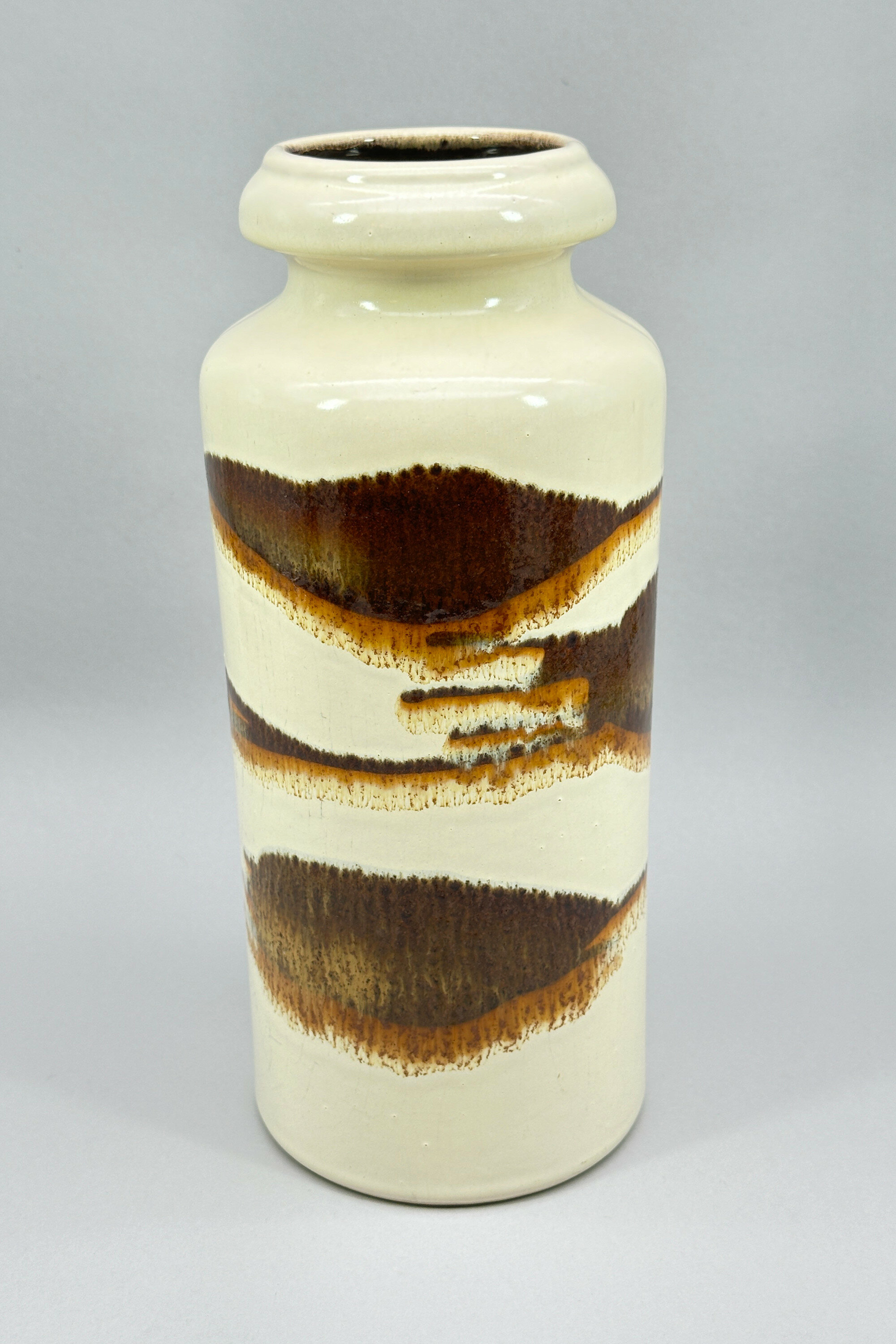
West German Vase with drip glaze decoration, Scheurich, 1960s
Price: £45Although not marked as such, this vase has all the hallmarks of the firm Scheurich Keramik which started production in 1954, rather later than most of its competitors, but soon became the largest producer of commercial art pottery in Germany. Their pieces rarely carried the factory name but usually the model number followed by the height in centimetres with ‘W-Germany’ below, as here. Model ‘517’ can be found in a variety of different glazes but the colourings here with the contrast between browns and cream are particularly successful. Dating is to the 1960s.
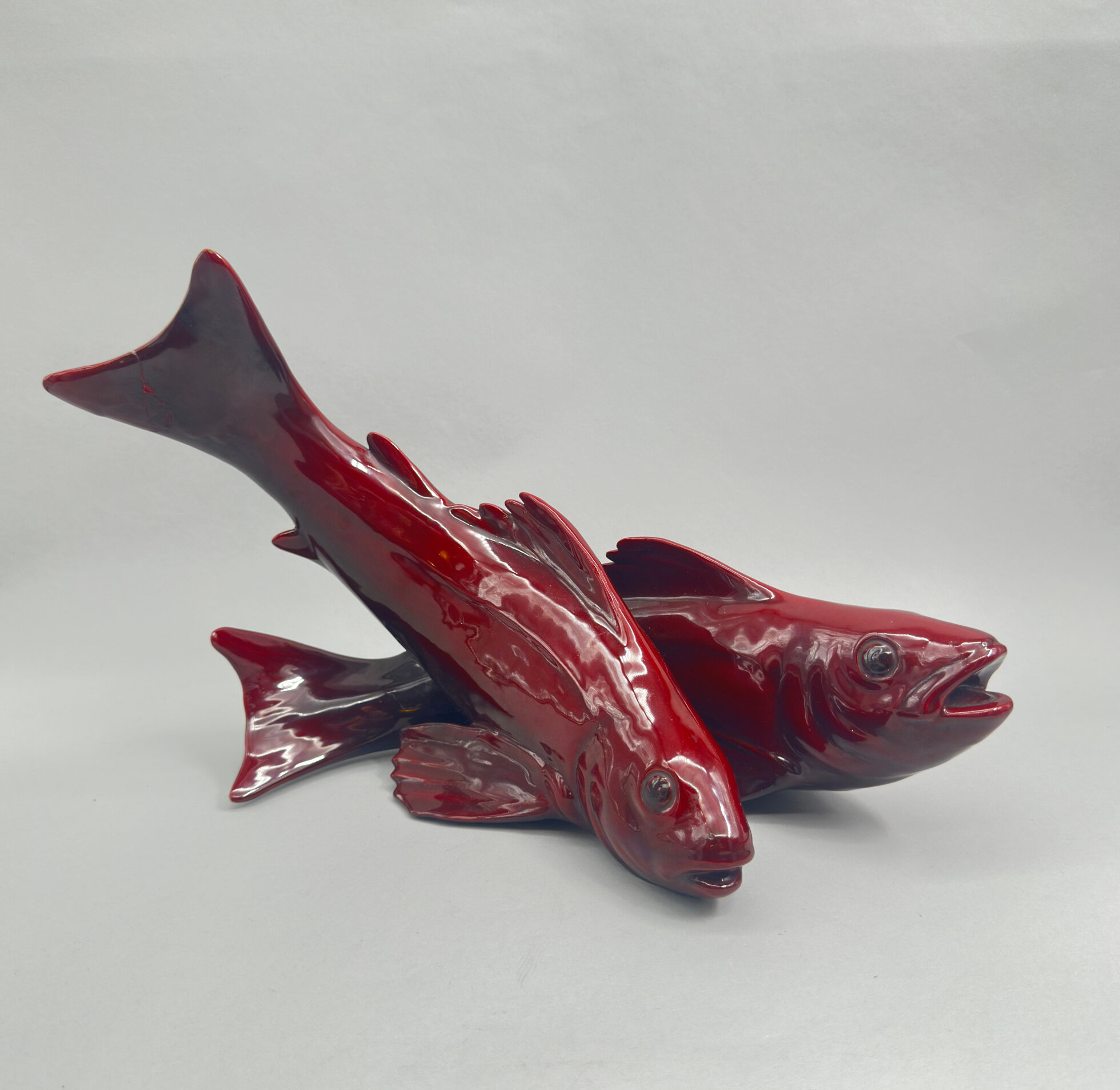
An Art Deco ceramic group of two Fish by Guido Cacciapuoti, signed, 1930s
Price: £150Guido Cacciapuoti was a celebrated Italian ceramicist. Born in Naples in 1892 and from a family with a tradition in the creation of majolica pottery, Guido exhibited his work widely in the 1920s and finally, in collaboration with his brother, Mario, and Angelo Bignami as the administrative and commercial director, he founded the factory ‘Gres d'Arte Cacciapuoti Bignami & C.' in Milan in 1927. Mario unfortunately died three years later leaving Guido to carry on on his own until his death in 1953.
In the 1930s, Guido’s workshop became famous for the production of ceramic animal sculptures with fish being a particular speciality. More commonly seen are groups of John Dory, again with a red glaze, but the smoother lines here and the particularly intense colour reflect more closely the contemporary Art Deco style. Sought after in their own time, with patrons such as the King of Italy and Mussolini, Guido’s works are highly collectible today and this group would make a striking addition to a collection of Art Deco ceramics with considerable decorative appeal.
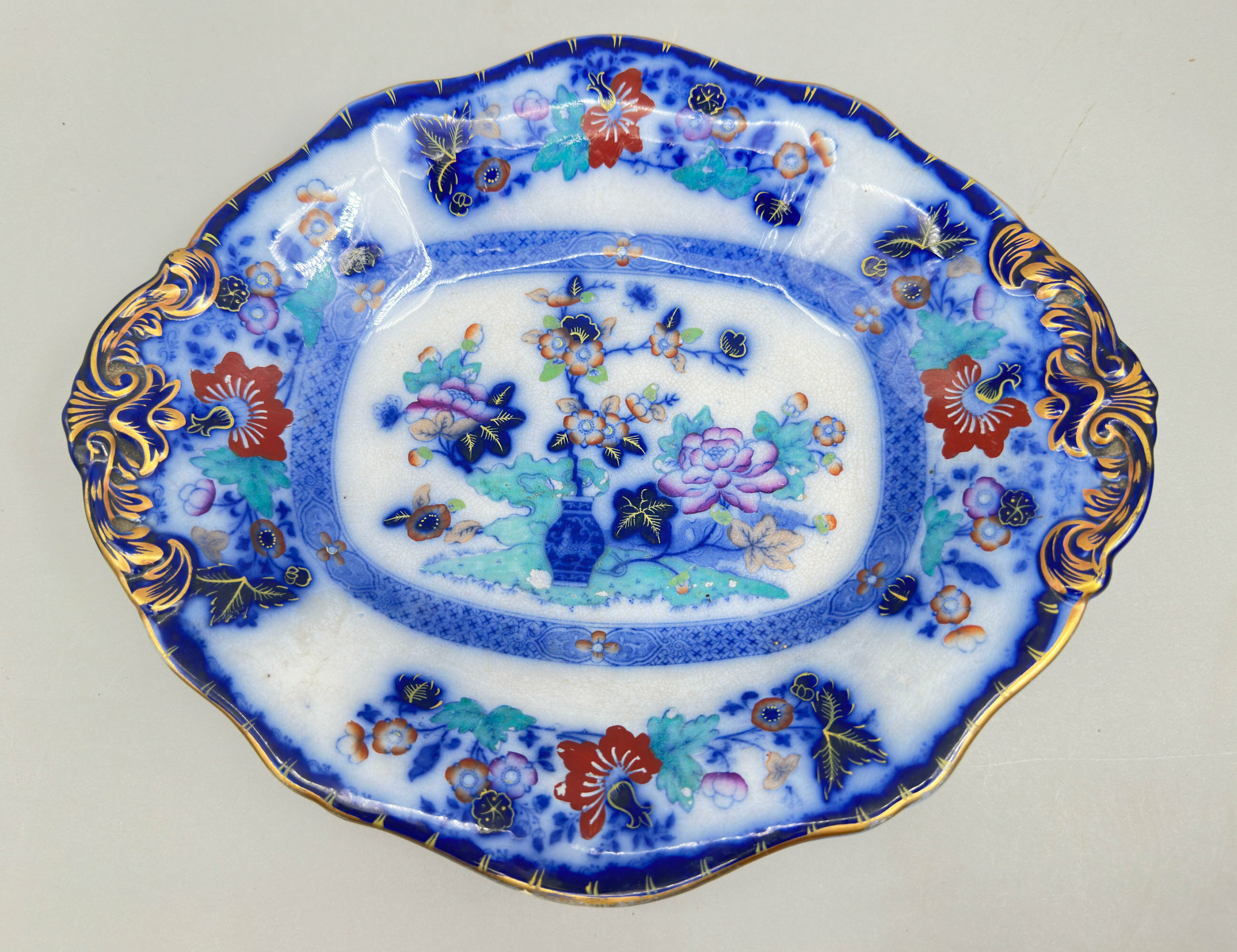
Bombay Japan pattern deep Dish, Minton or Samuel Alcock, English mid C19th
Price: £25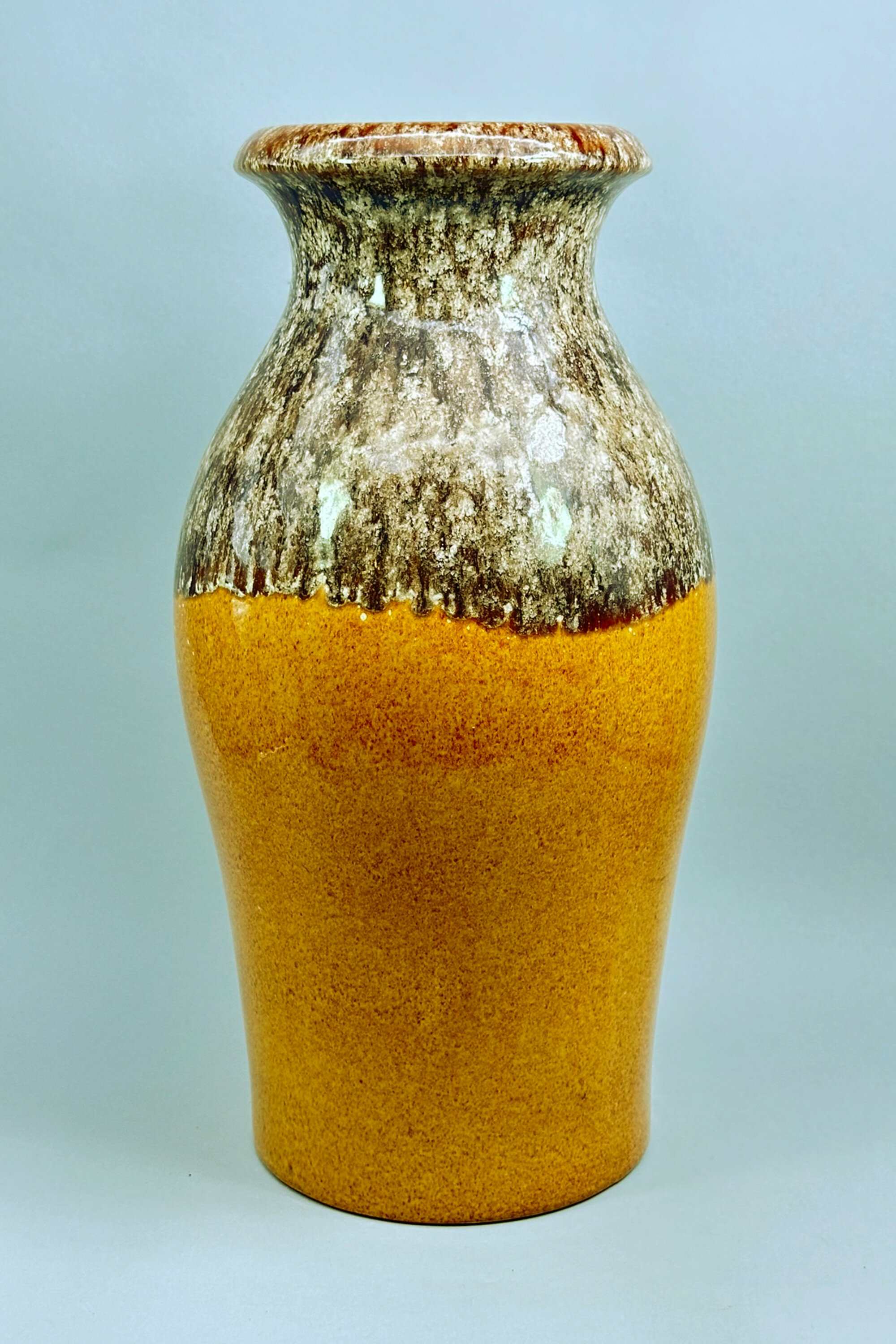
West German ceramic Vase, Scheurich, No 290-40, 1960s
Price: £55Although not marked as such, this vase has all the hallmarks of the firm Scheurich Keramik which started production in 1954, rather later than most of its competitors, but soon became the largest producer of commercial art pottery in Germany. Their pieces rarely carried the factory name but usually the model number followed by the height in centimetres with ‘W.Germany’ below, as here. Scheurich were well known for producing a wide variety of pieces with variegated, almost experimental glazes and this vase is yet another successful example of their work, the simple lines of form combining with a more austere selection of glaze effects than found in some of their other pieces. Dating is to the 1960s.

Continental Earthenware Vase with geometric motifs in the style of Amphora, C20th
Price: £45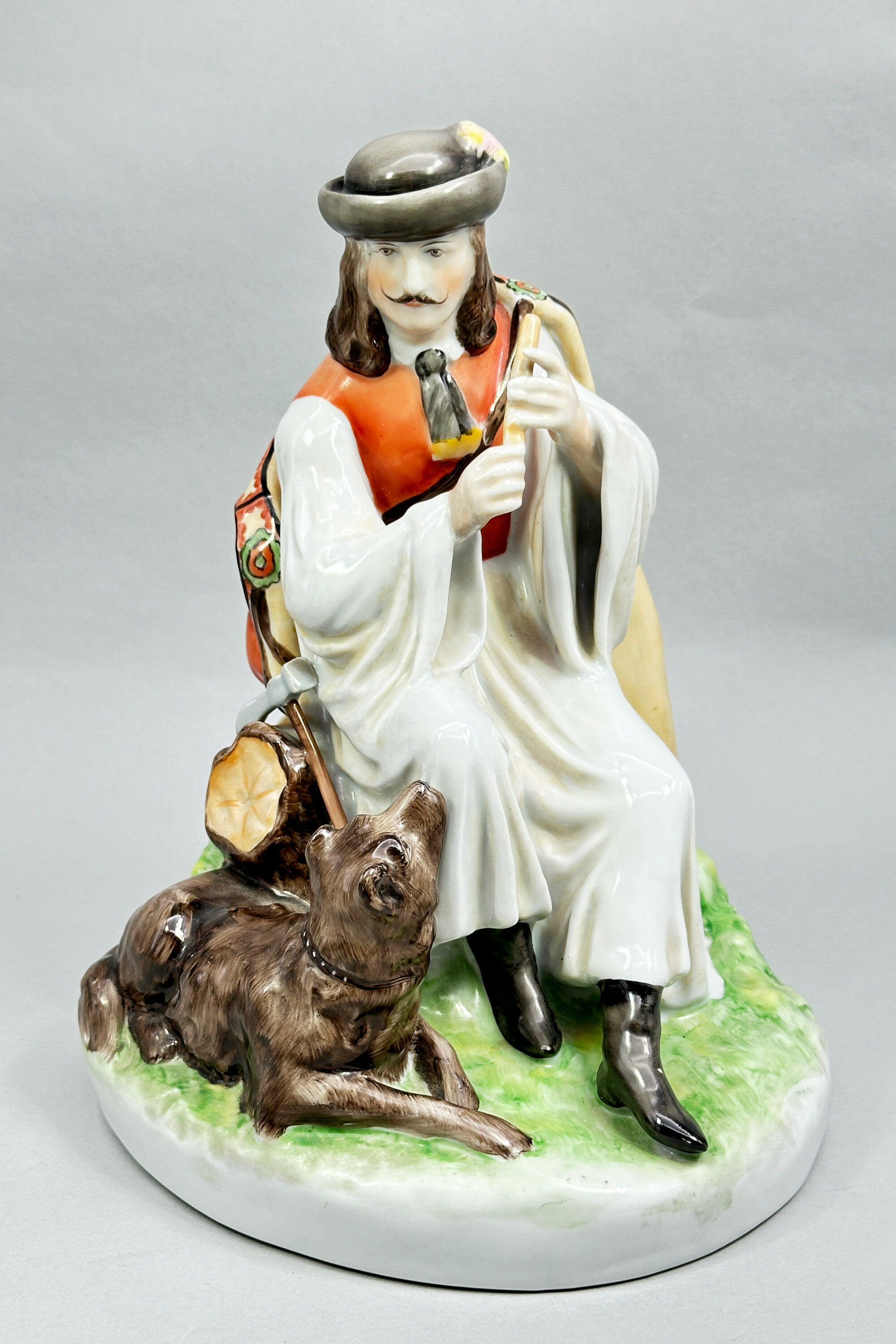
Figure of a Seated Huntsman, Zsolnay Pecs, 1970s
Price: £55The mark is for the well known ceramics manufacturer Zsolnay, based in Pecs, Hungary. Founded by Miklos Zsolnay in 1853, the firm gained a worldwide reputation in the late nineteenth century exhibiting at international fairs and exhibitions. Production declined after the first world war and the factory was bombed during the second. Revived under communism in 1948, the firm started to produce utilitarian pieces under the name ‘Pécs Porcelain Factory’ but gradually their traditional wares were revived and the Zsolnay name was restored in 1982.
This figure is one of the products of Zsolnay’s late renaissance but dating to the 1970s, as indicated by the form of the mark, it still carries only the Pecs brand name. But the quality typical of Zsolnay is emphatically there with fine quality porcelain and careful modelling and decoration all combining to produce a most decorative and attractive composition.
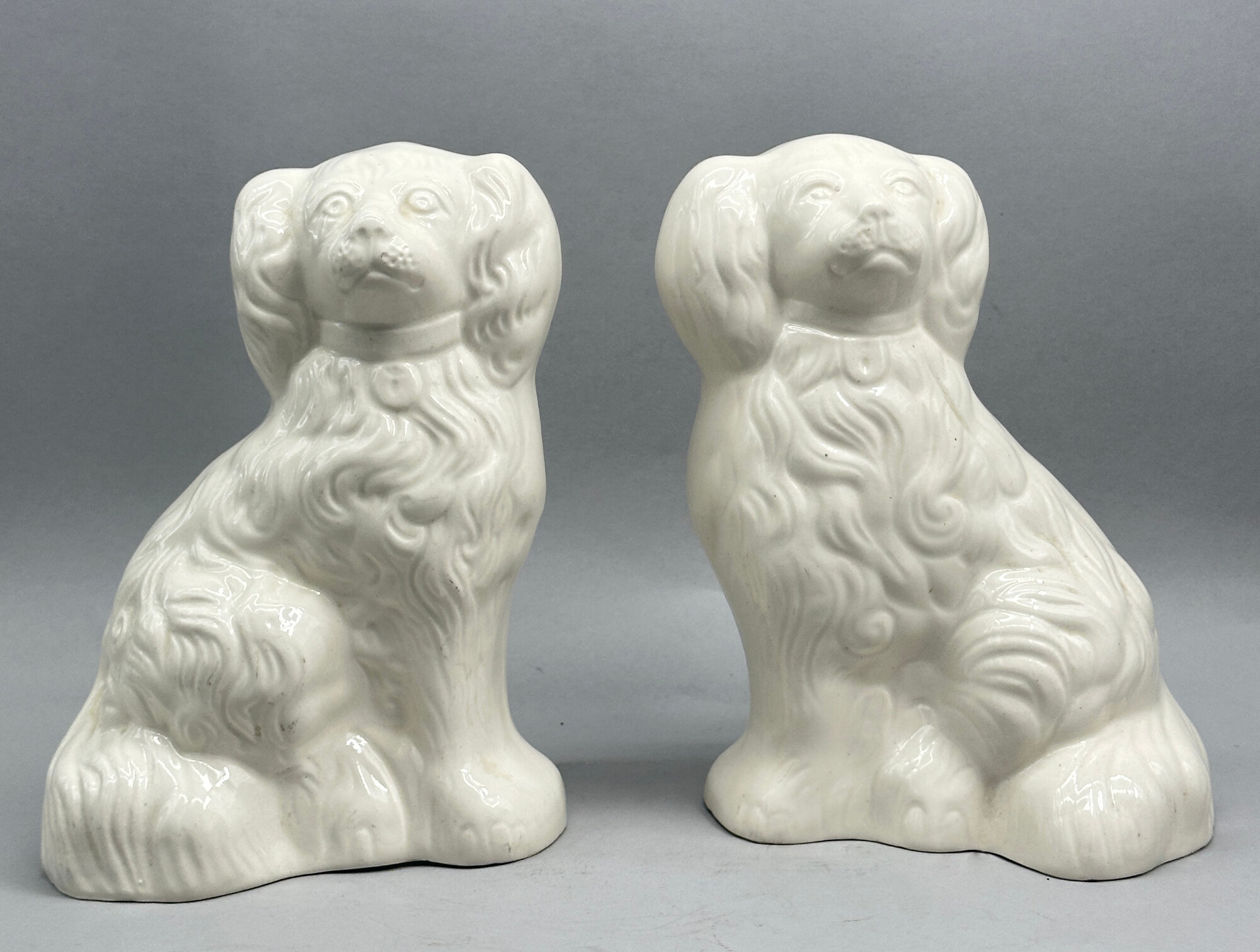
An unusual pair of white glaze models of Spaniels, Beswick, 1960s
Price: £75While a close relation to the traditional Victorian ‘Staffordshire Dog’, these figures were actually made by the English firm Beswick in the twentieth century. Founded in 1894 by James Beswick and his sons, the company became known for its output of figurines, eventually securing the rights to producing characters from the novels of Beatrix Potter and the films of Walt Disney. It was sold to Royal Doulton in 1969 who continued production until 2002, selling the pottery premises in 2003 and the rights to the name in 2004 when they were bought by Dartington Crystal who still manufacture pieces carrying the Beswick name. These spaniel figures appear to date from the 1960s and were made in at least two sizes. Most have painted decoration but the plain white finish here is really the most pleasing of all producing a pair of decorative items with timeless appeal.
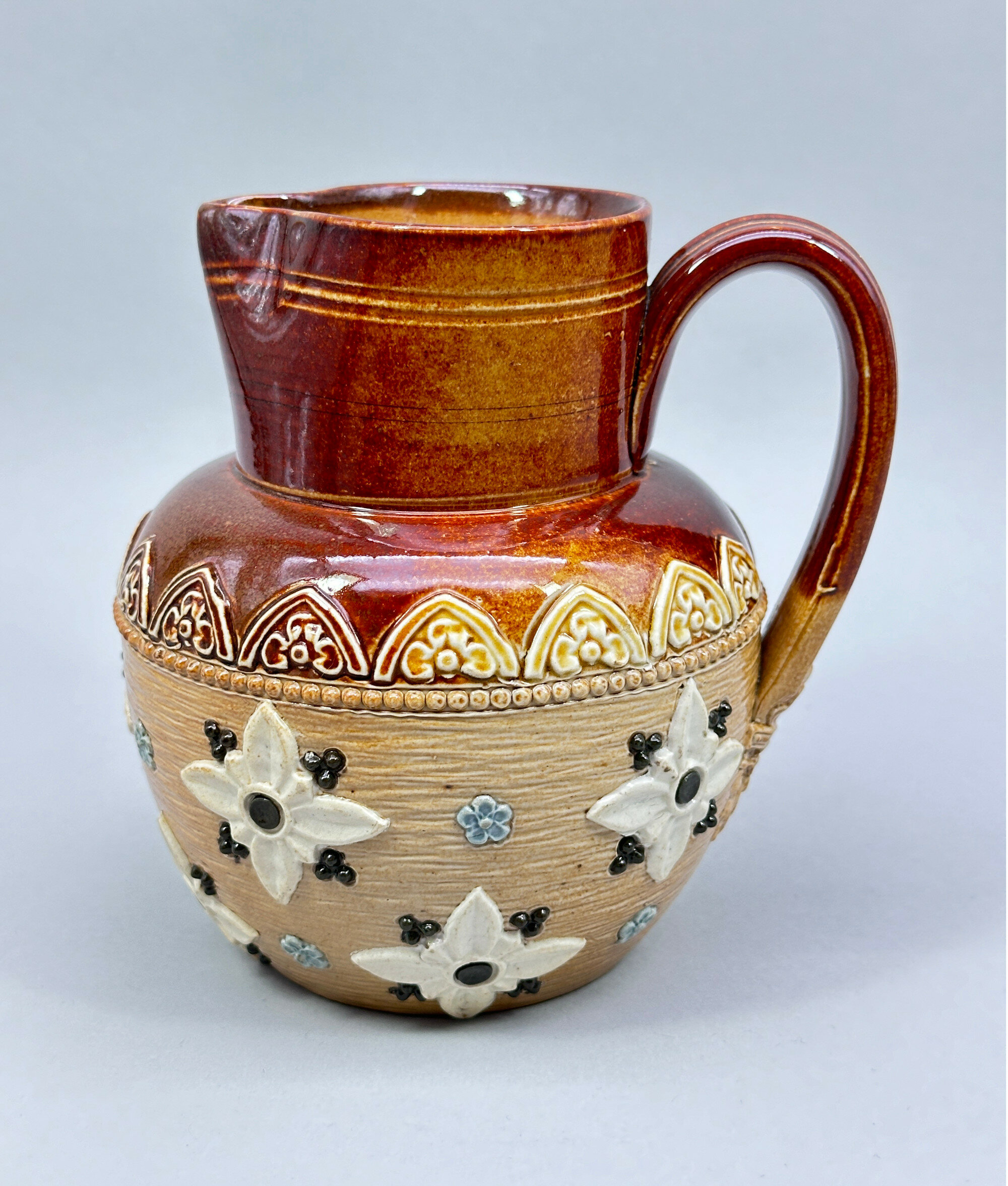
Doulton Lambeth Stoneware Jug circa 1900
Price: £45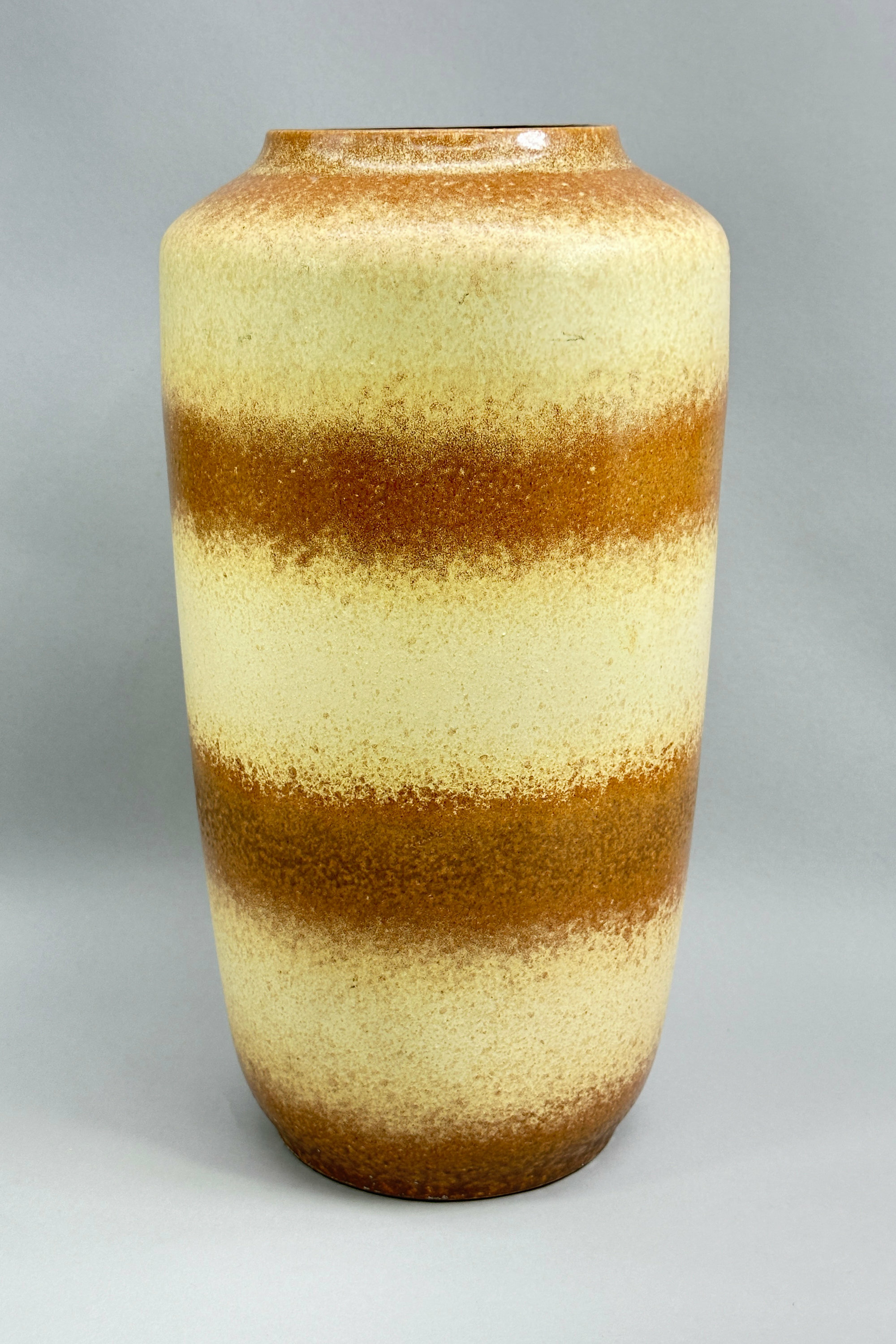
West German Vase, Model No 517-38, Scheurich, 1960s
Price: £55Although not marked as such, this vase has all the hallmarks of the firm Scheurich Keramik which started production in 1954, rather later than most of its competitors, but soon became the largest producer of commercial art pottery in Germany. Their pieces rarely carried the factory name but usually the model number followed by the height in centimetres with ‘W.Germany’ below, as here. Model ‘517’ can be found in a variety of different glazes but the pattern and colourings here, more muted than some of Sheurich’s work and with a matt finish, are particularly pleasing and complement the elegant form most successfully. Dating is to the 1960s.
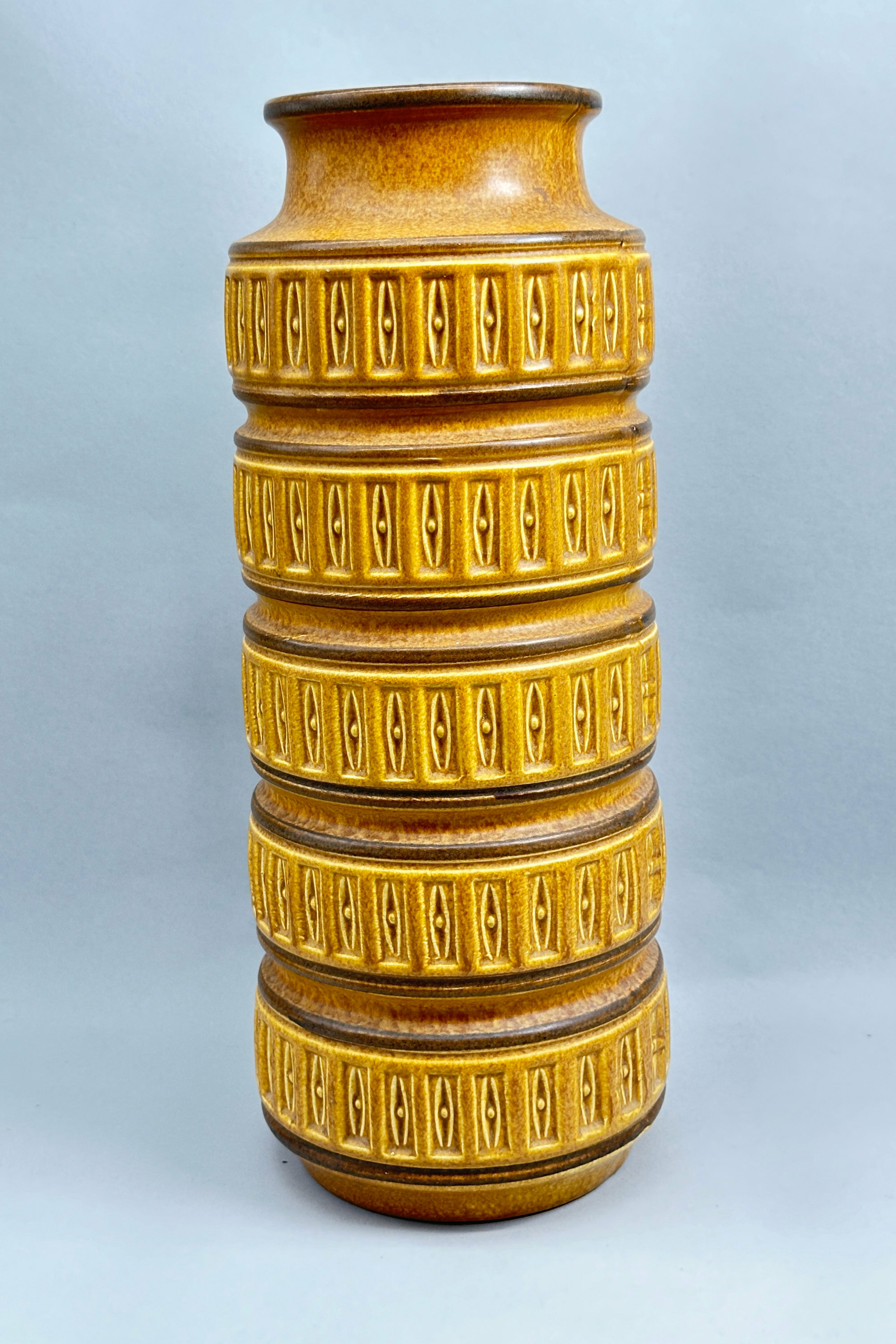
West German Vase, Model No 268-40, Scheurich, 1960s
Price: £75Although not marked as such, this vase has all the hallmarks of the firm Scheurich Keramik which started production in 1954, rather later than most of its competitors, but soon became the largest producer of commercial art pottery in Germany. Their pieces rarely carried the factory name but usually the model number followed by the height in centimetres with ‘W.Germany’ below, as here. Model ‘268’ (which sometimes occurs complete with a paper label for Scheurich and was made in at least two sizes) can be found in a variety of different glazes but the colourings here are amongst the most successful. Dating is to the 1960s.
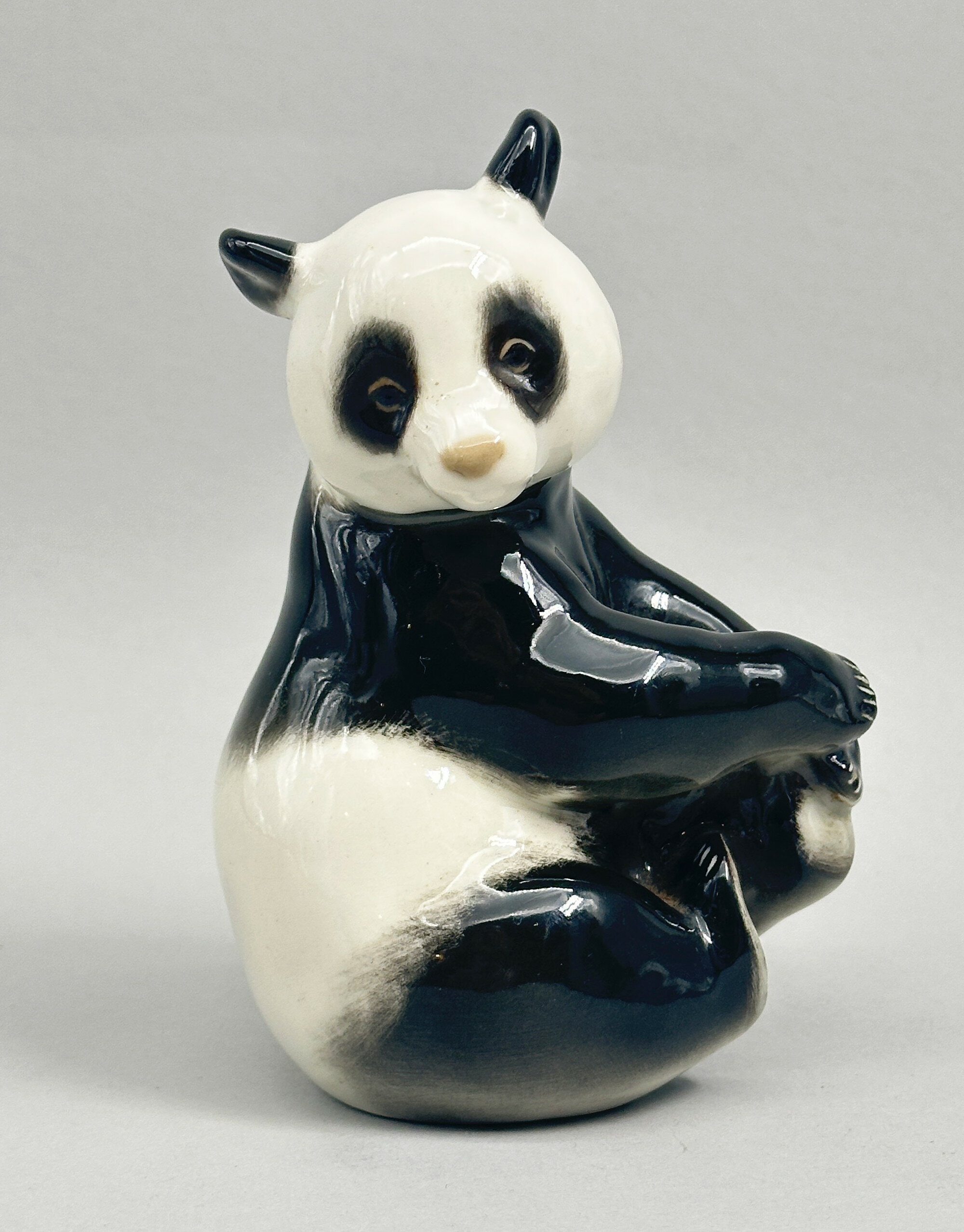
Porcelain Figure of a seated Panda, Lomonosov, USSR late C20th
Price: £25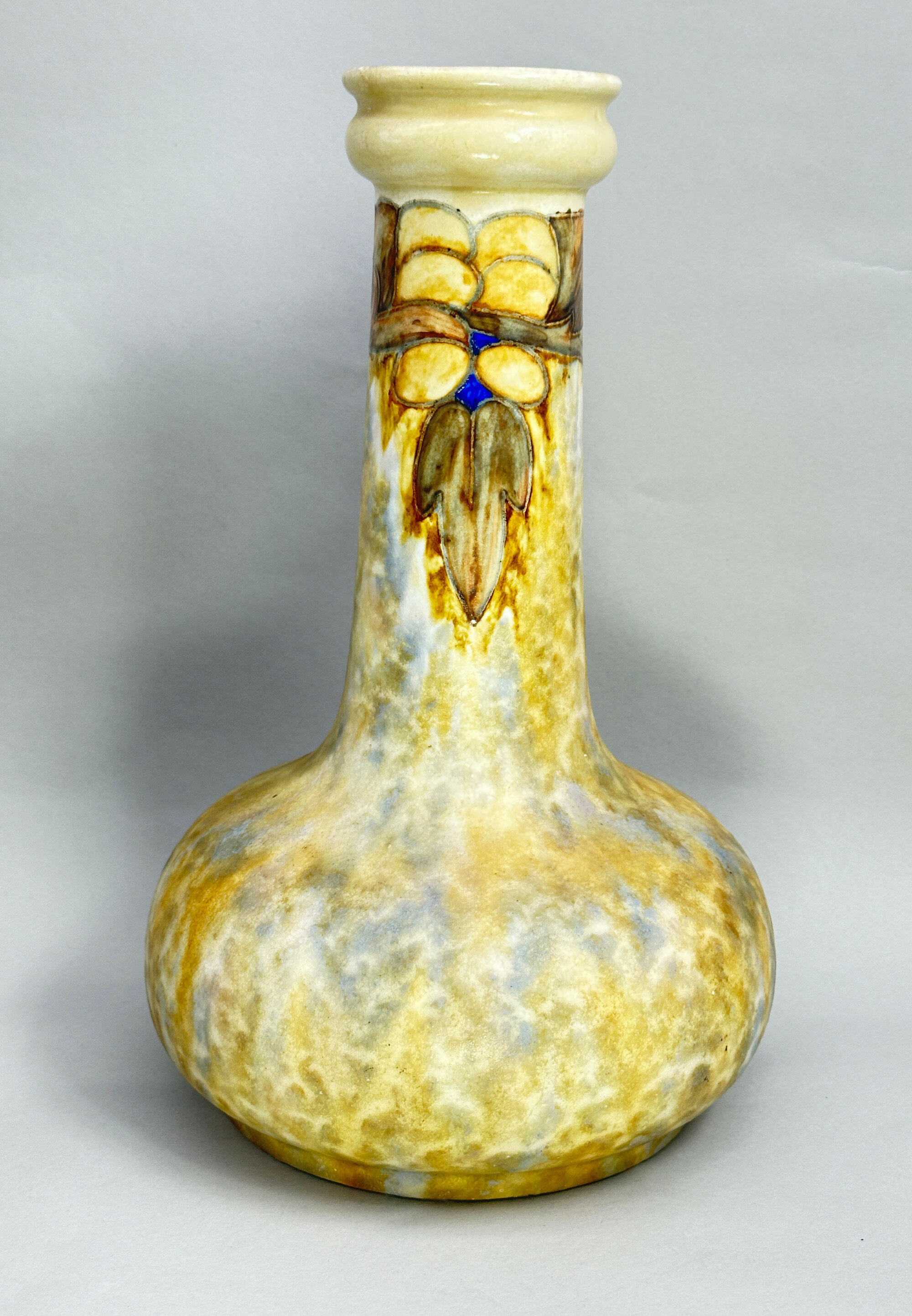
Cranston Ware Art Nouveau Style Vase, early C20th
Price: £95Cranston Ware was one of the ranges produced by the Pearl Pottery Company, based in Hanley, Stoke on Trent. Founded in 1892, the firm produced a varied selection of ceramic wares, often following contemporary fashions, until its closure in 1947. This vase is demonstrably in the Art Nouveau style and would have been produced when it was at its zenith in the early 1900s. The pattern was known as ‘Tukan’ ware and some of the pieces, but not all, have an impressed mark displaying this. This is an excellent example of the type with the glazes and decorative detail well rendered and certainly deserves the attention of collectors of Art Nouveau.
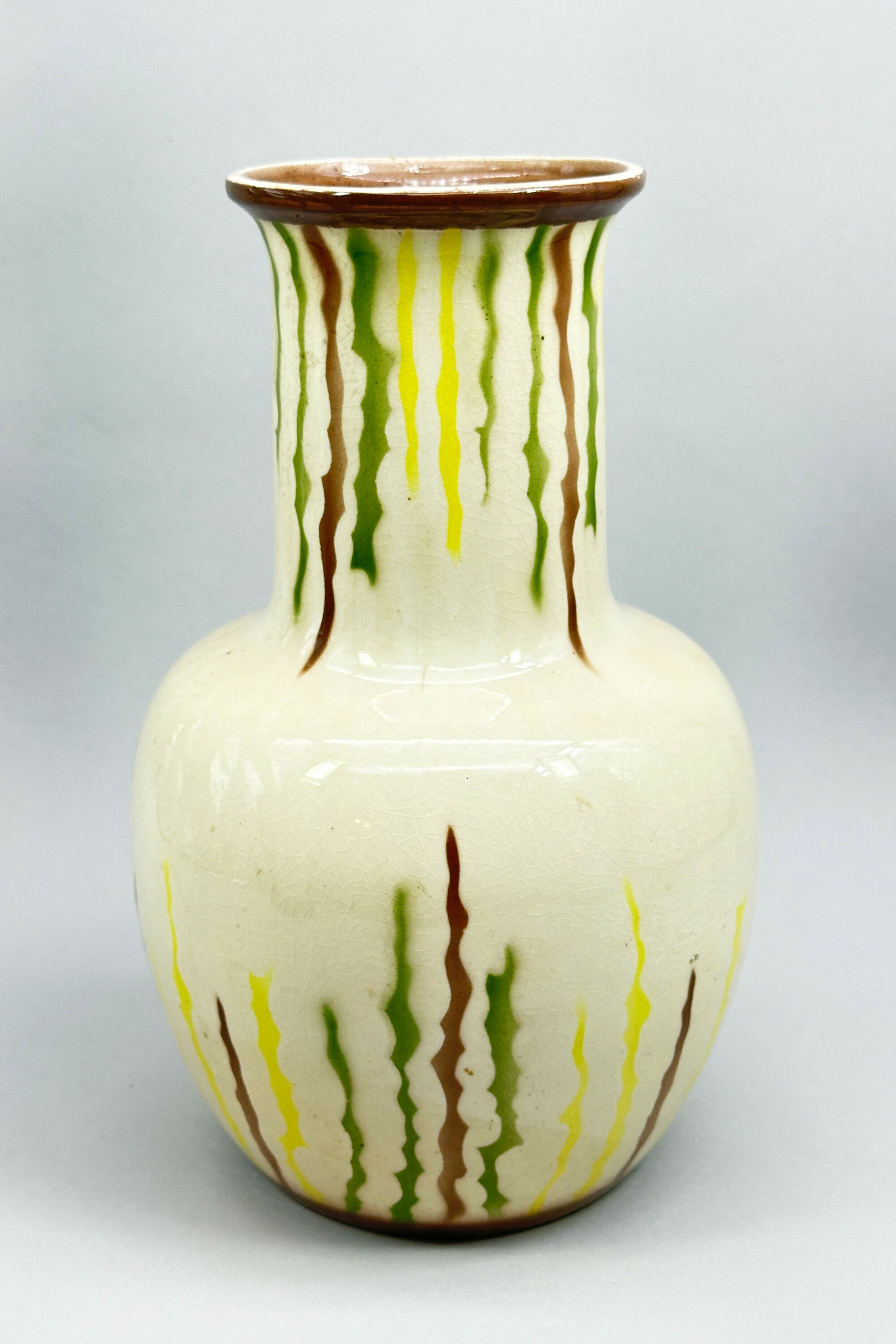
Art Deco style Vase signed E.Radford, mid C20th
Price: £75There were, in fact, two craftsmen working in the C20th British pottery industry with the name Edward Radford, father and son. Radford senior worked for Pilkington’s Royal Lancastrian Pottery in Manchester from 1903 until his retirement in 1936, acting as their main thrower. Radford junior joined his Father in 1905, but the First World War intervened, in which he won a Military Cross for his actions at Passchendaele in 1917 and afterwards he settled in Stoke on Trent, the heart of Britain’s pottery industry. An association developed with H.J.Wood’s Alexandra Pottery in Burslem who produced a range of wares bearing his name in the 1930s, although Radford himself may have acted as more a salesman than the designer. Production continued after the war and even after Radford’s retirement in 1948. The form of mark used here implies the later dating but may have been used earlier. The impressed figures indicate model number. Even if this vase is post war, the style is emphatically that of pre war Art Deco period with the simple lines of the form accompanied by semi abstract decoration vaguely reminiscent of Clarice Cliff combining to produce a piece of timeless attraction.
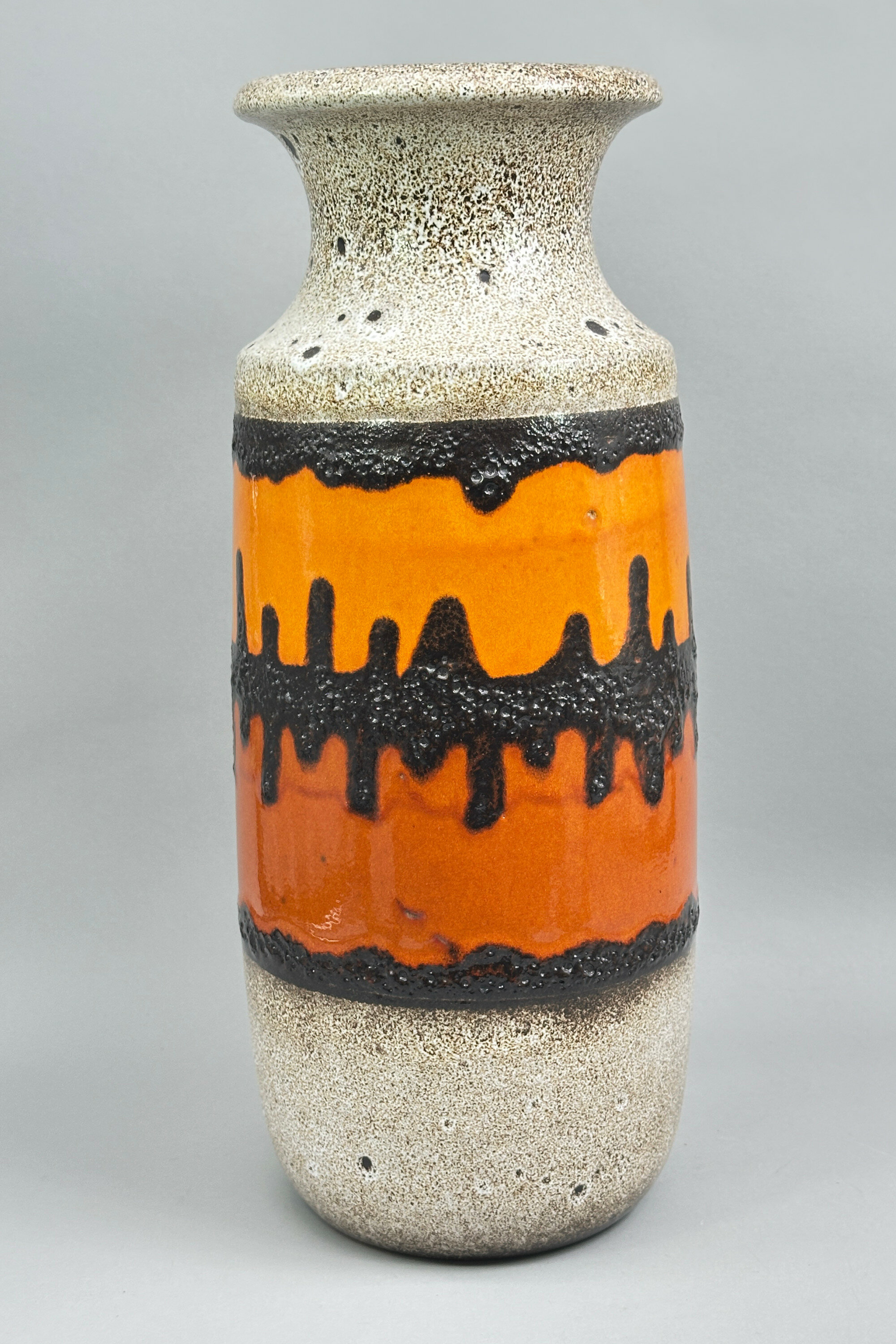
West German Studio Pottery Vase, Scheurich 259-41, 1970s
Price: £150……………………………………………………………………………………….....................................................................................… .
It took time for Germany to rebuild after the Second World War and it was not until 1949 that the country regained its national identity. The production of ceramics slowly revived and began to gain momentum in the 1950s eventually reaching a total of over one hundred companies and studio potteries. Some of the concerns produced a substantial output including Carstens, Bay, ES, and Dümler & Breiden but the most prolific of all was Scheurich. In 1927 Alois Scheurich established with a partner a company named ‘Scheurich and Greulich’ (S&G) which focused on producing low cost ceramic and glass items (see image 7). The success of this business provided the springboard for the creation of ‘Scheurich KG Keramikfabrik’ in 1954. While it commenced production rather later than some of its competitors it soon grew to overtake them and the glaze colourings for which it became best known were produced in the 1970s. Eventually the firm changed direction yet again and is now known for producing ceramic garden ornaments which have an international appeal.
Most of the Scheurich pieces are marked, nearly always with two sets of numbers ‘XXX-XX’ and the wording ‘W.GERMANY’, although there are variants. The firm’s name can appear in addition, as here, where we see as well ‘SCHEURICH KERAMIK’, and it is thought that this indicates a later dating to the 1970s/1980s. The first three numbers are the model number and the last two the height in centimetres, here ‘259-41’. ‘259’, as with nearly all the model numbers, was made with a wide variety of glaze colourings and effects. Equally, similar colours and patterns were used on different models. The shape is one of the firm’s most successful. The cylindrical body narrows gently towards the base and has a well defined shoulder with a concave neck and an inturning rim. The bright orange at the centre is bordered with and divided by irregular black ‘crusty effect’ bands. These are an excellent example of the apocryphally named ‘lava’ glaze for which Scheurich was so well known. Either side of this are two sections of grey speckle glaze which complete the whole. The vase is glazed brown inside and at the base which has the factory markings in raised lettering. Similar glaze combinations can be found on other pieces but the result is rarely as successful as here and the colour scheme used enhances the classic simplicity of the shape, loosely derived from a Chinese original.
This is a vase to appeal to decorators and collectors alike and is very much a ‘one off’ example of these popular wares standing rather apart from its many companions.
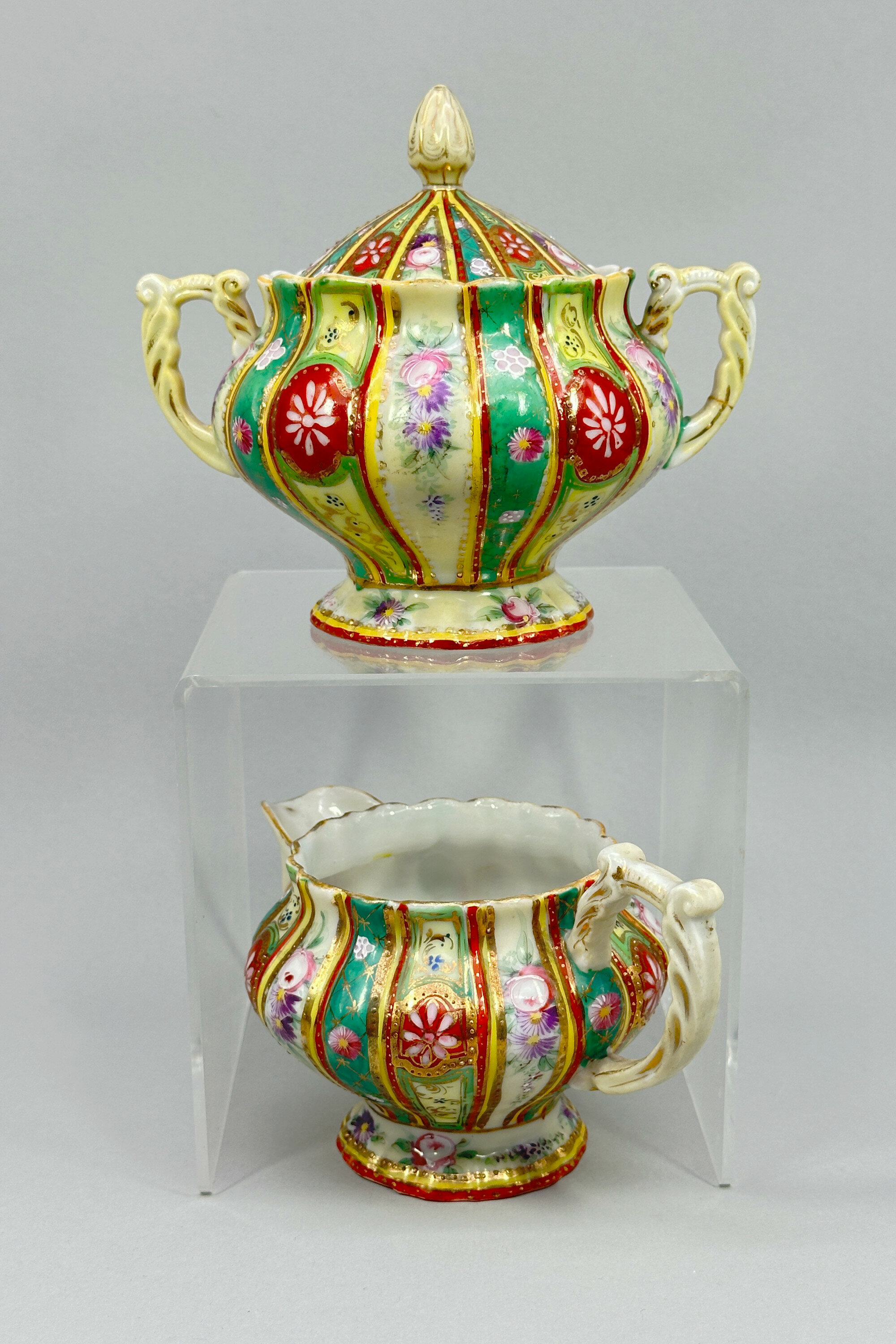
Vintage floral decorated Sugar Bowl and Cream Jug, probably Bohemian mid C20th
Price: £25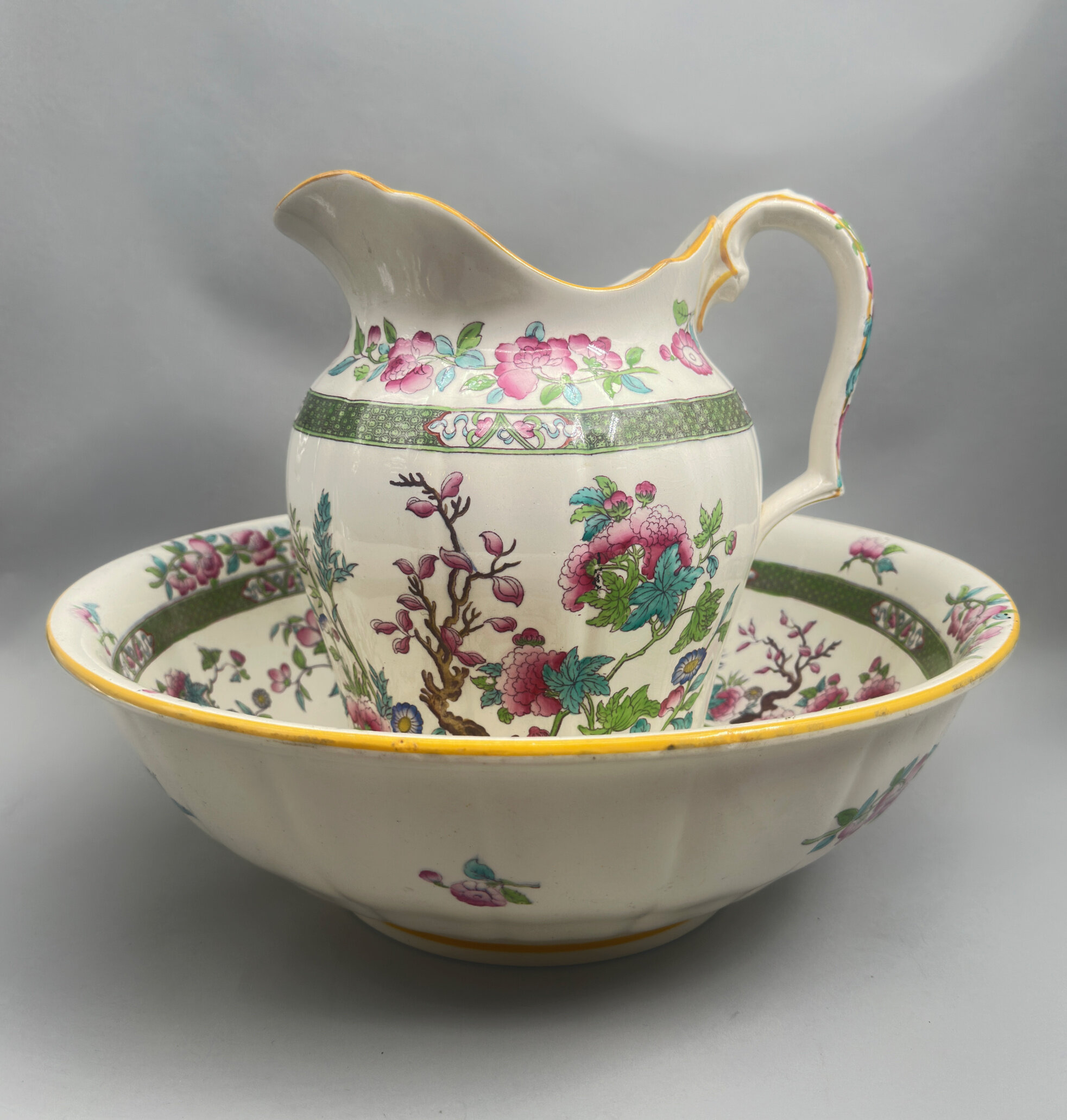
Minton Indian Tree Pattern Pitcher and Basin circa 1900
Price: £350………………………………………………………………………………………………….................................................................................
The celebrated firm of Mintons was founded by in 1793 by Thomas Minton (1765–1836) at Stoke-upon-Trent, Staffordshire, England as ‘Thomas Minton and Sons’, producing earthenware. The initial ranges were standard tablewares in blue transfer-printed or painted earthenware, including the ever-popular Willow pattern. By the mid nineteenth century and in partnership with Michael Hollins, Mintons began the production of decorative finishes for the interior and in particular floor tiles which enjoyed enormous demand and were the subject of numerous prestigious commissions including a contract for the flooring of the American Capitol. This was followed by the introduction of the plain white glazed ‘Parian’ wares and then the Italian inspired ‘majolica’ pieces with their richly coloured lead glazes. Mintons continued to follow popular trends, working with Christopher Dresser, recruiting Louis Solon from Sevres who had developed pâte-sur-pâte wares and finally contributing to Art Nouveau ceramics with a speciality in secessionist wares.
But the manufacture of tableware continued alongside all these other developments and Mintons adopted and adapted the popular ‘Indian Tree’ pattern which was first produced by Coalport in 1801. This design fused elements from Indian textiles and Chinese ceramics into an amalgam with immediate appeal. The pattern includes the crooked branch of a tree and a partial landscape including exotic flowers and leaves with a palette of colours emphasising green, blue, pink, and orange, resembling quite closely the Chinese export wares decorated in ‘Famille Rose’ enamels which had been exported to Europe in great quantities in the eighteenth century. Many of Coalport’s rivals, including Spode, Wedgwood and Royal Worcester produced their own versions of the design, but Mintons’ interpretation was held to be one of the most successful.
It was used by Mintons to decorate a variety of shapes, mainly dinner and tea wares, but the toilet pitcher and matching basin are seldom found in this pattern. Both the forms are extremely elegant, the pitcher with light fluting, a scalloped rim and a complementary handle, while the basin, also lightly fluted, employs simple lines with a turnover rim which follow the shape of a Chinese original. All the standard elements of the pattern can be seen, in particular the twisted tree, and the diaper work borders again reflect Chinese originals.
Both pieces are marked with the pattern number ‘T 216’ and a Minton stamp, the form of which allows fairly accurate dating. The globe topped by a crown with the banner ‘Mintons’ was used from 1873-1912 but ‘England’ was only added after 1891, giving a circa date in the late nineteenth or early twentieth century, probably around 1900. The original toilet set, which would have included the pitcher and basin along with, probably, a chamber pot, a soap dish, candlesticks and other accessories, was clearly a ‘deluxe’ item at the time and its quality is still apparent today when it can be enjoyed simply for its decorative appeal and as a reminder of a past era of grandeur.
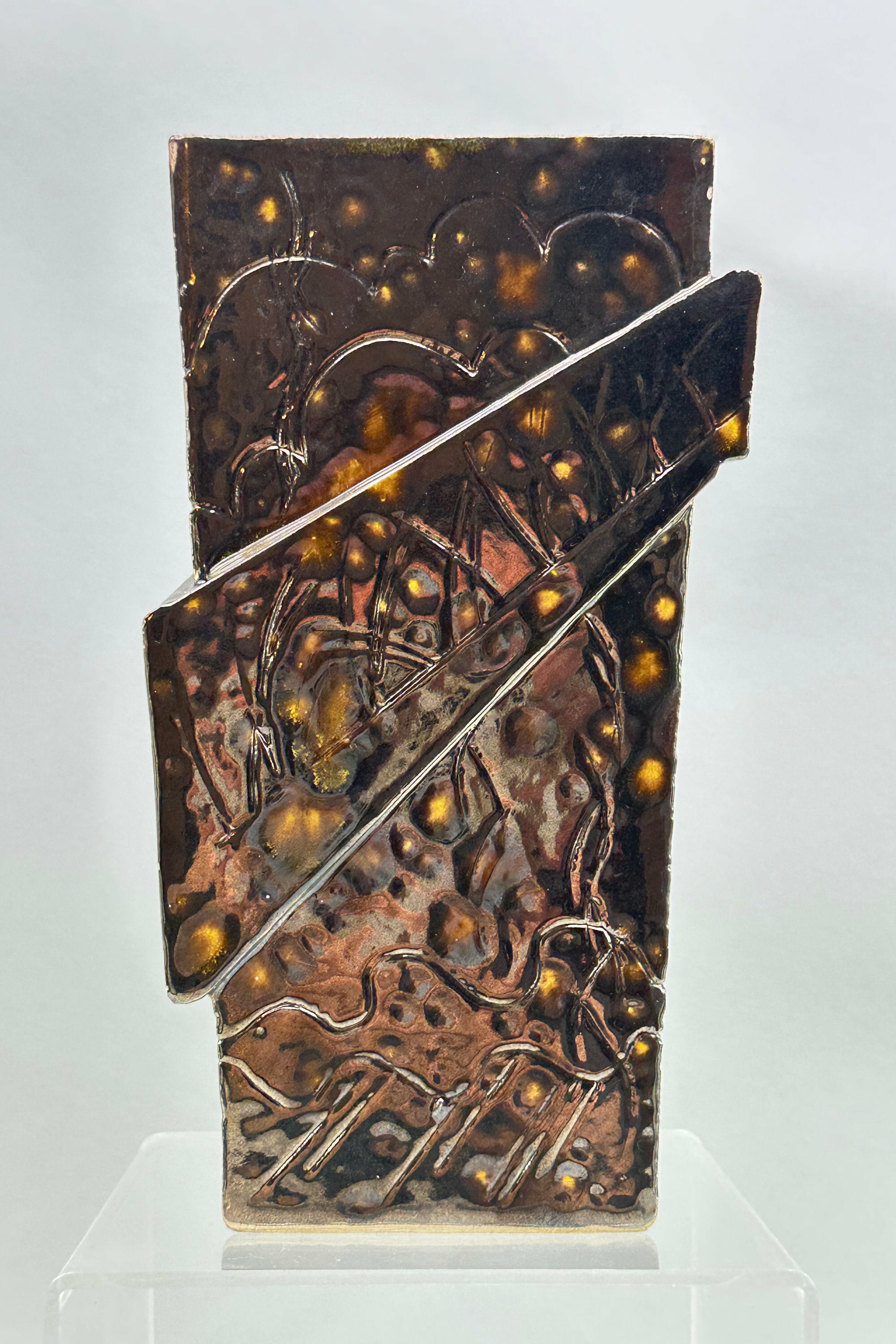
Art Deco Style brown lustre glaze triangular form Vase, signed, C20th
Price: £35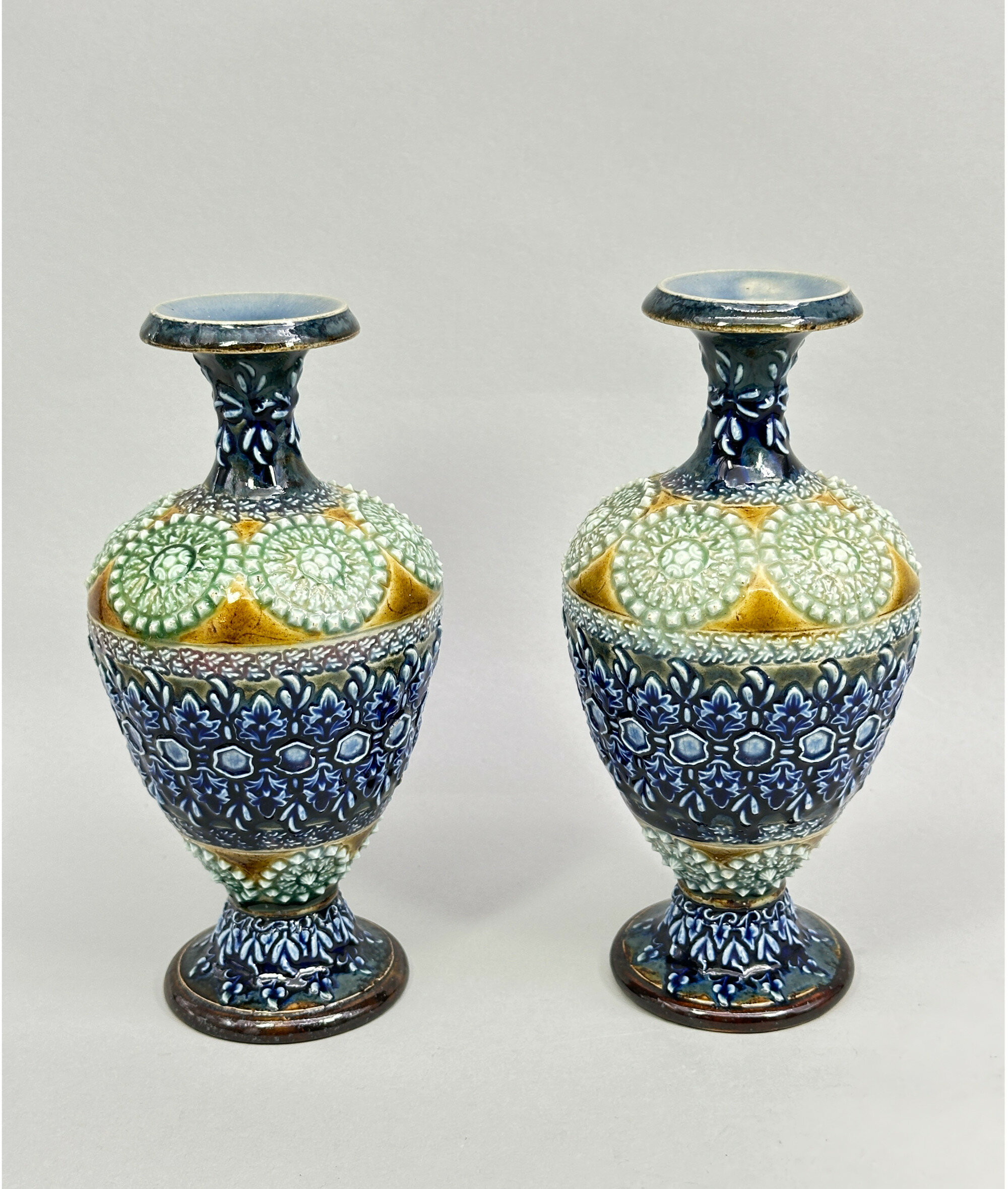
Pair of Doulton Lambeth Vases, signed and dated 1882
Price: £150The Doulton factory began production in 1815, first at Vauxhall and later moving to Lambeth. In 1882 it opened an additional factory at Burslem, Stoke on Trent in the centre of the English pottery. Known at first mainly for utilitarian works it began to develop decorative wares more extensively in the 1860s and soon gained a reputation for its distinctive designs. As the factory mark indicates, these pieces were made at the Lambeth factory and the absence of ‘England’ below it indicates that it dates to before 1891. The Lambeth ware pieces were often marked with the date of manufacture, here 1882 which is fully consistent with a design inspired by Eastern influence. The artist’s mark, ‘B’ with a tail, which appears on both pieces, is for Alice L Burlton, whose signature can be seen on other pieces of a similar date with similar raised decoration. The other three markings ‘B’ and ‘OO’ presumably indicate the pattern number.
In general, Doulton designs were often both striking an experimental and this pair of vases is an example of their work at its best, a striking form combined with skilful decoration making them true collector’s items.